
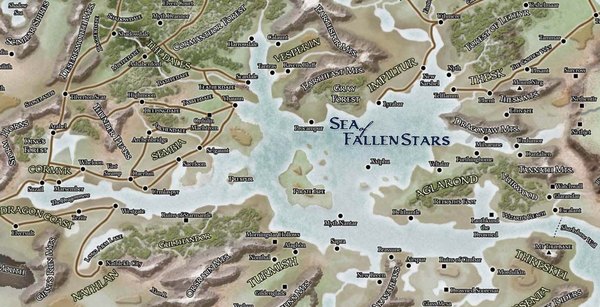
REGIONS
WATERDEEP / BALDUR'S GATE / LUSKAN (THE SWORD COAST)
AGLAROND
AKANUL / CHONDALWOOD
AMN / MURANNDIN / TETHYR / VELEN / WEALDATH
CALIMSHAN
CHESSENTA / TYMANTHER
CORMYR / WHELOON / STORM HORN, THUNDER PEAKS AND VAST SWAMP
THE DALELANDS / CORMANTHOR FOREST / DESERTSMOUTH MOUNTAINS
MOONSEA LANDS / THE GREAT GLACIER / THE RIDE
DAMBRATH / SOUTHERN LLUIRWOOD / AMTAR FOREST / EAST RIFT
DRAGON COAST / TURMISH / NATHLAN / GULTHANDOR
DURPAR / ESTAGUND / OKOTH
ELFHARROW / CHULT
GRAY VALE / ELTURGARD / EVERESKA / NAJARA
THE GREAT DALE / NARFELL / RASHEMEN / THESK
HIGH IMASKAR
IMPULTUR / VESPERIN
LURUAR / ICEWIND DALE
MOONSHAE ISLES / NELANTHER ISLES
NETHERIL/ SEMBIA
THAY / HORDELANDS
VILHON WILDS / ERLKAZAR
WATERDEEP

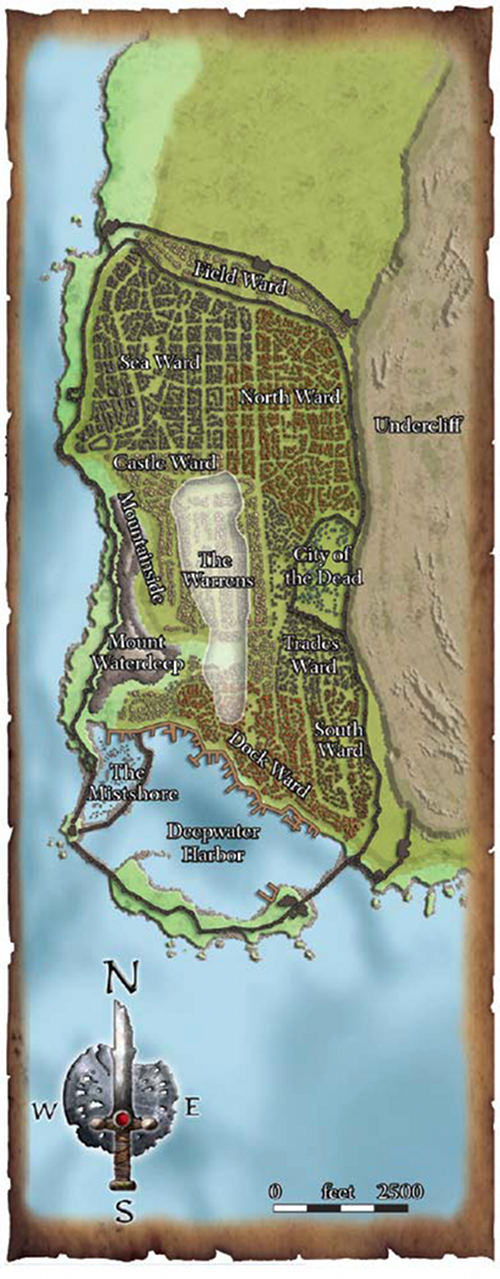
City of the Dead - The city’s graveyard sits along the eastern edge of Trades Ward, midway between North and South Wards. The place is used as a park during the day, and the gates are locked at night in case the dead rest uneasy.
The Mistshore - Over the last century, Deepwater Harbor has become badly polluted, its waters brown and stinking. The north shore of the former Naval Harbor became a scuttling yard for damaged or age-rotted ships. Over the years, these hulks piled up one atop another, spreading out from the shore at the foot of Coin Alley for a long way into the harbor to form the Mistshore. This area is a permanent slum of sagging, ramshackle woodwork atop the heap of sunken ships, where the disfigured, diseased and spellscarred of Waterdeep’s inhabitants dwell. The Mistshore is the darkest and wildest neighborhood in Waterdeep, where open violence and lawlessness is frequent and the Watch patrols seldom.
Mountainside - The name given to the new homes and streets that are slowly climbing Mount Waterdeep, mainly on its north and northeast faces. A street known as the Rise climbs north out of Fetlock Court and switchbacks as it ascends the mountain. The Rise is lined by tall, narrow, many-balconied houses that typically have four or five floors. Only wealthy folk build these stylish houses here. Events stemming from the Spellplague left a statue lying on its side on Mount Waterdeep, alongside the first doubling back of the Ride. A row of five luxurious stone manors, complete with balconies and hanging gardens, known as Downgiant Row, were built up out of the statue.
Undercliff - The largest new part of Waterdeep. It sprawls over the meadows east of the plateau occupied by the city, under the cliff that still forms its eastern edge. Undercliff is large, rather lawless, and still growing; it’s home to every sort of new arrival. Undercliff is the most fluid neighborhood of Waterdeep, where people move frequently, as shanties often collapse, are torn down or torched. Increasingly, dwarves dwelling in Field Ward who have made enough coin are seeking to buy houses in Mountainside, and on the cliff face above Undercliff, so they can tunnel out larger abodes at will. Their diggings have already breached some sewers and cellars in the city. Their activities are beginning to attractthe attention of the Masked Lords, who are now sending down hired adventurers to patrol the uppermost levels of Undermountain to stop the illicit delvings.
The Warrens - This district underlies a portion of northern Dock Ward and a large part of Castle Ward. It consists of 5-foot-ceiling rooms and suites opening off a few winding street tunnels. Home to many gnomes and halflings, the area is seeing an increasing number of dwarves. The district is in the process of expanding to the east, under the City of the Dead, to come out on the face of the cliff and into buildings there. Several of the new tunnels leading east from the present area of the district have collapsed and fallen down into Undercliff as a result. These new tunnels of the Warrens have disturbed some of the oldest burial sites in the City of the Dead. Despite the diggers taking care to return a breached tomb to its former state, some say the tunnels have become haunted. Indeed, many report eerie whispered words, apparitions, and incorporeal images of all sorts.
WATERDEEP REGION
Regional Benefit - Waterdeep: Add one language of your choice and 2 Ranks in Diplomacy skill
DESCRIPTION: The City of Splendors remains what it has been for centuries: a bustling, crowded, busy mercantile crossroads where coin is king and tolerance for other races and habits is high. Gossip is the grease that helps the daily lives of most Waterdhavians along in their endless striving to make ever more money. Waterdeep is divided into a system of seven wards or civic districts. Economic activity continues to be dominated by the city's many guilds. Street plans of Waterdeep remain almost identical with those of a century ago. The old maps are still pretty accurate. The city gates are customarily opened at dawn and closed at dusk. The streets are lit at night by city lamplighters. Wagon traffic is common. The nobility was hit hard during the Spellplague, most losing most of their wealth from the destruction of Neverwinter and Luskan in the north. Many nobles had to sell their villas to those of the merchant class who had better fortunes. Waterdeep’s navy has been scuttled, and the city relies on warships from Mintarn for defense. The City Guard is now part of the City Watch, serving as a permanent bodyguard for the Open Lord and the Palace. The famed Griffon Cavalry was dissolved years ago after the griffons perished in various battles and were never replaced. Aside from sharing facilities and personnel with the Guard, the City Watch patrols pass along main streets once between bells, varying their routes often. It’s rare for a patrol to have fewer than eight Watchmen. All Watch patrols are armed and carry horns to summon reinforcements. Waterdeep enjoys an often-noted golemwork clock called the Timehands installed in the tallest tower of the Lords’ Palace. It possesses three continually turning dials, facing north, east, and south. The clock has bells that strike the hours, beginning with a “pay heed” chord, followed by a deep bell tolling the hours by number. Timehands also sports an hour hand and a smaller hand denoting minutes. Waterdeep was spared many of the ravages experienced by other cities during the Spellplague. However, the event did introduce hundreds of glowing globes (floating, mobile spheres of continual radiance) that now drift freely around Waterdeep. Although they are not sentient according to the House of Wonder (arcane college, formerly a temple to Mystra), they behave uncannily as if they are. They seem to become curious, and for a random time, follow certain beings who are moving about the city; they always seem drawn to any release or casting of magic. Also, a few of the fabled Walking Statues of Waterdeep went wild, striding across the city until they collapsed, toppled, or got wedged between buildings. Most have been removed, but some still remain. One local change wrought by the Spellplague is that detection and location magic no longer functions in the region.
Castle Ward: Administrative District - Castle Ward lies in the heart of Waterdeep, wrapping around the eastern slopes of Mount Waterdeep. This ward is home to the city’s administrative buildings and buildings of state. City Watch and Guard patrols are heavy. The ward’s most prominent landmarks include Ahghairon’s Tower, Blackstaff Tower, Castle Waterdeep, the Lords’ Palace, the Market, the Cynosure, and New Olamn.
Dock Ward: Harbor District - Dock Ward is Waterdeep’s oldest and most colorful ward. The harbor is a working place, full of dockworkers and sailors loading and unloading vessels. Carts groan hastily between warehouses all over the southern half of the city and Dock Ward, carrying goods to and from the ships. Dock Ward is also notorious as a lawless, brawling place of drunks and smugglers. Notable landmarks of Dock Ward include Cookhouse Hall, Shippers’ Hall, and the Full Sails tavern.
Field Ward: Young District - Field Ward is a crowded area, newly built, between the North Trollwall (the old inner north city wall) and the outer north city wall (still anchored by Northgate). It was once the caravan camping fields. Neither wall has been torn down, leaving Field Ward fenced off.This district is home to folk of all walks of life who lacked coin enough to hire lodgings or own buildings in Waterdeep, and arrived as the ravages of the Spellplague began. It is a slum in some places, and a struggling middle-class area in others. The Ward is a noisy, lively area that’s home to poor (and a few wealthy) elves, half-bloods of all sorts (and anyone who has a deformity or visible taint), and dwarves determined to get the respect they are sure they deserve.
North Ward: Home of the Wealthy - Waterdeep’s quietest ward is also one of its wealthiest. North Ward is home to most of the middle class and lesser noble families and the Cliffwatch. This ward all but shuts down at dusk. This placid reputation belies the intrigue and scheming that goes on behind closed doors, and the volumes of smuggled goods that lie in cellars beneath the city streets. The only widely known landmark of North Ward is the Gentle Mermaid, whose fame as a gambling hall has spread up and down the Sword Coast.
Sea Ward: Noble District - Waterdeep’s most affluent ward is notable for the many-spired, grand homes of the nobility, the gleaming edifices of the city’s leading temples, and the imposing towers of its premier wizards. Lashed by sea storms, Sea Ward was traditionally deserted in the winter; the nobles preferred to weather the cold months in estates farther south. This practice has been largely abandoned over the last century, however, as strife erupted across the Sword Coast. Notable landmarks of Sea Ward include the Field of Triumph, the lush Heroes’ Garden, and the Sea’s Edge Beach. Waterdeep’s largest temple, the House of Heroes dedicated to Tempus, stands just north of the Field of Triumph.
South Ward: Working-Class District - South Ward lies in the southeastern corner of Waterdeep, bounded by Trades Ward to the north and Dock Ward to the west. Caravan City, as this ward is known, is a homely, friendly, busy, and largely poor area of Waterdeep. South Ward is dominated by large, tall, old warehouses made of stone, mud brick, or timber. Crowded among them are three- and four-floor tenements, most with shops at street level. Notable landmarks of South Ward include Caravan Court, Waymoot, and Metalmasters’ Hall, headquarters of the Most Careful Order of Skilled Smiths & Metalforgers.
Trades Ward: Center of Commerce - Trades Ward lies in the eastern half of Waterdeep, encircling the western and southern walls of the City of the Dead. Given over almost entirely to commerce it has the hustle and bustle of a marketplace throughout the day and night. Notable landmarks of Trades Ward include the Court of the White Bull and Virgin’s Square. The towering Plinth stands no longer, having collapsed during the chaos of the Spellplague.
BALDUR'S GATE
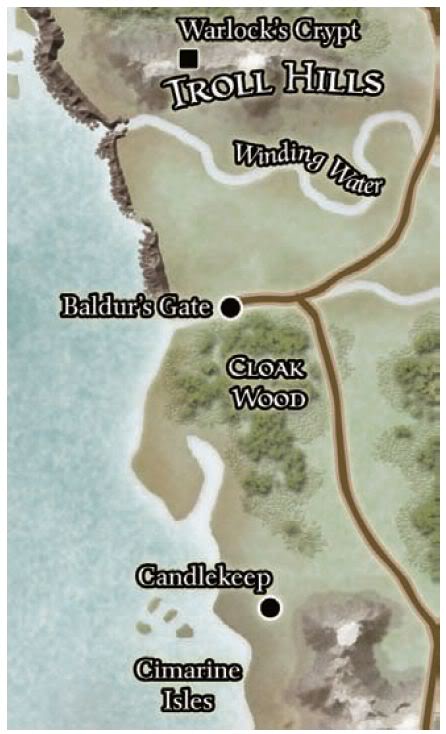
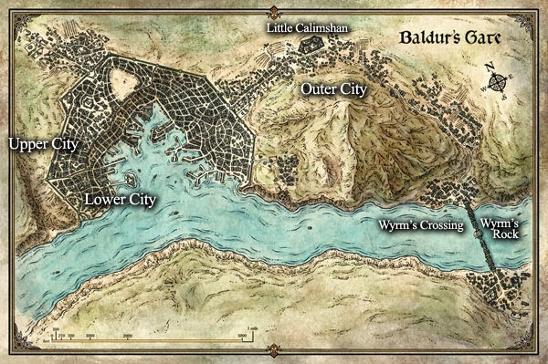
Candlekeep - This many-towered fortress stands on a slender volcanic crag 100 feet off the coast. Candlekeep preserves a huge library of Faerûnian lore, learning, and prophecy. The keep’s central tower is surrounded by beautiful grounds. A ring of buildings runs along the inside of the massive outer walls. The structures include guest houses, stables, granaries, a warehouse, an infirmary, a temple to Oghma, and shrines to Gond and Milil. The keep is ruled by the Keeper of the Tomes and First Reader, who are assisted by several Great Readers, many scribes and numerous apprentices. Visitors who bring a tome as their entry fee are allowed to stay for up to a tenday, during which time they can conduct research and have rare books copied for a steep price.
Cloak Wood - South of Baldur’s Gate, the Cloak Wood is a thickly overgrown, ancient forest that looms along the shore south of the Sword Coast. Unlike the cliffs to the north, the Cloak Wood’s shoreline theoretically allows a ship to moor and launch a small boat for water and supplies. In practice, only desperate mariners dare the wood’s nasty population of beasts, monsters, and vicious fey. The Cloak Wood once contained portals to several other parts of Faerûn but those passages are now defunct.
Werewoods - Formerly the Wood of Sharp Teeth, this forest lies just east of the Cloak Woods and is reviled by all in the region. Baldur’s Gate has seen a recent restructuring of its government. After the city nearly fell to Grand Duke Valarken and an external force of lycanthropes called the Band of the Red Moon, surviving Grand Duke Portyr instituted a parliament to better balance city power. It is said that after Grand Duke Valarken’s failed coup, he and his lycanthropic mercenaries fled into this forest.
BALDUR'S GATE REGION
Regional Benefit - Baldur's Gate: Add one language of your choice and 2 Ranks in Gather Information skill
DESCRIPTION: This sprawling city depends on the trade passing through its ports and gates to support its overpopulation. The only criterion for citizenship is a couple of silver pieces. Humans dominate the city, though elves, dwarves, and many others have settled here. Baldur’s Gate is a city anyone can visit. The city’s population is believed to have surpassed even Waterdeep. Baldur’s Gate is a prosperous city where just about anything can happen, and often does. It contains an active and organized thieves’ guild, powerful merchants with questionable ethics, and influential cults and secret societies. All the power groups maintain a precarious balance under the authority of the Flaming Fists, a former mercenary group that serves as the city’s police force, law enforcement, and protector. One can hardly spend an hour in the city without seeing one or more members of the Flaming Fists. Untouched by the Spellplague, Baldur’s Gate received an influx of refugees from the south that greatly swelled its population in the months and years following the disaster. Word soon spread that Baldur’s Gate was an “open city,” a safe haven for refugees from south of the Sea of Fallen Stars. The trickle of displaced people soon became a flood, and the city grew a population that doubled, then tripled in size. It is governed by Grand Duke Portyr, a fair man well liked, though not quite loved, by the citizens and a parliament. The heart of Baldur’s Gate lies within the old, high walls, but the city has spread across the River Chionthar and for miles in every direction. Built quickly and by the hands of refugees, the architecture is a hodgepodge of styles from all across Toril. Streets meander in a maze visitors find impossible to navigate. Most districts are named for what can be found there, namely the Docks East and West districts, Garden District, Merchnat Quarter, Riverside Slums, the Westland Gate district and the Bridge District across the Chionthar River.
Bloomridge: Wealthy Neighborhood - Bloomridge is contained on and within the old walls of Baldur’s Gate. The neighborhood extends down the side of the wall in swoops of stairs, galleries, and hanging gardens. It swarms with well-dressed buyers and discreet sellers. Architecturally pleasing shops are built in and around flower-filled arcades and open-air cafes. The wealthy and celebrated seek to buy one of the rarely available houses in Bloomridge, or failing that, to rent one of the small but expensive apartments built over popular shops and cafes.
Twin Songs: Temple District - Twin Songs is one of many temple districts in the city, and a small one at that. Because the city’s population is so diverse, this area hosts temples to powers with wildly different goals. Even shrines to evil gods persist unchallenged by the Flaming Fists. Twin Songs is wholly devoted to the divine. Here one can easily find temples willing to perform healing rituals for the appropriate price.

Blood Island - Blood Island holds the forces of a Shou criminal syndicate headed by a mysterious leader known to his cronies as the Dragon. From the ruined garrison, the gangsters traffic in slavery, drugs, and other unsavory commodities.
Host Tower of the Arcane - Once the home of the Arcane Brotherhood, this strange ruin is haunted by undead. Lesser creatures roam the area around the structure; greater threats are entombed below. The locals won’t go anywhere near it.
Neverwinter - The city that stood between Luskan and Waterdeep is no more, as The Crags rose out of the ground, ripping through the center of the town and taking the city upwards with it. Some brave souls seek profit by exploring the dangerous ruins left behind.
LUSKAN REGION
Regional Benefit - Luskan: Add 1 Rank in Hide, Move Silently, and Sleight of Hand skills
DESCRIPTION: The cesspool of the world, Luskan is a city stewing in its own rot. Once it was a thriving port anchoring the northern end of the Trade Way on The Sword Coast, but decades of rampant crime has left it largely abandoned. Now Luskan is the exclusive territory of rival street gangs, monsters, and vermin. A middle-class citizen of Luskan would be a beggar anywhere else.
Mirar River - The Mirar River is a stinking bog, choked with the old hulks of partly sunken ships and topped with a layer of rubbish, waste, and worse. No one crosses the river if he can help it; dire things lurk in the water, and the bridges that spanned it are long since smashed, their remains still protruding from the murk. The odor is so profound that few can stand to walk its shores for long before fleeing for the relatively cleaner air of the city.
North Bank - A former thriving merchant district, the North Bank has become a favored haunt of vile gangs and bands of undead. An old water tower still stands called The Throat.
South Bank - Sprawling out from the southern side of the Mirar River is the great slum known as the South Bank. Once the lifeblood of Luskan, it now is a graveyard of old dreams. Between the rotting buildings, narrow streets twist through the shadows cast by the burned-out and collapsed structures on all sides. Gangs and pirates control much of the South Bank, but reports of more monstrous masters occasionally filter out from the city.
AGLAROND
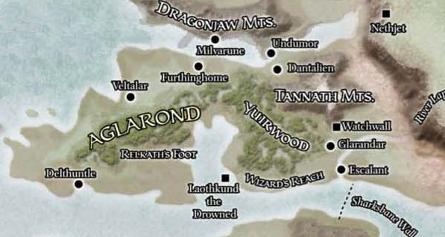
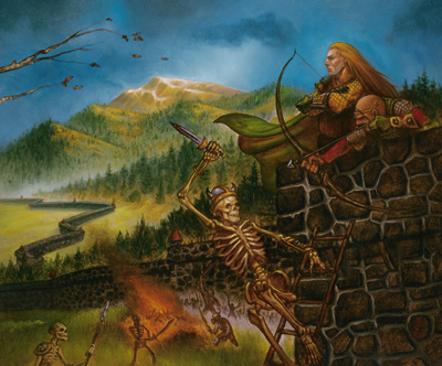
Watchwall: Southeastern Defense - The Watchwall is a massive, magically engineered stone wall stretching 15 miles from the fortress city of Glarondar to the slopes of mighty Umbergoth. The Watchwall overlooks the Umber Marshes, a morass of bogs, swamps, and mudflats run through with shallow streams that drain south. The Army of the Green Drake consists of a mere 350 troops stationed in Glarond Keep and along the Watchwall. Their numbers are so significantly reduced from their former strength that monsters out of Thay and the Umber Marshes are becoming bolder. Still, the threat along the Watchwall is considered minor compared to that from Undumor. Thus, troop levels remain low, as does morale.
Yuirwood: Peninsular Forest - Aglarond’s signature feature is the Yuirwood, a forest whose depths are a dangerous expanse of plaguelands and hostile fey. The wild tribes of half-elves and elves of the Yuirwood are suspicious of outsiders, including their fellow citizens living along the coasts. They dispute the rule of the Simbarch Council. The simbarchs, for their part, have made little effort to assert their authority over the denizens of the deep woods. Of more concern are the plaguelands hidden in the tangles of the Yuirwood. Ruins of an eladrin civilization litter the forest and seem to attract pockets of active Spellplague.
Laothkund the Drowned: The sinking waters of the Sea of Fallen Stars did not match the subsidence of the land beneath Laothkund. Now fish swim Laothkund’s silt-dusted lanes, and sea monsters inhabit its drowned towers. The dead city’s treasures yet lie in the cold depths.
Tannath Mountains: This range forms the southern edge of the Dragonjaw Mountains, south of the River Umber. The mountains are tall and rugged, flanked by wide passes. Griffons, giants, and stony beings more mountain than flesh inhabit the high peaks and steep slopes. Abandoned silver mines puncture the Tannath slopes, worked out and empty. However, rumor has it that the old mine shafts now serve as warrens for an extended tribe of opportunistic goblins.
AGLAROND REGION
Regional Benefit- Aglarond: Add Elven (or Fey, if already known) language and +1 Rank in Listen and Spot skills
DESCRIPTION: A land of open water and deep woods known as the Yuirwood, Aglarond is a nation of humans, elves, and half-elves on a broad peninsula thrust into the Sea of Fallen Stars. Elves and humans have intermingled in Aglarond for centuries—few natives can claim a pure bloodline one way or the other. No region in Faerûn has a higher half-elf population. Aglarond’s major cities lie on the coast near the nation’s most valuable resource, the sea. Most of Aglarond’s towns rely on ships for travel and trade. Some portions of the Yuirwood are shunned, for strange magic lingers in its depths. Aglarond faces threats from beyond and within its borders. Many residents maintain hope that the Simbul will return to deliver Aglarond from its enemies, but such hopes grow increasingly dim as dangers accumulate. In addition to the threat of an overt attack by Thay’s undead army, evils spawned under Thay’s influence find their way to the wilds of the Yuirwood.
Veltalar: Capital City - Population 70,000 - Aglarond’s capital, formerly called Velprintalar, is the nation’s chief port. The inhabitants followed the retreating coast as the Sea of Fallen Stars subsided late in the previous century. They left behind the older, narrower, jumbled buildings of what is now called Old Velprintalar to worsening slumhood. Aglarond is ruled by a council of fifteen simbarchs, all spellcasters. They meet in the old Palace of the Simbul, a mansion of pale green stone built upon a rise overlooking the city. The simbarchs inherited both the palace and their titles from the country’s former ruler, though their current positions required armed strife with outlying populations who were initially disinclined to be governed by the Council. The Stone Bears are notorious Aglarondon thieves based in Veltalar.Dantalien Citadel - The simbarchs constructed a fortress south of Undumor, directly across the wide Umber River. The massive citadel is continually seeking naive recruits, skilled adventurers, and mercenaries loyal to coin. The citadel provides basic training and equipment for raw recruits. Forces of untried city youths and battered woods folk, launched from Citadel Dantalien, join in the attempts to clear the undead threat from Thay and Undumor.Delthuntle - This city has emerged as a commercial power, extending enormous piers to follow the ocean’s retreat. Much of the city’s wealth comes from trade with Airspur, the capital of Akanûl. Delthuntle is host to one of the largest genasi populations living peaceably with humans and half-elves. However, a rising population of pirates patrolling the surrounding coast threatens the city’s peace and prosperity.Glarondar - Glarondar’s population has swelled from an influx of humans and tieflings fleeing Thay. The population now extends beyond what can be defended easily, and the Simbarch Council increasingly commits Aglarond’s military strength to Citadel Dantalien in the north, leaving the south vulnerable to beasts and undead.Undumor: Thayan Outpost - Aglarond’s grim fortress-city Emmech was lost to Thayan influence and renamed Undumor. This fortification at the mouth of the River Umber houses voracious monsters, vampire knights, and shambling corpses under the command of a necromancer.
AKANUL
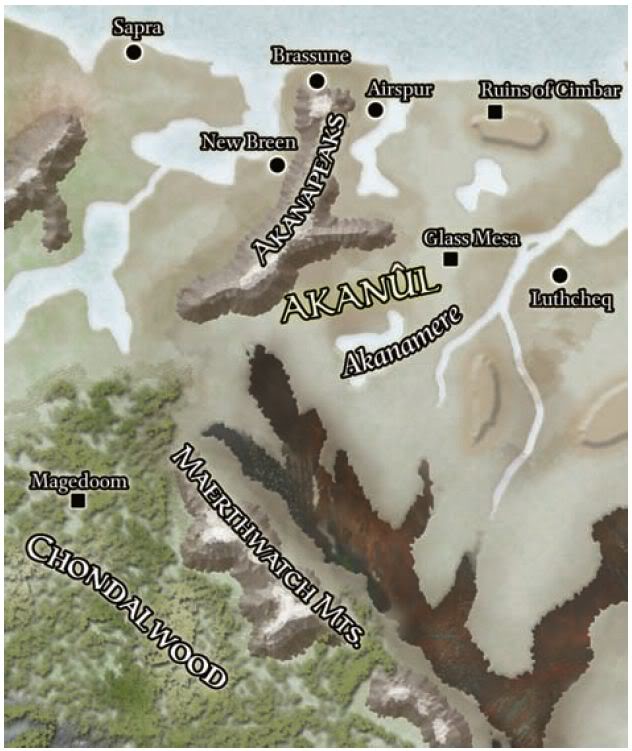
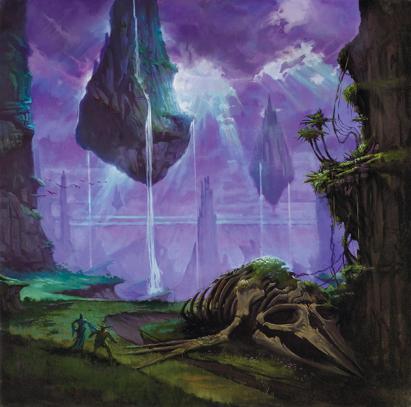

Chondalwood: Border Jungle - Akanûl doesn’t claim the Chondalwood, though it does regularly send foresters into the lush land. The tropical forest is a confusion of ravines and floating junglemotes,some sailing free, others webbed to lower regions by thick vines and vegetation. The Chondalwood’s vigor is impressive—it grew in the Spellplague’s wake instead of being diminished or erased. Its colonizing junglemotes spread like airborne seeds in all directions. Spellscarred satyrs and other fey roam the jungle. Above all else, plant creatures of every variety thrive in the deep wood. A once-sizable group of elves yet calls the Chondalwood home. Their nation has declined to a single extended territory called Wildhome. The elves declare blood feud on any outsider whose explorations threaten to reach the jungle’s heart.
Brassune Safehold: Firestorm Cabal Safe House - The Firestormers’ most famous safe house is located on the outskirts of Brassune, the city the genasi had first established in Akanûl and later abandoned. The Brassune Safehold is located on a large forestmote overlooking the tumbled, mist-shrouded ruins of the city. It is a defensible structure of stone, with dual lookout towers to warn against incursions from the ruins—attacks by kuo-toa servants of the Abolethic Sovereignty are frequent. Those interested in delving in the ruins of Brassune can’t find a better place than this to retreat and rest. The Safehold offers quarters, basic supplies, and hot meals for all who pledge loyalty to the Firestorm Cabal, regardless of lineage, although dragonborn are still shunned.
AKANUL REGION
Regional Benefit - Akanul: You gain 2 cold, fire, thunder resistance
Alternative Regional Benefit (must be Wild Elf, Ghostwise Halfling or Strongheart Halfling) - Chondalwood: Add +3 bonus to Hide, Listen, Move Silently and Spot skill checks while in Forest terrain
DESCRIPTION: This land is characterized by crazed stone spires, cavernous ravines, and cliffs like petrified waves. Free-floating earthmotes host miniature forests, grasslands, and lakes. Ever-replenishing waterfalls flow from watermotes to drape the land below in curtains of mist. The wild landscape seems perfectly suited to the tempestuous genasi who claim the land as their own. They breed several varieties of drakes to assist them in trade, transport, and war. A new nation formed in the devastated and warped lands between Chessenta and Chondath, Akanûl has overcome great adversity on The Sea of Fallen Stars and is now a name to be respected and feared. Akanûl’s capital and largest city, Airspur, holds the bulk of the population. Otherwise, the claimed territory is mostly frontier. The shattered ruins of Chondathan cities lie broken at the bottom of ravines or thrust high atop stone buttes, a constant draw to adventurers seeking troves of lost gold. Predators native to Abeir hunt shadowed lowlands, while ravenous abolethic horrors stalk the cloud-girdled northern skies, pursuing their own inscrutable plans. Wondrous suspension bridges are prevalent in Airspur and other areas. These connections run from cliff dwellings to sky-scraping towers and even to earthmotes. Thickly muscled, if slow, draft drakes pull conveyances across these bridge-roads. Simple carts compete with elaborate carriages for space on the swaying lanes. Akanûl is ruled by Queen Arathane in partnership with the four Stewards of Earth, Fire, Sea, and Sky. Arathane is considered a good and just ruler. Her throne is high atop a twisted spire above Airspur where each of the four Stewards holds his or her own tiny "thronemote.” There, the lords decide the fate of the kingdom. Each of the four Stewards has specialized responsibilities. Lehaya, Steward of the Sky, is also called the Lawgiver because she is charged with administering the laws of Akanûl. All give their allegiance to the queen, but if they together disagree with their monarch—by her late mother’s own decree—she must abide by their wishes. Some genasi hold the queen and the four Stewards in contempt for their failure to adequately secure the kingdom’s borders, against either the abolethic threat or the dragonborn of Tymanther. They formed the Firestorm Cabal, pledged to patrolling the northern and eastern borders of Akanûl, beyond the kingdom’s official defensive perimeter. It keeps its Motherhouse in Airspur and has smaller safe houses all around the kingdom. Average citizens see the Firestormers as national heroes, willing to risk all.
Airspur: Capital City - Population 30,000 - Airspur’s infrastructure, shops, and dwellings are incorporated into Akanûl’s wondrous landscape of elemental spires and earthmotes. In this threedimensional city, upper spires do not necessarily have a foundation on solid land (though most do). The city is patrolled by genasi riding well-trained war drakes. Airspur is home mostly to genasi. Representatives of other races also live here, usually craftspeople, mercenaries, or other specialized workers, but genasi also fill many of these positions and none but genasi ever act in leadership roles. Being a genasi in the city means never having to worry about falling on hard times.
New Breen - Rising up above the Bay of Akanûl, this city stands on an earthmote and is inhabited almost entirely by genasi. The city was created in the image of an Abeiran genasi city called Breen. Waters flow from an unseen source deep within the earth- mote, spilling in a perpetual mist into the sea below. The falls encircle an island neighborhood known as Lower Breen, which is a rich and thriving trading port. The island prospers as a gateway between the east and west.
Deepspur - Although most genasi of Akanûl have the windsoul manifestation, those who manifest other elements gravitate to Deepspur, a city built into the sheer cliffs that sink into a chasm in the Akanapeaks. The precious gems and metals found in the caves surrounding this city have made Akanûl rich, but of late, many genasi and other humanoids have disappeared from Deepspur without a trace.
AMN
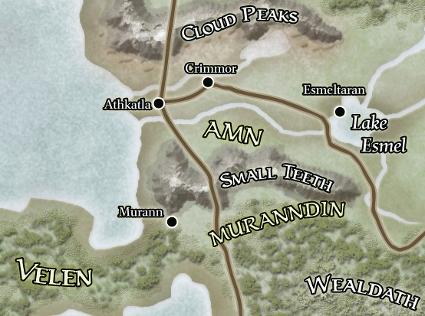
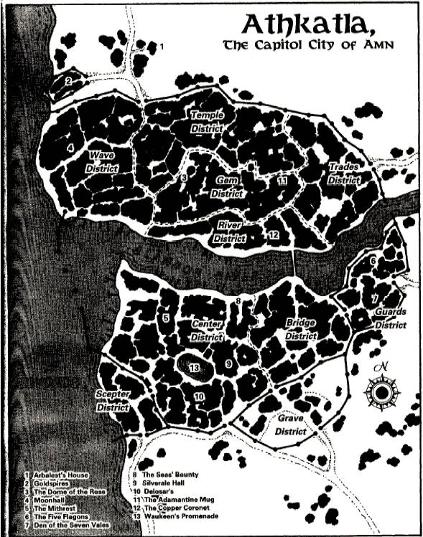
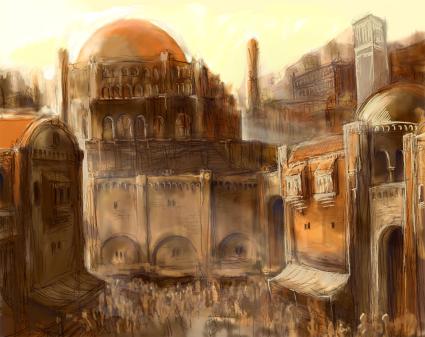
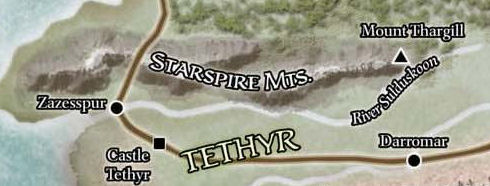
The Cloud Peaks: These mountains mark the northern border of Amn. Despite being home to dangerous creatures, they are mined for iron, precious metal and gems. A pair of steep crags known as the Fangs guards the Trade Way leading to the Sword Coast lands. Giants are sometimes seen scaling the crags as part of some ceremony or game.
Lake Esmel: This dark blue lake plummets to unknown depths in its central, southern, and eastern portions. Hot mineral springs flow in the western shallows.
MURANNDIN: South of Amn lies the monster kingdom of Muranndin, comprising the city of Murann, the Small Teeth, and portions of the northern Wealdath and eastern Dragon’s Head peninsula. This realm isolates the independent duchy of Velen from the rest of Faerûn and exacts tolls on all traffic along the Trade Way. Marauders from Muranndin roam all nearby lands. Slavery is common here. The monstrous conquerors of the city enslaved thousands of Amnians back in the 1370s, and many of the descendants of those unfortunates still serve the ogres, orcs, hobgoblins and bandits of the area. A human in Muranndin can fight his way out of slavery if he’s willing to show the orcs and ogres he’s as mean, nasty, and tough as they are. Orc and ogre chieftains, as well as black-hearted human bandit lords, maintain scattered strongholds and keeps here. Although all are theoretically subject to the dictates of the kingdom’s leader, the Great Mur, infighting and feuds are common.
VELEN: The independent duchy of Velen claims all the land comprising the Velen Peninsula.This small duchy takes a great deal of pride in its freedom. Politically, it has a reputation for conducting itself with honor, and it insists on the same high standards from its citizens and visitors to the realm. With enemies on all sides, Velen conducts most of its trade by sea in spite of constant threats by the pirates of the Nelanther Isles.
TETHYR: Directly north of Calimshan and south of Muranndin and the Wealdath is the kingdom of Tethyr. It sports fertile rolling plains, tall mountains, an expansive seacoast, and deep forests. Most of the country is made up of grassland, and most citizens of Tethyr live in settlements along major trade routes through these plains. This abundant realm is a feudal one. Knights ride the roads, and land is essential for status. Common folk are free, and many are members of powerful guilds. Counts select commoners as sheriffs to oversee local areas. The counts answer to dukes subservient to the monarch. Tethyr’s lands are settled along trade roads. The open plains are a treacherous wilderness. Tethyr was once a great forest inhabited by elves and home to Shanatar, an ancient and magnificent dwarven kingdom. Over the centuries, monsters of all sorts have ravaged the lands now within Tethyr’s borders, and the nation has fallen to armies from old Calimshan. More recently, civil war ended with the crowning of Queen-Monarch Zaranda and her consort, King Haedrak III, whose line remains on the throne. With the chaos of the Spellplague, Calimshan’s disintegration, and troubles with the monsters of Muranndin, the monarchy has weakened. Tethyr is too big to be ruled easily from Darromar, so dukes and counts have little help from the crown. Remote Velen, cut off by Muranndin, used this situation as an excuse to secede from Tethyr in 1423 DR. Queen Anais has had a troubled rule, starting with the machinations of her half-sister Evonne Linden, who made a play for the throne. In 1469 DR, all the queen’s nieces and nephews were slain in what has come to be called the Children’s Massacre—all except for her niece Ysabel, the only surviving heir to the throne. That same night, in a coordinated attack in another town, Evonne Linden was also killed.
Wealdath: Elven Forest - Population 100,000 - This woodland, whose name means “Unspoiled Woods,” is old and deep, but not particularly dense. Two major elf tribes thrive here, the Suldusk and the Elmanasse. These elves are closely allied with Tethyr because of the royal line’s agreement to respect the elven forest. Fey creatures also roam the forest. At least one portal into the Feywild lies in Wealdath. The fey have chased out gnolls, but groups of ettercaps, monstrous spiders, goblins, and ogres remain.
Old Shanatar: The dwarven land of Shanatar existed under much of what is now Tethyr. Darromar, Myratar, and Zazesspur, as well as Memnon in Calimshan, are built on dwarven ruins. Ancient tunnels, lost and sealed long ago, can be found under all these cities. They connect to Old Shanatar, an Underdark realm full of gray dwarves, drow, goblins, and kuotoas. Old dwarfholds are common in Tethyr, and ancient dwarven wealth, constructs, and traps await those bold enough to delve into Old Shanatar.
AMN REGION
Regional Benefit - Amn: Add 1 Rank in Diplomacy, Sense Motive and Sleight of Hand skills
Alternative Regional Benefit (must be Orc, Half-Orc, Hobgoblin or Goblin) - Muranndin: Add 4 Ranks in Intimidate skill
Alternative Regional Benefit (must be Human) - Velen: Add +2 to AC and attack rolls while defending a ship against being boarded
Alternative Regional Benefit - Tethyr: Add 2 ranks in Knowledge (nature) and 2 Ranks in any other Knowledge skill
Alternative Regional Benefit (must be Goblin, Hobgoblin, Wild Elf or Wood Elf) - Wealdath: You can travel across treetops with ease in dense forest terrain
DESCRIPTION: Amn is located to the south of Candlekeep and Baldur's Gate, at the southern end of the Sword Coast and the Sea of Swords. In Amn, everything has a price. Amn’s rulers have declared arcane magic to be illegal, except in the hands of spellcasters licensed by the High Houses. All others are denied the opportunity to level the magical playing field. From assassins and slaves to art and artifacts, the nation offers an indulgence or a vice for everyone. The laws can be strict for those without a coin or two for the right bribe at the right time. Humans and halflings comprise most of Amn’s population. In Amn’s eastern cities, the halfling population has grown dramatically, and many humans resent this change, especially as members of the smaller race gain increasing wealth and power. Rebellion simmers constantly among Amn’s numerous disaffected and disenfranchised, many of whom are halflings. Nonetheless, Amn is a place where respect and reputation can be bought, regardless of race. The exceptions are many of the monstrous races, which have become reviled since the rise of Muranndin, a monster kingdom that lies to the south. The High Houses maintain a bounty on the heads of trolls, ogres, and giants. Although Amn as a nation is distrusted, the majority of the population is honest, seeking only to carve out a small piece of the land’s fortune. Because strict laws work against the people who can’t afford to purchase justice, many in Amn resent the corrupt rule of the High Houses. Five wealthy and powerful merchant houses control Amn. These so-called High Houses form the governing Council of Five, which has complete authority over the nation and keeps a close check on all mercantile and military activity. Through the efforts of the council, Amn has amassed a formidable fleet of ships to guard and transport goods across western Faerûn. Amn is widely disliked, but it has avoided major conflicts through a combination of scheming, intimidation, and pragmatism. Despite its harsh reputation, Amn is a civilized and developed country. The High Houses ensure that roads are maintained and kept safe for commercial use. However, Amn also contains a few places that even the High Houses avoid.
Athkatla: Capital City - Population 100,000 - This capital city is the golden heart of Amn, so far as the country’s wealth goes. Athkatla might be home to some of Faerûn’s richest citizens, but the city’s core is rotten. In a place with enough coin, morality dies. Anything goes in Athkatla. What is considered illegal, immoral, or despicable in other places passes without comment in this so-called city of sin if the price is right. Lewdness, slavery, and even less savory acts such as murder occur here, as in any large city. But in Athkatla, the law permits almost anything. The only illegality is speaking or acting against a merchant house. In all other cases, the response to an offense is a fee, whose size depends on the degree of inconvenience to the other party. Once the fee is paid, the act is not considered criminal—only not paying is seen as unlawful behavior. Gold flows freely in Athkatla. One of the busiest ports in all Faerûn. Ships from places near and far dock in the city, transporting exotic vegetables, slaves, jewelry, strange relics, pirate booty, and more. Athkatla’s marketplace might even overshadow Waterdeep’s. Above the bay is Goldspires, a temple to Waukeen nearly as large as a small town. Popular shops include Tiny Deaths (poisons), the Museum of Inquisition (torture equipment), Lowmarket (slaves), Faded Ages (memory tailoring), Odd Candy (sweets . . . ?), and I Change (body modification). Enjoy your stay.Crimmor: Caravan City - Population 40,000 - The “caravan capital of Amn” is a fortified mustering point for practically all trade heading northward by land. The Shadow Thieves openly headquarter in Crimmor because it is the one city where they do not practice their trade. Indeed, they ruthlessly stamp out any freelance thieves. Crimmor bristles with inns, taverns, and festhalls serving the numerous caravanners and adventurers who pass this way.This city attracts wealth, opportunity, and danger. Northerners are constantly coming and going, making the city one of Amn’s more diverse. Bandits and pickpockets who do not ally with the guild known as the Shadow Thieves face a grave threat from the domineering organization.Esmeltaran: In recent years, halflings have become the dominant portion of Esmeltaran’s population. Many displaced halfling refugees fled to this city and began new lives. Under their influence, the city is now thriving and has become home to a renowned adventuring company known as the Blazing Swords.Velen: Capital City - Population 16,000 - The forested realm of Velen's only major city is that from which the region takes its name. Great walls of burnished, copper-colored stone fortify Velen, protecting it from pirates and monsters alike. The wharf contains several hidden defenses against privateers, including great submerged chains that can be raised to hem in and limit the mobility of attacking ships. Ghosts are somewhat common in the city, sometimes seen stalking the high walls after dark and are something citizens have learned to ignore, despite the fact that no one really knows their origin or true nature. Duke Calchais rules from a small, tidy castle that has been in his family since the days when the dukes and duchesses of Velen answered to the Queen of Tethyr.Darromar: Capital City - Population 100,000 - This beautiful city stands on the northwestern bankof the River Ith. From Faerntarn, her palace on theIthal Crag overlooking the city and river, Queen Anaishandles royal dealings. She maintains a huge militaryforce in Darromar, five days’ ride from any point in theland. Queen Anais takes the advice of the Royal Council, which includes seventeen-year-old Ysabel Linden. Overseeing the city is a lord mayor whom thequeen appoints every three years. The lord mayoradministers the needs of the city, deals with cityguilds, and commands the fine Darromar Watch. Under the queen, the lord mayor, and the standing military, Darromar is a safe and efficient city. Darromar also holds the wizards’ academy Black Towers, a huge market for mercenary work, and an underground of thieves. Extraordinary and odd folk come to Darromar for magical learning. Adventurers and sellswords come for work fighting the realm’s many monsters. And despite the prominence of the Shadow Thieves, Darromar’s underworld offers ample opportunities for the morally lax.Zazesspur: Port Metropolis - Population 100,000 - Once the nation’s capital, Zazesspur is a mixture ofTethyrian and Calishite culture. The great port, inwhich almost any item can be purchased, sprawlsaround the mouth of the River Sulduskoon. It’s amajor source of goods and materials for Tethyr, aswell as a departure point for sea trade. A group ofnobles known as the Council of Lords rules the city,but guilds and the Shadow Thieves have great influence here. Zazesspur also houses most of Tethyr’sgnomes and their leader, the Samnilith.Mosstone: Wilderness Trade Town - Population 3,000 - Mosstone stands under the boughs of the great treesof the Wealdath, north of Zazesspur, a walled trade town along the Trade Way. Caravanmasters coming from the north welcome the sight of the Wealdath as a sign of relief from the tolls of Muranndin. They view the sun-dappled gates of Mosstone as the first real shelter along the road after the trials of that monster-infested land. Most people here make their living working in services that cater to merchant traffic. They all place great importance on living in accord with the surrounding forest and the elves of the Wealdath. This is because druids maintain a powerful circle here, ruled by the Archdruid of Mosstone, whose grove surrounds the Great Oak of Mosstone. The town is ruled by consensus, and the townsfolk watch out for the needs of their fellows with a generosity unheard of in most lands.Riatavin: Metropolis - Population 80,000 - An Amnian city that seceded to join Tethyr in 1370 DR, Riatavin has been the major spur of trade between the Dragon Coast and the Sea of Fallen Stars. Riatavin is unusual in Tethyr in that a group of merchants, the Chosen Council, runs it rather than the nobility. Faith in Waukeen is primary in the city, and a number of powerful arcanists also have had influence here since the days of secession. Shadow Thieves have controlled the illicit side of the city for centuries. Riatavin and its lands have suffered greatly under the threat of bandits from Erlkazar, just across the river. The city’s population has dwindled over the years, leaving parts abandoned or full of desperate souls.Saradush: City - Population 35,000 - Saradush has suffered decline since the days of the Spellplague, even though it remains a main passage to the independent city-states in the Lake of Steam region. The city lies in the foothills of the Omlarandin Mountains, and rolling farmlands surround it to the west. Saradush is the source of Omlar gems, useful in some rituals, that come from the mountains.
CALIMSHAN
CALIMSHAN REGION
Regional Benefit - Calimshan: You gain 4 Fire Resistance and +5 to Constitution checks made due to thirst

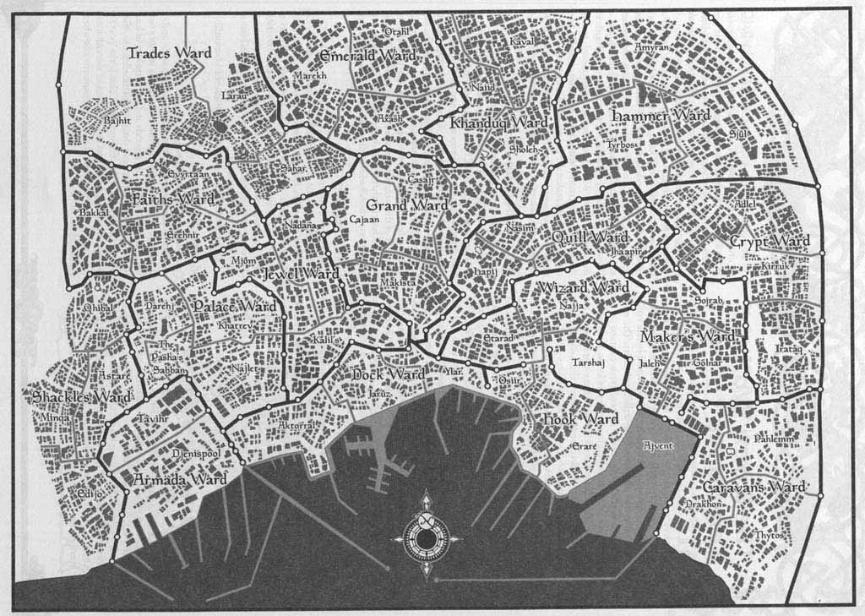


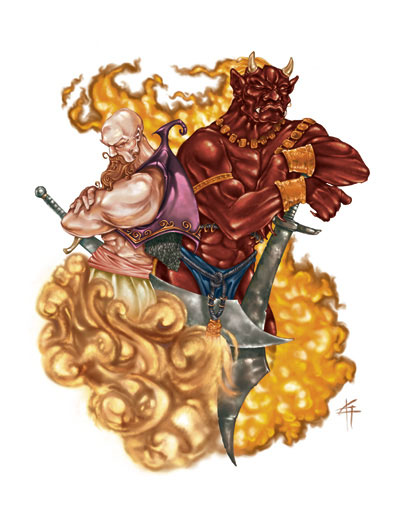
Calim Desert: This expanse of sand, salt, and rocks is the blasted battleground of the efreet Memnon and the djinn Calim. They are now gone, but the desert remains. The sands hide the ruins of great cities, some thousands of years old.
Marching Mountains: This forested mountain range is home to orcs and ogres that routinely raid Memnon’s mines in the area.
The Spires of Mir: Calimshan has changed in more than population and politics. This area, once a lush woodland known as the Forests of Mir, now stands as a stark reminder of the changes wrought by the Spellplague. The trees are gone, replaced by enormous stone spires rising hundreds of feet. Dangerous plaguechanged creatures roam this stone forest on the northern side of the Marching Mountains.
The Plain of Stone Spiders: Formerly the Spider Swamp, this area dried up with the expansion of the Calim Desert. The native creatures were infused with elemental magic, or perhaps were plaguechanged; either way, they now have limited control over their rocky environment.
Suldolphor: This once-vibrant city of almost 150,000 souls is now a stretch of sand-blasted ruin where efreets battle djinns in an endless cycle of mad violence. Its streets, buildings, and palaces lie buried only feet beneath the sweltering, ever-moving dust of the Calim Desert. City features sometimes appear in the wake of a strong sandstorm, only to vanish again in the next battle. Vast treasuries are rumored to be hidden there.
DESCRIPTION: Calimshan is located between the Trackless Sea and the Shining Sea. It is south of the Sword Coast, Amn, Velen and Tethyr, and north of the Mhair Archipelago. It lies just west of the Lake of Steam and the old region of Shaar which is now in ruins. Home to genasi and their human slaves, Calimshan is engaged in a civil war for control of the harsh desert of the Skyfire Wastes. A second Era of Skyfire once again pitted the forces of Calim and Memnon against each other. As during previous battles between these ancient foes, fell magic was employed that drained the life from the landscape. The sands of the Calim Desert spread east during the decades-long conflict, consuming the once-fertile Schamedar Plains and the fetid Spider Swamp (present-day Plain of Stone Spiders). Even the beautiful city of Suldolphor now lies in sand-blasted ruin along Talagath’s Gauntlet. Almraiven is the lone human bastion in this war-torn land of efreets, djinns, and their genasi servitors. Calimshan is a desert ruled by battling genasi who keep human slaves. The overlords wage constant war against each other across the dune seas and in the high air. Untold treasures await any brave enough to venture into the war-torn badlands of the Calim Desert, also called the Skyfire Wastes. Calimshan is unthinkably ancient; before the Spellplague, it was the oldest of all human lands.The headquarters of the warring genasi factions are the cities of Memnon and Calimport. The human population of both cities serves as slaves and as fodder in the constant battles. Only the city of Almraiven, still rich in magic and well defended, remains under human control. Indeed, it is the last bastion of human rule in Calimshan. Calimshan’s unforgiving desert can sear the skin and strip the bones of the unwary traveler. When the Calimemnon Crystal shattered during the Spellplague, it released the djinn Calim and his rival, the efreet Memnon, to resume their millennia-old war, ushering in the Second Era of Skyfire. Calim and Memnon overthrew Calimshan’s government and marshaled forces of efreets, djinns, genasi, and human slaves. What was once a prohibition against elemental races became an open invitation to any who would offer allegiance. After many years of war, without warning or reason, the two great entities disappeared again. But strife between their followers, the genasi, did not end.
Calimport: City of Calim Loyalists - Population 60,000 - Calimport is known for exotic goods, black markets, and its thriving slave trade. Many slaves are slated for a short life in one of Calimport’s two deadly arenas. Its population greatly diminished in the Second Era of Skyfire, Calimport is controlled by genasi who have enslaved the remaining human population and wage constant war against Memnon. The city contains large palaces taken over by genasi and their retinues, extensive slave markets, and two great arenas where human slaves are pitted against each other and against threats from the Elemental Chaos. The slave brand of Calimport is infamous—a stylized gust of sand-laden wind. Human slave stock has dwindled over the years. As a result, the genasi have begun to employ the services of slavers from other lands to collect fresh merchandise for the Calimport slave block. Expanding such operations risks the ire of northern nations, so slavers range east and south. This situation of course puts a premium price on slaves of northern stock.
Memnon: City of Memnon Loyalists - Population 35,000 - Founded by the army of the efreet Memnon, this city reveres the entity from which it takes its name. The genasi of Memnon followed Calimport’s lead and enslaved the remaining human population, finding the people to be useful pawns in their war against the hated followers of Calim. The city’s outer walls are made of a dark, smooth rock that absorbs heat and shrugs off wear. This same dark rock is mined to the east, in the Marching Mountains, and those slaves who can be spared from the war effort toil in the mines. The life of a slave miner is brutal and short. Memnon has been transformed from a city of clay and stone into a magnificent metropolis of glittering palaces and verdant villas. The influx of exotic and valuable goods has made Memnon a tempting target for foolhardy thieves and bold adventurers.
Almraiven: Human Bastion - Population 38,000 - Prior to the genasi uprising, Almraiven was the premier center for magical study within Calimshan. Because the Spellplague left the spellcasters of the city relatively unharmed, they were able to defend it from the genasi rebellion that overthrew human rule in greater Calimshan. The WeavePasha of Almraiven is sworn to protect his city from the endless wars of fire and air, but he’s barely holding the place together. If the citizens understood how tenuous is his hold on the peace, they would flee as fast as they could. The WeavePasha’s policy is to expand trade with and gain allies among other seafaring nations, while keeping Almraiven from the attentions of its genasi enemies. The WeavePasha sometimes sends agitators and Akanûl expatriates to stir up trouble in either Calimport or Memnon, laying the blame at the other city’s doorstep. Some humans who escaped the clash of Calim and Memnon fled to Almraiven. Almraiven’s arcane tradition bolsters its defenses, and an arcane college recently founded by the WeavePasha assures the city’s continued attraction for young apprentices.
CHESSENTA

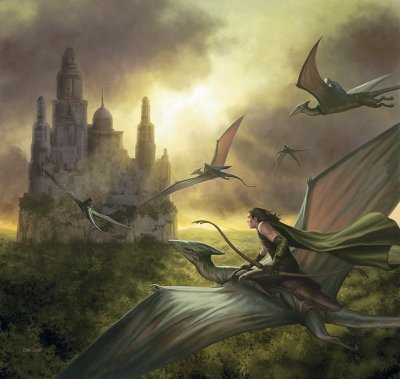
Mordulkin Ruins: The ruins of Mordulkin lie northeast of Luthcheq, though the place has been so long devastated that few in the capital remember the city’s existence. From time to time adventurers explore the ruins, hoping to uncover long buried treasures. From such disreputable sources comes the tale of a small refugee encampment composed of Luthcheq natives on the run, mostly arcanists who refused to bow to Luthcheq tradition.
The Smoking Mountains: One of the Smoking Mountains periodically erupts, raining down hot ash for miles in every direction. A number of eyewitness accounts describe one new and surprising discovery uncovered by a recent eruption: sealed adamantine gates a hundred feet high in the mountain’s side.
Sky Riders: Volcanic activity beneath the Methmere has caused the mountain range known as the Sky Riders to become shrouded in a perpetual mist that rises from the lake at the base of its eastern slopes. In recent years, many have reported strange noises emerging from the mist; high, piercing keens that chill the blood.
Flooded City of Soorenar: Water has swept into the streets and buildings of Soorenar, erasing all trace of the city’s inhabitants. Some of Soorenar’s high rooftops rise above the water level, offering scarce pieces of solid land in the drowned city. Much of Soorenar’s mercantile wealth likely remains in the water’s depths.
THRESKEL: Situated north of Chessenta, on the Sea of Fallen Stars directly south of Aglarond's Yuirwood. Mount Thurbane looms over these lands. This once dormant volcano has awakened, sending plumes of thick ash to blot out the sun in the surrounding countryside. One creature, the vampiric green dragon Jaxanaedegor, has welcomed this change, for he now has free rein to travel the nearby lands day and night and is the self-proclaimed ruler of the area.
TYMANTHER: Tymanther is the realm of the dragonborn, a fragment of an old nation in a new place. Though draconic humanoids are not novel to Faerûn, the dragonborn are a distinct race with thousands of years of history, culture, and myths all their own. More than anything else, Tymanther dragonborn are a martial folk, toughened by generations of fighting dragons. The interloper nation of Tymanther squats atop the ruins of Unther, dominated by the citadel-city of Djerad Thymar. The dragonborn citizens of this new nation are a proud race of warriors, known for their hatred of dragons and their ilk. The bulk of the dragonborn population in Tymanther resides in Djerad Thymar. Built to hold off a flight of attacking dragons, Djerad Thymar has become a sight renowned throughout Faerûn for its incredible size, unique shape, and impenetrable architecture. Tymanther lies on the western shore of the Alamber Sea, nestled between Chessenta and the Shaar Deso- lation and threatening landscapes such as the Black Ash Plain. To the east, across the waters, lies High Imaskar, and to the west is the gaping Underchasm. Tymanther’s only significant settlement is Djerad Thymar. The heart of Tymanther’s military strength lies in its highly trained army, the Lance Defenders. They train with lances, among other weapons, both on foot and mounted on the great bats sheltered in the Lance Roost. Most citizens of Tymanther spend two years as Lance Defenders. Tymanther (and Djerad Thymar) is ruled by Vanquisher Tarhun. A vanquisher (a cross between monarch and general) shows fitness to rule by rising through the military ranks over a period of at least twenty years, and is finally promoted by general acclaim of military peers. A new vanquisher, always a dragonborn, is chosen every ten years. A vanquisher usually has at least one dragon head in the Hall of Trophies to his or her credit.
Black Ash Plain: Interwoven ashen spires move across this wasteland like slow and solid dust devils. Stone giants native to the area have learned to predict, and in some cases direct, the movement of these landforms as they slide and weave across the landscape.
Ruins of Messemprar: Once a large city, Messemprar was precipitously drowned. Now the ruins are the haunt of bloodthirsty sahuagin. Portions of Messemprar’s taller buildings yet peek above the water.
Ruins of Unthalass: The dragonborn land didn’t so much exchange places with Unther as fall on it. Thus the old capital remains, buried and dead, but accessible to explorers.
CHESSENTA REGION
Regional Benefit - Chessenta: +1 to "to hit" rolls with melee weapon for the first attack after the initial one - your second attack roll in a round
Alternative Regional Benefit - Tymanther: +1 to damage rolls in combat when using a polearm from a higher elevation than your target and this bonus increases to +2 while on a mount in flight
Description: A land of tenuous alliances and isolated pockets of civilization, Chessenta fights to remain stable and prosperous. The nation’s existence hinges on the success of a few cities and settlements, and its people have been hardened by internal strife and external threats. Chessenta strives to set aside regional differences under a banner of mutual perseverance. Large pieces of Abeir fell in Chessenta, altering the landscape and setting off a series of devastating volcanic eruptions and earthquakes. Even today, much of the land remains impassable, and roads are few and far between. Chessenta ceded its western lands to the genasi of Akanûl. Nonetheless, out of crisis emerged a new, stronger Chessenta, united against a seemingly hostile world. Since the cataclysmic events of the Spellplague and its aftermath, Chessenta’s population has been confined to sparse pockets. Its communities are swollen with immigrants from Chondath, Unther, and Mulhorand. Originally a human nation, Chessenta has grown diverse in the past century as refugees have flocked to the nation. Bordered on the west by the genasi of Akanûl and on the south and east by the dragonborn of Tymanther, Chessenta hosts many traders and warriors of both races. This racial diversity has only strengthened Luthcheq’s traditional suspicion of arcane lore—a suspicion now focused on High Imaskar. Spellcasters in Luthcheq can expect a swift execution unless they agree to have green tattoos applied to their palms to mark them as practitioners of their craft. Chessenta remains devoted to a tradition that honors the strongest and bravest warriors. The hero Ishual Karanok has gained a godlike status in the past century since his heroic actions united the Chessentans. Descendants of ancient Imaskari slaves, the people of Chessenta are obsessed with physical conflict. They value their war heroes highly, hailing them as celebrities and potential rulers. Chessenta’s national enmity is focused mostly on the resurrected nation to the east, High Imaskar. Despite half the nation being devastated by a cast-off piece of Abeir, elements of the former Chessenta survive and even prosper. Although many Chessentan cities were destroyed in this tumultuous transposition, others survived.
Luthcheq: Capital City - Population 38,000 - Luthcheq is the self-proclaimed capital of Chessenta on its western border near Akanul. The city sits against sheer cliffs, making its geography as abrupt and intimidating as its people. Luthcheq upholds the traditional Chessentan ideal of living by the sword, a tradition bolstered by the city’s renowned War College. Luthcheq stands in the lee of a great cliff-face, half of its squat structures partially embedded in stone. Warlord Shala Karanok’s seat of power is the War College, which juts from the face of the cliff overlooking the city like the prow of a mighty ship. Chessentans’ distaste for Imaskar extends to all uses of arcane magic. Known wizards, warlocks, and other arcanists face execution by burning unless they agree to have their palms tattooed with special green sigils that identify their disreputable art. Rumor has it that the marks prevent their bearers from casting spells if they do not know their own particular tattoo’s “password.”
Djerad Thymar: Capital City - Population 30,000 - The citadel-city of Djerad Thymar is visible for miles. Indeed, the cyclopean structure’s vast, pyramidal silhouette looms like a mansion of the gods on earth. The city’s lowest foundation is a massive block of granite that rises at least 200 feet above the surrounding land, the surface of which serves as Djerad Thymar’s lowest street level. The citizens refer to this district as the Catacombs for the tunnels that wind through the foundation block. Resting on this foundation are hundreds of massive stone pillars, each 50 feet in diameter, that support an enclosed, four-sided structure vaguely resembling a pyramid. However, the four walls do not rise to a point, but rather to a flat, upper level exposed to the elements. This is the City-Bastion, where the bulk of the city’s dragonborn live. The open spaces between the pillars form the Market Floor. The combined height of the foundation, the pillars, and the enclosed City-Bastion contribute to a structure that towers more than 1,500 feet into the sky.
Djerad Thymar: Catacombs: This area houses the crypts of the dead, as well as copious siege supplies, foundries, and various machines of war such as ballistas, catapults, and other equipment designed more for piercing dragon scales than castle walls. Grand funeral rites sometimes wend through these tunnels for days, when heroes or other beloved individuals perish. The dragonborn adorn themselves in white ash and sing deep songs commemorating the fallen.
Djerad Thymar: Market Floor: This level is a wide-open bazaar of both permanent and temporary structures for trade, commerce, and entertainment. Farmers haul their produce up the Great Ramp to the Market Floor daily. The Market Floor also serves as the festival hall, site of monthly Grand Balls. Visitors are always welcome to attend these joyous occasions in which the dragonborn relax, dance their strange dances, and eat their exotic delicacies.
Djerad Thymar: City-Bastion: This upper level is the protected, elevated home for thousands of dragonborn. A central open gallery rises the height of the structure’s interior, ringed by tier on tier of balconies that mark dragonborn apartments. Magical light copiously illuminates the enclosed City-Bastion, waxing and fading to distinguish day from night. Each morning, residents gather at their balconies to sing the Dawn Greeting. The gallery floor is thick with plants that thrive in the artificial light. The ceiling is the Lance Roost, home to a colony of bats large enough to carry armored dragonborn. Above the City-Bastion is the open-air platform called the Lance Barracks, where Tymanther’s army trains under the sky, ever watchful for approaching wings on the horizon.
CORMYR
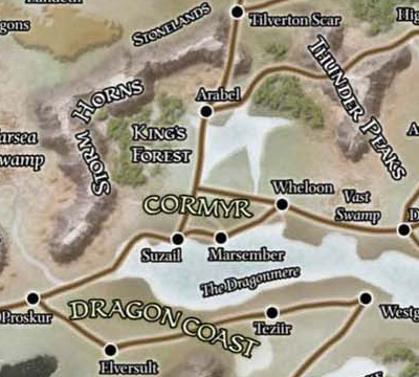
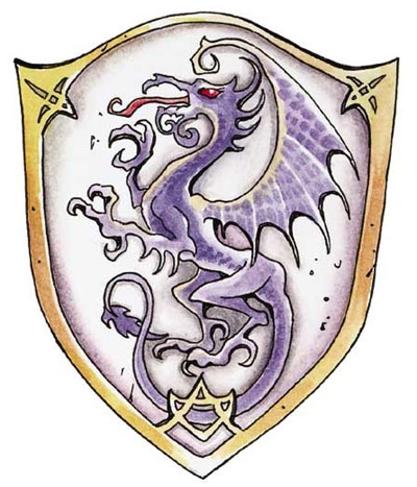

Storm Horns: Mountainous Western Border - The forbidding Storm Horns form a high wall that separates Cormyr from Netheril to the north and Najara to the west. It is broken only near High Horn Pass and Gnoll Pass, which are guarded by Castle High Horn and Castle Crag, respectively. Orc and goblin tribes in the mountains occasionally rise up and attack the lands of Cormyr.
King’s Forest: House Obarskyr’s hunting preserve is a relatively safe woodland largely free of fell creatures or ruins. In the wake of the Spellplague, small numbers of fey returned to this forest. Although most avoid contact with Cormyr’s human population, a few malicious faeries use magic to lure lone travelers astray.
Farsea Swamp: Bordering the western side of the Storm Horns, this slowly growing mire consists of two formerly separate marshes, Farsea and Tun. The ruins of a vanished civilization rise here and there amid this sodden and thoroughly unpleasant area. Thick with poisonous insects and plague, Farsea prevents all but a few from glimpsing these ruins
Stonelands: A band of wide, rocky desolation between the Storm Horns and Netheril, this region is inhabited by spellscarred goblins, gnolls, orcs, and other brigands. For more than a century, Cormyr’s rulers have offered generous land grants to adventurers willing to tame this area and carve out civilized holdings.
Tilverton Scar: The city of Tilverton fell to the Shadovar in the Year of Wild Magic (1372 DR), leaving only a concave space filled with darkness. After the Spellplague, explorers found the area further modified. It was marked as the only known plagueland in Cormyr. Where before only shadow reigned, a perpetually infalling spiral of darkness and blue fire appeared. Creatures that brave the edges of the pocket sometimes come away marked with a spellscar, other times with a flesh-ravaging disease. A small keep built a few hundred yards from the perimeter of the pocket allows the curious to scrutinize the dangerous boundary in something approaching safety.
The Vast Swamp: This region of marsh forms the border between Cormyr and Sembia; neither country wishes to claim it, and both disregard the area unless its monsters wander into their territories. Home to gnolls, hobgoblins, lizardfolk, and trolls, the wetland is also known to shelter yet stranger creatures. This is probably the deadliest region within the area. Still, its creatures usually remain in the moors, and the people of Cormyr have no reason to enter it, so they are content to ignore it.
Thunder Peaks: Named for the sudden and devastating storms that batter them all year, the Thunder Peaks are home to tribes of orcs and goblins that bear no love for Cormyr, Sembia, or the Dales.
CORMYR REGION
Regional Benefit - Cormyr: Add 1 Rank in Knowledge (nobility) and gain +1 bonus to saves against Fear effects
Alternative Regional Benefit - Wheloon: Add 1 Rank in Hide, Move Silently and Sleight of Hand skills
Alternative Regional Benefit (must be Orc, Half-Orc, Goblin, Hobgoblin, or Lizardfolk) - Storm Horns, Thunder Peaks and Vast Swamp: Gain +3 to dismount attempts against a mounted rider
Description: The Forest Kingdom of Cormyr lies at the western end of the Sea of Fallen Stars, nestled between the Storm Horns and the Thunder Peaks and stretching from the Stonelands to the Dragonmere. Dominated by humankind, Cormyr has been ruled by House Obarskyr for over fourteen centuries, with the strong backing of an army of heavily armored knights on Cormyrian destriers and magically potent war mages. The Forest Kingdom emerged from the Spellplague largely unscathed but threatened from the north by the resurrected Empire of Netheril, whose agents, called the Shadovar, are suspected to lurk in every shadow, and from the east by the Netheril-aligned kingdom of Sembia. In the past century, House Obarskyr has reclaimed its strong authority and reluctantly become an imperial power, conquering cities to the east and west. The populace has gained new freedoms and forms the backbone of the region’s strength. Armed adventurers are still required to carry a written charter, but such charters are now granted by any herald upon request. The heart of Cormyr lies in the great forested vale surrounded on three sides by the Storm Horns and the Thunder Peaks and bordered to the south by the shrunken Dragonmere. The reach of House Obarskyr extends north into the Stonelands, where Cormyr’s influence is contested by the Empire of Netheril; west into the Tunlands, where fierce bandit tribes harass trade moving south and west from High Horn to Proskur; and east into the Sembian cities of Daerlun and Urmlaspyr. Cormyr is a strong nation that lies at the western end of the diminished Sea of Fallen Stars. The kingdom is ancient but remains vigorous. Old forests dominate the landscape and national character. Humans predominate in Cormyr, and they are proud of their country’s long and noble traditions. The dragon, the stag, and the unicorn are prominent in Cormyrian folk tales, ballads, and heraldry. Though the nation has a reputation for just rule, sometimes Cormyr has had to make difficult choices to ensure its security. Cormyr is protected by two highly skilled and renowned forces. The Purple Dragons are an elite army of battle-trained warriors. The War Wizards include powerful swordmages that even the Netherese respect. At seventy years of age, King Foril Obarskyr has ruled for the last thirty years. He’s not the old lion that Azoun IV was, nor a great lawmaker like his father Azoun V, but he is a great strategist, statesman, and administrator. Cormyr’s citizens are fiercely loyal to House Obarskyr. Although the majority of the population is human, elves and half-elves are not uncommon.
Suzail: Capital City - Population 55,000 - The royal capital and richest city in Cormyr, Suzail is home to the important nobles and merchant houses of the country. The city center is the royal palace, which is surrounded by gardens and the buildings of the Royal Court. King Foril keeps his residence in the palace. The Purple Dragons and the War Wizards jointly occupy an impressive fortresslike barracks in Suzail. Both constantly drill in the courtyard, using swords, spells, and special tactics to quell a variety of threats. The city maintains the realm’s new shipyards and is home to the royal navy, called the Blue Dragons, that once docked in Marsember. Suzail is also known for its inns, taverns, and festhalls. Coin of every nation is good here, and the city is thick with diversions and entertaining experiences. Adventurers and explorers from all over the continent are always welcome. Tymora’s temple is the most prominent one in Suzail. Shrines to Oghma, Tempus, and Waukeen are also found here. The famous carvers of Suzail buy exotic ivory from many lands, shape it into new and decorated forms, and export it at a greatly increased value.
Marsember: Seaport - Population 38,000 - Marsember spans a series of islands connected by bridges and cut with canals. Many of the higher canals are now planted with crops or allowed to grow wild for livestock to graze upon. Bridges overhead permit both farming and urban life to occupy the same space. Newer facilities nearer the lowered Sea of Fallen Stars keep alive Marsember’s status as a hub of trade, though the volume of items moving through the port is much reduced from a century earlier. Marsember took longer to recover from the lowering of the Sea of Fallen Stars, and the navy never returned to that moorage. Marsember is known as the City of Spices due to the local merchant companies that specialize in such wares. These Spice Lords trade in a variety of flavorings, elixirs and some banned ingredients as well. The Purple Dragons and the War Wizards constantly seek to disrupt illegal trade but never seem to be able to stamp it out, possibly because some among their ranks secretly count the Spice Lords as allies.
Wheloon: Prison City - Population 3,000 - Once known for its vibrant green slate roofs and ferry trade along the Wyvernflow River, the city has been transformed into something far darker by royal decree. The Purple Dragons discovered that a majority of Wheloon’s residents, be they craftsfolk, traders, or farmers, were also secret worshipers of Shar. Fearing that the entire city was a front for Netherese spies, the king ordered it walled up with brick and magic, and all its residents declared lifetime prisoners. Now, whenever Shadovar spies or sympathizers are discovered, they are put over the wall and left to fend for themselves. Life as a prisoner in Wheloon is brutal and short, unless one is able to join one of the many rival gangs. To “escape from Wheloon” is a euphemism for accomplishing a difficult task. Those who do so literally are marked by prisoner and gang tattoos imprinted while behind the walls. This branding makes continued life in Cormyr one that requires constant disguise.
Arabel: This small city lies in northeastern Cormyr, at the crossroads of the main east-west and north-south trade routes leaving the Forest Kingdom. Over the past century, Arabel has evolved into a fortified military base, defending against the threat of the Empire of Netheril to the north and east.
THE DALELANDS
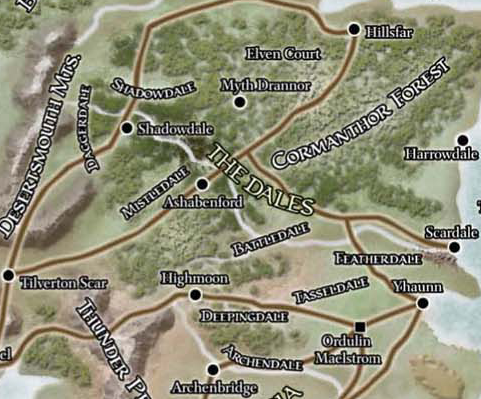
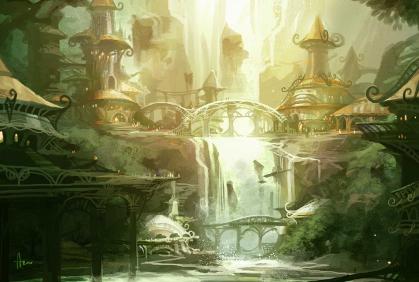
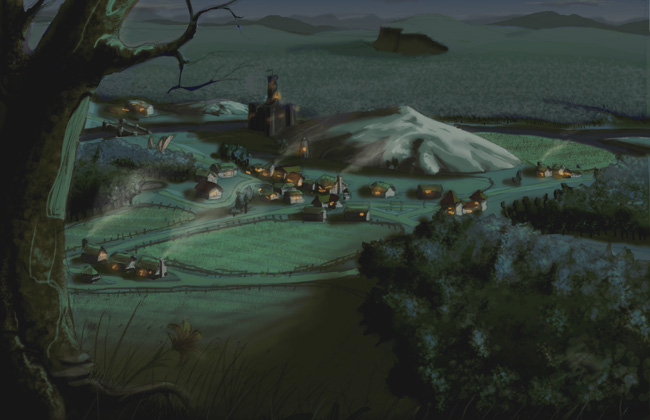
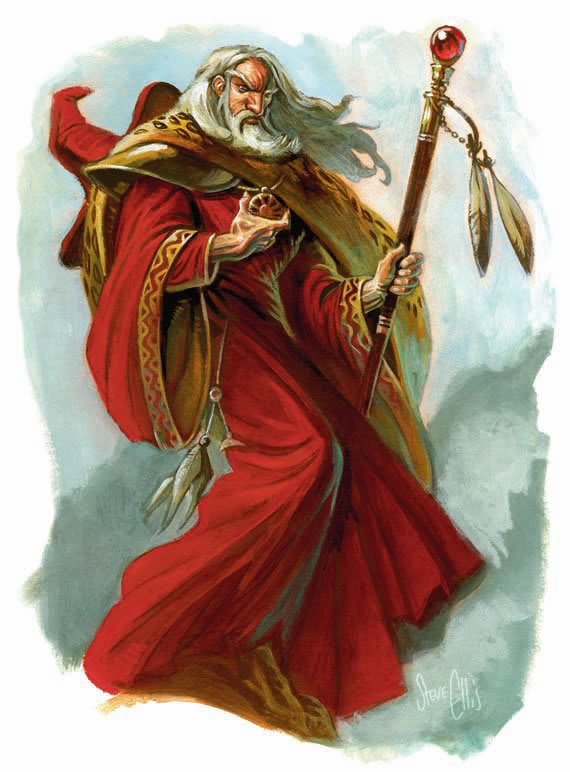
High Dale: Cormyrian Dale; Population 15,000 - High Dale is tucked just below the main section of the Thunder Peaks and just north of the mountainous splinter that runs along the Vast Swamp to the west. The main area of High Dale is a high plateau suitable for farming. Its people also farm the mountainsides by carving terraces into their slopes. High Dale is known for crisp air, splendid views of the Thunder Peaks, and hardy shepherds, small farmers, craftsfolk, and stonecutters. Scattered among the native dwellings stand stone watchtowers garrisoned by Cormyrian forces—High Dale gives its allegiance to Cormyr, the only force that aided the Dalelanders when Sembian militants threatened attack. Receiving little aid from the then-quiescent Dales Council, High Dale threw in its lot with Cormyr, deciding that doing so was the best way to stave off Sembia’s advances. Purple Dragon Knights of Cormyr moved in to defend the dale in the Year of the Advancing Shadows (1422 DR).
Scardale: Sembian Dale - Population 90,000 - Scardale’s three significant geographical features are the River Ashaba, which runs through the dale from west to east; the Sea of Fallen Stars at the river’s mouth; and the great gorge named the Scar, which gives the dale its name. According to legend, this high-sided ravine is the result of an errant blow from the sword of Corellon during his struggle against Gruumsh. Sembia owns Scardale, and the center of that control is Scardale Town (population 20,000). Like Sembia, Scardale is subject to Netherese rule. Still, the dark hands of the Shadovar lie lightly here. Scardale has long been a naturally contentious and unruly place. Scarlet ships out of Thay sometimes put in at Scardale Town harbor without comment by the authorities. Scardale fell to Sembia through a series of betrayals, sneaky merchant deals, consolidations of power in tiny steps, and finally, the appearance of a mercenary army in the capital, Chandlerscross. The troops slaughtered many Dalelanders and drove out the rest. The new capital is Scardale Town.
Tasseldale: Sembian Dale - Population 10,000 - Tasseldale sits north and east of the Arch Wood, southwest of Featherdale, and just barely north of Sembia. The dale is largely flat, open land, perfect for farming. Yevenwood to the north provides fur, timber, and hunting for Tassadrans who can’t bear to work the loom or plow. The craftsfolk and tradesfolk of this dale are heavily taxed by Sembian merchant overlords. Long thought immune to Sembia’s imperialistic ambitions, Tasseldale learned to its woe that Sembia had no qualms about annexing it, just as it long ago overran the long-vanished Moondale, later renamed Ordulin. Unlike in Featherdale, the Tassadrans resisted the occupation, led by their charismatic leader Grand Mairshar Erich Inshiland. The locals fought bravely and blood was spilled, but in the end, Sembia, and thus Netheril, gained control. When Sembia was unable to subvert Tasseldale as bloodlessly and easily as it did Featherdale, mercenaries financed out of Yhaunn overran the area in the Year of the Dark Goddess (1420 DR). Requests for aid from Archendale were rebuffed, and Tasseldale was eventually brought under Sembian rule.Together with Scardale, this area constitutes a restless northern borderland for Sembia, because the Dalelanders who still live here don’t care to be governed by outsiders.
Tarkhaldale (Lost Dale): Netherese Dale - Population 10,000 - In ancient times, Tarkhaldale was a flourishing mining and farming community, trading with the dwarves of the Desertsmouth Mountains and the human realms of Asram and Hlondath. After the spread of the Great Desert of Anauroch and the destruction of the dwarven mines at Tethyamar, Tarkhaldale was abandoned, left to the orc and goblin tribes of the region. Among the few who remained aware of the land, it became known as the Lost Dale. Today, Tarkhaldale is once again peopled by human settlers. The Empire of Netheril has taken it over and few others know of the vale’s existence.
MYTH DRANNOR - The small but vital realm of Myth Drannor is nestled in the forest of Cormanthor. The region’s giant maples, looming shadowtop trees, and towering oaks seem a living testament to a forgotten green age, a time in which humans were an afterthought. The new Myth Drannor is not as powerful or widespread as the realm that fell in the Year of Doom (714 DR), but it’s still the strongest state between Sembia and Thay. Deep, green forest once stretched unbroken from the Sea of Fallen Stars north to the Tortured Land, west through the Thunder Peaks passes, and around the Stonelands to the Storm Horns. The Cormanthor forest is much reduced from that ancient day but remains a broadly canopied and beautiful realm.
Cormanthor Forest: Woodland Enclosing Myth Drannor - Cormanthor is a beautiful high forest, worthy of bards’ songs and poets’ flights of fluttering adjectives. With the renewal of Myth Drannor in its heart, the dangers of the forest are easy to ignore. Travelers move with confidence beneath the whispering boughs and green canopies. Still, centuries of magical portals, wards, and summonings have left certain areas that only the skilled, wood-wise, or magically gifted can expect to survive without harm. Every year, Coronal Ilsevele commissions a group of explorers to reconnoiter a particularly dangerous section of the wood, and if possible, end the threat or put clear boundaries on the particular danger of a forest region.
THE DALELANDS REGION
Regional Benefit - The Dalelands: Add 1 Rank in Knowledge (nature) skill and gain +1 to Initiative checks
Alternative Regional Benefit (must be any Elf) - Cormanthor Forest and Myth Drannor: Once per day you can reroll a saving throw against a charm effect or spell
Alternative Regional Benefit (must be Orc, Half-Orc) - Desertsmouth Mountains: You gain +1 to attack rolls while in Mountain terrain
Description: North of Sembia and Cormyr, east of Netheril, South of Thar and The Ride, and west of The Sea of Stars and Vesperin and Impiltur, along the periphery of the elf-ruled forest of Cormanthor lie the Dalelands. It is a group of loosely allied communities that share common cultures and traditions. Linked by winding trade roads and their alliance against the encroaching powers to the north, west, and south, the Dales are known for their lush forests, fertile farmland, and fierce independence. The northern Dales have largely prospered over the last century, thanks to a strong alliance with elf-ruled Myth Drannor and close ties with the kingdom of Cormyr to the south. The southern Dales have fallen under the sway of Sembia as that merchant kingdom continues its gradual, yet relentless, expansion northward under the guide of Netheril. The Dalelands generally lie in or near the valley carved by the River Ashaba and its tributaries. People of the Dalelands, Dalesfolk, who are predominantly human, believe strongly in individual freedom and collective responsibility. They are suspicious of expansionistic empires, and they reject those who seek power by sword or spell. Dalesfolk view their lands as a trust to be held and nurtured for future generations. Most human Dalesfolk live in harmony with elves, and many half-elves, particularly in Deepingdale, are the product of their unions. Some Dalesfolk remain suspicious of the imperialistic ambitions of House Obarskyr, but such sentiments have largely faded in the face of burgeoning threats from the Empire of Netheril, its Sembian client state, and the nations of the Moonsea. A typical inhabitant of the Dalelands would like nothing more than to live in peace to farm and hunt, but she keeps a sword and a bow at the ready and volunteers to serve in the local militia at the first sign of trouble. The Dalelands comprises several forested counties, called dales, scattered around the perimeter of the Cormanthor Forest. Although the dales share common traditions, cultural practices, and religious allegiances, the Dalelands is not a unified kingdom like Cormyr or Impiltur. The broad forest vales, separated by rolling farmlands, are interlinked by narrow trade roads through lush woods. The dales’ independent spirit and age-old alliance with the fey of Cormanthor are well known across most of Faerûn. Over the last century, the Dalelands has been the focus of powerful surrounding realms, all vying for control.
Archendale: Militaristic Dale - Population 90,000 - Known as the unfriendliest and most aggressive of the dales, Archendale is also the toughest and best defended. The vigilance of both citizens and soldiers leaves Archenfolk free to get on with the business of growing wealthy through trade, something they have always done very well. Archendale fills the long, narrow valley of Arkhen Vale. It surrounds the gorge cut by the swift, cold River Arkhen. The valley flanks the gorge and spreads out a day’s ride in all directions from the dale’s preeminent community, Archenbridge. Archenbridge (population 8,000) is the Dalelands’ most fortified city. Its center is as cramped and as bustling as a ward of a much more populous city. Wagons rumble up and down cobbled streets at all hours, and every building rises at least three floors above ground level. Tenements and noble townhouses alike feature barred windows and hidden inner holds equipped with arrow slits and nastier defenses. Though it nearly fell to Sembia’s expansionist desires, Archenbridge maintains trade with its southern neighbor. The heavily fortified capital city of Archendale lies on the border with Sembia and is increasingly becoming a marketplace where Cormyrians and Sembians can trade outside the scrutiny of their respective rulers.
Battledale: Tranquil Dale - Population 30,000 - Despite its impressive name, Battledale is today a guarded but peaceful land. Large in size, it is one of the least populous and most dispersed of the Dalelands. Visitors to Battledale see only the open, rolling farmlands along Rauthauvyr’s Road, referred to by Dalesfolk all over as “the Belt.” In summer this is marvelous country to camp in, although one should beware of brigands. Deep within the thick woods of Battledale lies the ghost town of Essembra, a long lane of abandoned and fire-ruined cottages rotting on both sides of Rauthauvyr’s Road. Nearly sixty years ago, Essembra was the site of a fierce battle between forces from Myth Drannor and Netherese-backed Sembia. Alarmed by Featherdale’s bloodless capitulation to Sembia, Battledale began to restrict trade and travel with the Netheril puppet state. The dale came under heavy attack in the Year of the Advancing Shadows (1422 DR), forcing the evacuation of Essembra. Fell magic was unleashed in the ensuing conflict, prompting local Battledarrans to abandon their homes and seek refuge at the Abbey of the Sword.
Daggerdale: Nightmarish Dale - Population 15,000 - Most of Daggerdale is rolling wooded hills broken by labyrinthine rocky valleys. It’s good grazing country for livestock, but large ranches are confined to the region around Dagger Falls. That name applies both to the steep waterfall and to a nearby frontier town (population 2,000). The Desertsmouth Mountains tower over the hills of Daggerdale. A great dwarven kingdom called Tethyamar once occupied the Desertsmouths. Several hundred years ago, it fell to orcs, ogres, evil wizards, and fiends—some of which still lurk in the peaks. Many adventuring companies based in Daggerdale seek Tethyamar ruins in the western mountains. A century ago, Daggerdale was ruled by Zhentarim agents, but that occupation is a distant memory today. Daggerdale has been increasingly troubled by humanoids raiding out of the Desertsmouth Mountains and by a resurgence of lycanthropes infesting the crags of the Dagger Hills. As a result, the frightened villagers of Dagger Falls have become isolated and cut off from the other dales. Long since free of Zhent influence, Daggerdale now finds itself an unwilling buffer against the Empire of Netheril.
Deepingdale: Welcoming Dale - Regional Population 50,000 - This dale is situated along the contested route between Cormyr and Sembia. Deepingdale comprises the lands around the rivers Glaemril and Wineflow. Both of them flow swift and strong, and have abundant salmon runs that nourish forest creatures as well as the people of Highmoon (population 8,000), Deepingdale’s capital city. More than any other dale, Deepingdale is woven into and around Cormanthor. The Deepingfolk, half of which are elven or half-elven in ancestry, live in the shadow of the trees and in the lighter growth at the outskirts of the great forest.
Featherdale: Sembian Dale - Population 18,000 - Featherdale isn’t technically a dale, since it is not a valley. Its rich farming lands fall within the sweep of the River Ashaba as it flows east toward the Sea of Fallen Stars. The lowlands of the Ashaba are a patchwork of gently rolling farms. Waist-high fieldstone walls and rather haphazard lines of evergreen-planted levees guard against flooding. Featherdale is truly the pastoral farming country that many Sembians imagine the Dalelands to be. Thus, despite being under Sembian control, the Shadovar puppet state pays little mind to this stretch of road between regions of far greater significance. Unlike other Dalesfolk, Featherdarrans have little to do with Myth Drannor. This traditional separation has become even more pronounced with the influx of Sembian merchants, who collect taxes and enforce their trade policies on farmers by means of well-paid mercenaries. Over the years, Sembian investors slowly bought up so much of the place that eventually Sembian administrators moved in. As a result, the Shadovar of Netheril “accidentally conquered” Featherdale in the Year of the Lords’ Coronation (1418 DR).
Harrowdale: Oldest Dale - Population 44,000 - Harrowdale borders Cormanthor to the west, the Dragon Reach to the east, and the Cold Field to the south. The dale is mostly farmlands, which turn to orchards closer to the sea and to the Velarswood at its center. The countryside has changed little over the last century, though the former small seaside village of Harrowdale Town has grown into the rich mercantile port of New Velar (population 9,000). With aid from Myth Drannor, Harrowdale Town completed work on a defensive wall. In the Year of the Elfqueen’s Joy (1428 DR), the Seven Burghers announced a formal alliance with Myth Drannor and renamed the city New Velar. Soon after, Myth Drannor established an embassy in New Velar and began construction on shipyards.The renamed city is the largest free settlement in the Dalelands, now that Scardale has fallen to Sembia, and claims the best port into the area. Goods from all across the Sea of Fallen Stars flow through New Velar on their way to and from Myth Drannor along the Harrow Ride (the old Halfaxe Trail, now a well-guarded, paved road through the old Elven Court). This robust trade accounts for the great wealth of the city. Greater Harrowdale and its capital city are ruled by its wealthiest merchants, the Council of Seven Burghers. A Burgher holds his or her position for life, and upon a death in the Council, the Harrans appoint the wealthiest non-Burgher to fill the seat.
Mistledale: Ruling Dale - Population 34,000 - Mistledale occupies the valley along both sides of the Moonsea Ride, east of Peldan’s Helm and west of the spot where the forest closes in roughly three miles before the Standing Stone. The River Ashaba cuts across the center of the dale, crossed by the Ride at the excellent natural ford at Ashabenford (population 5,000), whose population has exploded over the last several decades. Mistledale is a widely spread dale. Its small settlements can see each other and Ashabenford across the gently rolling hills, except in the mornings and the evenings, when mist rises from the river and fills the valley. For communication across the dale, each hamlet is equipped with special bells whose peals penetrate the fog. By varying the rings, the bell-ringers carry different messages of alarm or inquiry. The sounds are understood by long-term residents of the dale but are a mystery to outsiders. Ashabenford, the seat of the Dales Council sprawls across the banks of the River Ashaba. Its relative security, far from the threats of surrounding lands, and its proximity to Myth Drannor have made this small city wealthy.
Shadowdale: Fey Dale - Population 10,000 - Shadowdale is a broad tract of rolling hills and thick forest with patches of cleared and settled land. The unwalled village of Shadowdale (population 1,000) and the looming presence of the white granite promontory called Old Skull dominate the forested area where the North Ride and the River Ashaba cross. Today the woods of Shadowdale are quite changed from centuries past. The Living Wood, as it is once again known, is peopled by all manner of benevolent fey. Just outside Shadowdale’s town limits, north of the old Silverhand farm, are a series of standing stones surrounding a copse of ancient trees. This is the Druid’s Grove, a place that visibly exudes great primal power and is particularly sacred to the fey. Shadowdale is currently ruled by Lady Addee Ulphor, who gained the Pendant of Ashaba twenty years ago when Azalar Falconhand resigned his lordship. Elminster resides there still, but his powers have diminished since Mystra’s fall.
MOONSEA LANDS
MOONSEA LANDS REGION
Regional Benefit - Moonsea Lands: You gain the Endurance feat
Alternative Regional Benefit (must be Arctic Dwarf or Shield Dwarf) - The Great Glacier: You gain +3 cold resistance and +5 to Balance checks made due to slippery surfaces
Alternative Regional Benefit (must be Human, Orc or Half-Orc) - The Ride: Add 4 Ranks in Survival skill
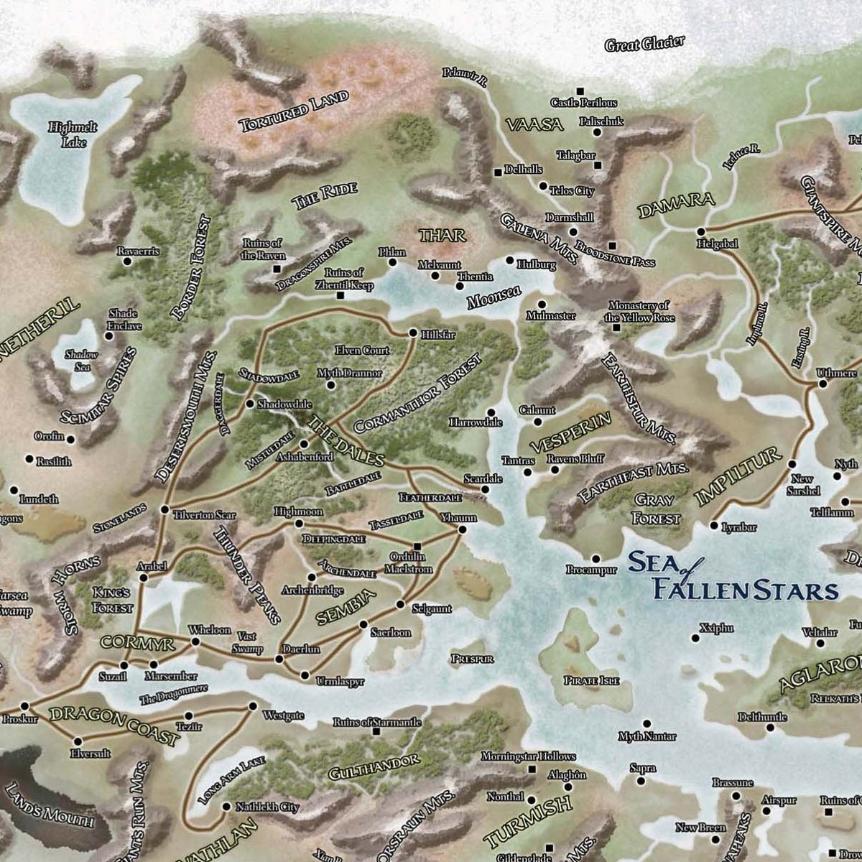
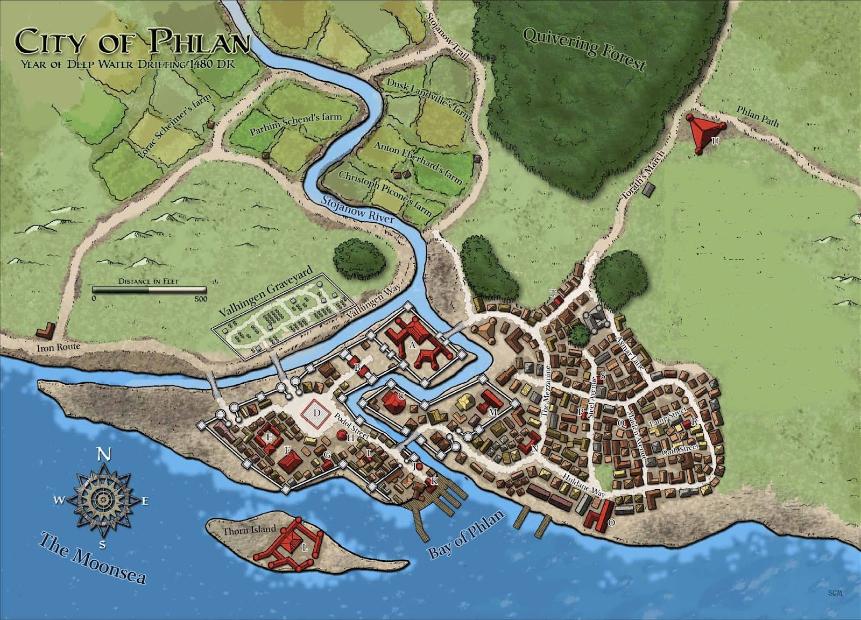
Great Glacier: Slowly Melting Ice Mass - Though considerably diminished in size from the time when cartographers dubbed it the Great Glacier, the enormous ice flow remains impressive. Slowly, the glacier gives up its secrets as the Novularond Mountains surface from their icy prison. Ruins from some lost civilization stand on those peaks. White dragons and other creatures of cold roam the glacial waste. Frighteningly organized and intelligent chillborn zombies emerge from the lost city of Vaalathrim. Hungry and savage, the undead kill warm-blooded creatures by sapping their heat.
The Ride: This land is an open steppe stuck between mountains, badlands, swamp, and Netheril. Tribes of proud savages, orcs and humans, ride the plains. They consider any outlander fair game, but they tolerate mining communities that offer trade in exchange for the privilege to extract the considerable mineral wealth of the surrounding highlands.
The Tortured Land: Covered in lava formations that were carved by ancient glaciers and smoothed by millennia of windborne grit, the Tortured Land is even less hospitable than Vaasa. Its mesas and spires have shapes that defy the imagination, some like glass, and more than a few broken and jagged where time has taken its toll. Swift, vicious monsters with strange forms roam the waste.
Damaran Gate: Choke Point between Damara and Vaasa - This fortress wall guards the end of Bloodstone Pass between Damara and the Warlock Knights of Vaasa. The Damaran Gate is 3 miles long and 30 feet high, studded with ballista-defended towers, and flanked by castles at either end. The castles and gate are regularly patrolled and filled with stockpiles of food and armaments in case of an invasion.
Description: The Moonsea Lands cover the areas starting with The Border Forest in the west near Netheril, and spans east across The Ride and Thar, over the mountains surrounding Vaasa and over Damara. The Moonsea, in reality a deep freshwater lake, is the centerpiece of a land of harsh climate and hardened folk. The region includes many city-states ruled by tyrants. Its northern steppes are dominated by roving tribes. The western reaches are dotted with monster infested ruins; the burned-out hulks of Zhentil Keep and other strongholds of the former Black Network. The Church of Bane is still strong in the region, its power base moved to the dark eastern metropolis of Mulmaster. The Great Gray Land of Thar remains a desolate breeding ground for orcs, ogres, and minotaurs. The brutish humanoids provide a buffer for the civilized lands against the growing predations of neighboring Vaasa. The region saw a glimmer of hope when King Gareth Dragonsbane united Damara and Vaasa into the unified kingdom of Bloodstone. But the assassination of Dragonsbane’s heir twenty years ago led to civil war throughout Bloodstone, allowing the patient Warlock Knights to seize control of windswept Vaasa. Damara is wild, rugged, and rustic; a frontier as unrefined as it is remote. This is a northerly land of windswept plains, ice-crowned mountains, dark pine forests, and long, fearsome winters. Any who stray too far from the walled towns end up fighting for their lives against horrible monsters. Adventurers are drawn to Damara to carve out lands of their own, taking on lordship and inventing titles for themselves. King Yarin understands that the Warlock Knights are a real threat. He relies on the strongholds and war bands of upstart vassal lords, many of them former adventurers, to defend the passes of the Galena Mountains. Yarin reserves his own cadre of foreign mercenaries to crush any subordinates who show signs of moving against him. Vaasa is a desolate realm of bogs, tundra, and windswept mountains in the northwest corner of the Bloodstone Lands. The dreaded Warlock Knights of Vaasa gather an army of monsters of all descriptions, preparing for the day when their terrible hordes will sweep away neighboring kingdoms, spreading their evil. An entity called Telos, Master of the Iron Sky, is the focus of the Warlock Knights’ power. The most powerful members of the Warlock Knights advise this mighty ruler of Vaasa as a group called the Ironfell Council. Members of the council, as well as their servants, also compete with each other for status and power.
Helgabal: Capital City - Population 25,000 - This once prosperous trading city is the former seat of Damara’s throne. Merchants traveling north now think twice before venturing into the frontier domain, given the despotic control of its temperamental monarch.
Darmshall: Town - Population 5,000 - Warlock Knights conquered this town, once ruled by successful adventurers, quickly and brutally. It supports a large number of free humans and fewer nonhumans than other Vaasan communities. The city’s fields and ranches support the Iron Divide, a fortification that guards the Vaasan end of Bloodstone Pass.
Palischuk: City - Population 10,000 - Palischuk was once a ruined city, but it was rebuilt after the war with Damara. Palischuk was peaceful until the coming of the Warlock Knights. It is now the fortress city of Knight Vindicator Mansard Kanaoth, an influential member of the Ironfell Council who wishes to be Vaasa’s king.
Telos: Fortress City - Population 15,000 - The Ironfell Council meets in a large central castle in this city. Each councilor has a suite of rooms in the castle but is only rarely in residence, because every Warlock Knight serves as lord over a portion of land in Vaasa. Some Warlock Knights claim only a small keep and patch of surrounding land, but some have true fortresses and miles of surrounding region to rule. Every Warlock Knight maintains a private army, which the council can summon at need. Much of Telos’s population is composed of refugees from other Vaasan settlements that the Warlock Knights destroyed when taking the land for themselves. In addition to humans and dwarves, the fortress contains orcs, giants, goblins, and kobolds. Many are slaves, some are slave-soldiers, and an elite few are true Warlock Knights.
DAMBRATH
DAMBRATH REGION
Regional Benefit - Dambrath: Gain +4 to Handle Animal and Ride skill checks involving horses
Alternative Regional Benefit - (must be a Halfling) Southern Lluirwood: Add 2 Ranks in Knowledge (nature) and 2 Ranks in Diplomacy skills
Alternative Regional Benefit - (must be any Elf or Half-Elf or any Halfling) Amtar Forest: Add +10' to all ranged weapon range increments
Alternative Regional Benefit - (must be a Gold Dwarf or Shield Dwarf) East Rift: You gain Deep Speech as an additional language and add 2 Ranks in Knowledge (dungeoneering) skill

Amtar Forest: Half-Drow, Halflings of all sorts and other Elves call this forest home and are at war with the gnolls in the nearby mountains daily. They have learned to shoot ammunition farther than others after years of firing missiles up into the mountains at their raiding enemies.
Hills of the Kings: Sacred Site - Meandering streams crisscross these grass-covered hills. In the east, halfling villages thrive by trading. The hills also house the tombs of eight Dambrathan kings. Some of the tombs were looted during Crinti rule, but others remain hidden. Dambrathans view the hills as sacred. On the southern side, the nomadic tribes meet twice a year to trade, socialize, and intermarry, often making or breaking pacts. Over a hundred totem sculptures mark the meeting place. Each work of art signifies a particular clan, and each clan updates its totem to record past events and future intentions. Dambrathans can identify a totem’s clan and read the history recorded on the sculpture.
Gate of Iron Fangs: A ruined city lies on the south side of the Forest of Amtar astride the River Dambron. Its name comes from a tower-flanked gate that resembles serpent fangs. Dambrathans, along with the elves and halflings of Amtar, avoid this place. The city is the domain of the Quinix tribe of gnolls, a particularly savage clan.
Ruins of Cathyr: Dambrathans call the remains of Cathyr “the Corpse of Lolth” because of a spider-shaped temple that squats amid the ruins. When the Dambrathan uprising began, the priestesses closed the temple doors and began dark rites. To this day, the ruins of Cathyr are home to monstrous spiders of all sorts, as well as demons. Rumors speak of worse horrors and great treasures that wait within the brooding temple.
East Rift: Huddled on the eastern shelf of the yawning Under- chasm, directly north of Dambrath. The floor of what was once called the Great Rift is now a shelf on the side of the Underchasm. It has come to be called the East Rift. East Rift is a living symbol of gold dwarf ingenuity and stubbornness, having survived when the surface collapsed into the bowels of the Underdark. Protected by enormous towers connected by a high curtain wall, the gold dwarves are ready to defend themselves against the drow or any other horror that rises from the depths. A few years after the collapse, dark elf refugees invaded the dwarven city of Underhome. The drow overran the city and still hold its lower regions. With the loss of Underhome, Eartheart has become the center of the dwarven lands. Underwatch, a fortress and village near Underhome, is a principal gateway that surface adventurers use when entering the exposed Underdark. The East Rift consists of a country-sized shelf overlooking a cavernous abyss. Waters from various seas spill down from the heights, forming rapids and sparkling falls that tumble into the darkness below. Suspended in the air are curious motes, clumps of earth and stone that are crawling with strange creatures, wormed with tunnels, and laden with relics from the past. The East Rift is a wondrous place, with cunningly crafted switchback stairs, twisting pathways, and trained griffon steeds that all serve to connect the tiny communities that cling to the wounded stone. The formation of the Underchasm laid waste to many dwarven cities, a tumult of sliding stone and water washing them into the bowels of the Underdark. Those who survived fled to the East Rift for protection and a chance to rebuild what they lost.
Underchasm: Hole to the Underdark - The Underchasm is an expansive sinkhole formed by the collapse of a portion of Faerûn into the Underdark. The Sea of Fallen Stars, the Shining Sea, and the Great Sea all feed the Underchasm by various waterways, so many of the walls in the depths are veiled in steaming cascades whose thunder is audible for miles. The upper portions of the Underchasm’s sides host colonies of flying monsters and the occasional dragon. The lower portions hold vast numbers of bats and darker denizens. The northern section of the Underchasm partly undercuts the thick Chondalwood. The jungle has begun to reach down into the dark, creating mileslong vines and massive roots ideal for climbing creatures. Junglemotes also float above the northern Underchasm. Several other earthmotes hover over other portions of the Underchasm, tunneled with chambers lined in luminescent fungus.
Riftedge Towers: Sentinels’ Bastions - Stone towers guard the edges of East Rift, along the top and the depressed shelf, as a precaution against whatever evil might rise up from below. The towers that once surrounded the entirety of the Great Rift now extend only partly around the more expansive Underchasm. The dwarves are unable to fully guard the entirety of that vast opening. They are also uninterested in doing so, since they are primarily concerned with their own security. They do send patrols afield on foot and astride griffons, even around the Underchasm’s periphery, just to keep an eye on things. Such patrols carry powerful horns to summon reinforcements from afar.
Description: This region lies along the Great Sea in the southern part of Faerun, just south of the Underchasm and East Rift and east of the Halruaa Plaguelands. Dambrath is a hot plain dominated by horse-riding, nomadic humans related to the Nars of northeastern Faerûn. Some Dambrathan clans are bellicose and insular, raiding nearby lands. Others are less aggressive and more accepting of outsiders. The clans don’t war on one another, except in highly ritualized honor-duels or minor raids for resources and sport. At one time all Dambrathans were slaves, so they still see themselves as united against a hostile world. Half-blood drow known as Crinti formerly ruled Dambrath under a state religion dedicated to Loviatar. Native Dambrathans, who call themselves Arkaiuns, rebelled during the Spellplague. Turning to their totems and nature spirits, they drove the half-bloods from their lands and burned every priest of Loviatar they could catch and every city under their rule.
Purl: Pirate Port - Population 800 - On the peninsula between the Bay of Dancing Dolphins and the Great Sea, the lawless town of Purl still stands. Lack of Crinti rule spared it the fires of rebellion, and the nomads sometimes come here to trade.
Eartheart: Capital City - Population 50,000 - Fortified Eartheart is the heart of the dwarven kingdom. The Deep Lords, a council of important dwarves chosen by merit from among the populace, once ruled from below the earth. They fled from their tunnels during the cataclysm, and they now govern the dwarves of the region from a great citadel carved into the vertical side of the East Rift. The identity of each Deep Lord is kept secret, out of fear of drow assassins. Each lord speaks through one or more emissaries, and the Lord Scepter of Eartheart is their mouth to the populace. The structures of Eartheart are built into the sides of the East Rift, and the city extends far more in the vertical than the horizontal. The vertical “streets” that grace Eartheart’s expanse are a series of cunningly carved switchbacks. Small stairwells, suitable for a single creature at a time, are prevalent, but one immense switchback exterior stair connects the vertical portion of the city from top to bottom. The lower regions, untouched by the sun, glow with magical light, day and night. Those who don’t want to chance the stairs, and who have extra coin, can travel by griffon steeds, which are bred and stabled throughout the city. The principal gold dwarf settlement in the East Rift, Eartheart remains the spiritual and cultural center of these people. Before the great collapse, Eartheart housed all the temples and shrines devoted to dwarven gods and heroes. Dwarves from the depths and from other countries made pilgrimages to behold the architectural splendor of this holy city.
Hammergate: Once a tent city known as Hammer and Anvil that sprawled around the southwestern gate of Eartheart, Hammergate is now a walled foreign quarter of the city. Its eastern gateway opens onto the road to Delzimmer. Nondwarf outlanders are not allowed beyond Hammergate, but just about anyone can stay and trade in this part of Eartheart, under the watchful eye of numerous dwarf guards.
Underwatch: Garrison Town - Population 7,000 - This fortress is easily three times the size of a typical riftedge tower. Situated within sight of the Gates of Underhome, Underwatch serves as a station for dwarf soldiers assigned to watch the lost city for interlopers. Woe to any who let the dwarf authorities catch wind of a plan to enter Underhome. A village around the fort is a trade station and a logging camp where trees harvested from the Riftwood can be brought into the East Rift. The village is often used as a base of operations for those who wish to enter the East Rift or the Underchasm. From Underwatch, dwarves mount regular expeditions into the Underchasm to refine their maps and to keep tabs on what threats might be gathering below. Any outsider interested in signing onto one of these expeditions is welcome—after being vetted to assure the expedition leader that the newcomer isn’t a spy or worse.
DRAGON COAST
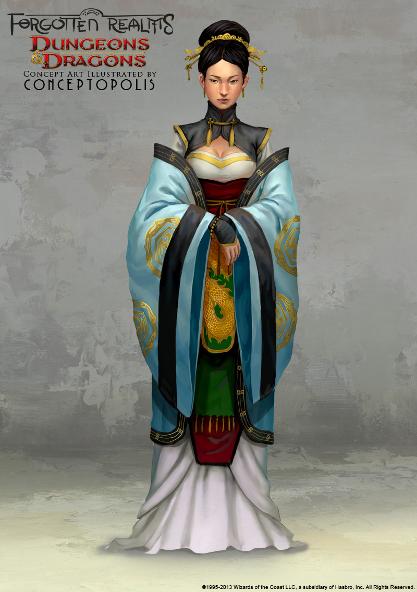
DRAGON COAST REGION
Regional Benefit - Dragon Coast: Add 1 Rank in Intimidate, Sleight of Hand and Use Rope skills
Alternative Regional Benefit - (must be Human) Turmish: Add 2 Ranks to Perform (any) skill and gain +1 to damage with throwing javelins or shortspears when thrown
Alternative Regional Benefit - (must be Human) Nathlan: Add Shou language and 1 Rank in Balance and Concentrationskills
Alternative Regional Benefit - (must be Human, Elf or Half-Elf) Gulthandor: Add Elven (or Fey, if already known) language and 2 Ranks in Knowledge (nature) skill
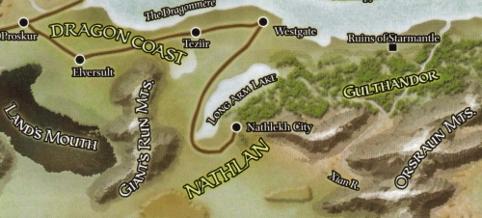
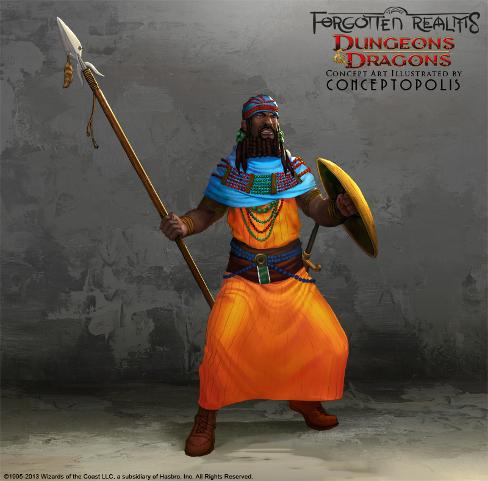
Giant’s Run Mountains: The high places in these mountains are hollowed to admit the towering forms of their residents. The peaks are carved in great steps suitable only for massive treads. The giants have answered to the same monarch for the last fifteen hundred years: Dodkong, an undead stone giant whose seat of power lies in Cairnheim. The undead king reanimates each clan chieftain who dies, forming the Dodforer, a council of “Death Chiefs” who serve him. Cairnheim is a city of tunnels and caverns. The city’s lower depths open directly into the Underdark, though the giants impose hefty tolls to restrict surface access for creatures of Faerûn’s lightless underbelly.
Gulthandor: Wilderness Realm - Population 7,000 - Gulthandorans respect the sky and the wilderness; they look to nature for inspiration and power. Natives revere all trees, especially groves of cedar and pine. They admire limpid pools, flowing rivers, and the nearby sea. They believe the isolated hilltops that rise above the forest canopy are holy places. The forested realm of Gulthandor is controlled by a circle of druids who meet in Cedarspoke. The circle never numbers more than thirty-three, and its members change with the seasons. Humans, elves, and half-elves are the dominant humanoid residents of the region, though natural forest creatures of every type, as well as awakened trees, satyrs, and Feywild visitors are common.
Ruins of Starmantle: This city was destroyed in the Spellplague. The few who survived say that a wave of blue fire erupted from a portal, boiling outward until the entire city was engulfed. When the chaos subsided, all was different. A gyre of light and confusion hangs above the ruins like a low-hanging storm cloud. Within are strange green crystal spires humming atonal melodies, deep pits harboring suspicious blue glows, and slowly moving masses of obsidian. Treasures might lie sealed below the landscape, in the vaults of long-dead merchant lords.
NATHLAN: Feudal Shou State - Population 18,000 - The County of Nathlan (capital Nathlekh City) runs along the shores of the Long Arm. It is a small feudal state inhabited chiefly by several strong Shou clans. A Shou clan shares a common surname, a mutual ancestor, and an ancestral village far to the east. A few clans wield far greater power than the others. One such is Clan Neng. It was once a “consort clan,” a group whose close ties to the Shou emperor garnered it special privileges and power. When representatives of Clan Neng and its allies reached the western end of the Golden Way hundreds of years ago, they settled in Nathlekh City. In the intervening years, the city garnered more and more Shou settlers until it became predominantly Shou, and grew to govern the larger region now called Nathlan. Although friendly to trade, Nathlan is suspicious of non-Shou, particularly nonhumans. None but Shou are allowed to live permanently in Nathlan, and visitors are restricted to a special section of Nathlekh City. Nathlan is a new province that has grown up over the past century. The Shou of Nathlan, particularly those of the capital city of Nathlekh, are suspicious of outsiders and keep a check on external influences.
TURMISH: A once pastoral land nestled between two mountain ranges, Turmish was forever changed by the Spellplague, which redrew its coastline and put longstanding traditions to the test. For centuries, Turmish was known as a realm of merchants, not unlike Sembia, where trade and commerce were the rule of the day. Held in check by a powerful band of druids, the cities of Turmish were not allowed to grow beyond a certain point, and the result was a politically stable and affluent realm with a small population enjoying considerable wealth. That all changed when the Spellplague ripped through Turmish, erasing many of its closest neighbors and draining the Sea of Fallen Stars to leave its busy port of Alaghôn high and dry. Now a stop along the route for fanatics on scar pilgrimages, torn by increasingly competitive and desperate merchant costers, the old Turmish has been replaced by a realm always on the edge of chaos. The realm is ruled by a parliamentary democracy, embodied by the Assembly of Stars, which elects one of its own as chief administrator. To the uninitiated, the people of Turmish come across as gruff and impolite, and indeed many are just that. They are serious, business-minded people who disdain the luxury of social niceties. The once welcoming and cosmopolitan Turmians have grown increasingly xenophobic over the difficult past century and are guarded and suspicious of strangers, even though they remain dependent on outside trade. Turmish is a land of wild coasts and social and political extremes. Many of Turmish’s exotic customs remain in place, not the least of which is the square-cut beard worn by Turmian men. They also continue to mark their foreheads with dots: one dot indicates that one can read, two that one can write, and three that one practices magic. These marks of respect are occasionally faked, and some purveyors of magic remove the third dot before traveling to Sapra.
Gildenglade, the Buried City: The volcano Mount Kolimnis in the central Aphrunn Mountains erupted in 1423 DR. The city of Gildenglade, once home to nearly 50,000 people, was buried under hundreds of feet of volcanic mud and ash. Only a few hundred of its citizens managed to survive, and the city was erased from the map. Years later, after the lava had cooled, caves opened into the buried city. Bold adventurers dug down to find it eerily preserved—and overrun with creatures from the Underdark.
Ironcloak: Morningstar Hollows is a ruined village, the remains of a logging operation destroyed by the Emerald Enclave. Rumors of riches left behind when Lord Ironcloak was killed have persisted for centuries, and continue to attract curious adventurers.
Morningstar Hollows: Not far to the north of Ironcloak is another abandoned village along the banks of the Alaoreum River. Forerly occupied by humans, it was resettled by lizardfolk. But over the years, the lizardfolk were so harried by adventurers seeking fame and fortune that they too abandoned the village for the Wetwoods. Today, the ruins are home to a gang of bandits who prey on scar pilgrims.
Description: The Dragon Coast is a collection of independent city-states along the southwest coast of the Sea of Fallen Stars, ranging from Proskur in the west to the Ruins of Starmantle in the east. Mention of the Dragon Coast evokes images of dark alleys and underhanded dealings, of thieves’ guilds and pirate ships. The region is lawless and piratical so commerce is king. The area is also a cultural hot spot. As the western termini of the sea routes leading to the Golden Way—a continental trade route from Thesk all the way to Shou Lung, Westgate and Teziir have grown large and prominent Shou towns much like those in eastern trade cities. An entire nation of Shou formed even farther west: Nathlan. All manner of eastern wizards, monks and spirits can be found in the region. The receding waters of the Sea of Fallen Stars spelled ruin for Ilipur and Pros; those small trading towns dried up and blew away. Proskur has fallen under Cormyrian dominion, and Purple Dragon lords now hold sway over most of the southwest coast of the Dragonmere. Cormyr annexed Proskur in 1405 DR and later adopted Teziir as a protectorate. Westgate rebuffed both Cormyr and its rival Sembia. Westgate is the most wellknown city along the Dragon Coast. The city proved too large and powerful to be drawn into the orbit of either Cormyr or Sembia. A shadowy group known as the Fire Knives has a strong presence there.
Westgate: City Built on Trade - Population 40,000 - Westgate is the major trading city on the Sea of Fallen Stars. It is an open city; open to all races, all faiths, and all coin. Westgate is the one coastal city that has never suffered from the far-ranging aboleths of Xxiphu. Jaundamicar Bleth is the First Lord of the city. The Bleths are hard at work transforming Westgate from an oligarchy back to a monarchy. Jaundamicar would prefer to change his title from First Lord to King. The vampiric Night Masks thieves’ guild was driven out long ago. A new syndicate, the Fire Knives, now employs the majority of the assassins, extortionists, enforcers, and spies in Westgate. The Fire Knives are opposed by a group out of Westgate’s growing Shou District—the Nine Golden Swords. The Nine Golden Swords in Westgate has publicly opposed the Fire Knives’ worst affronts against those too weak to defend themselves. Consequently, the group, criminal or not, enjoys the popularity of the working class.
Nonthal: Large City - Population 14,000 - Nonthal is the most peaceful and stable city in Turmish, and the citizens are set on keeping it that way. Though not entirely unwelcoming to visitors, it tends to give adventurers a chilly reception, even though there’s no shortage of them passing through.
Alaghôn: Capital City - Population 75,000 - By far the largest city in Turmish, Alaghôn was founded in –37 DR by Chondathan settlers as a mercantile trading post on the Sea of Fallen Stars. It became one of the Inner Sea’s busiest ports, but all that ended when the sea withdrew. The Turmian merchant fleet never completely recovered. Though Alaghôn still enjoys a reasonable standard of living, it’s not nearly the boomtown it was a century past. Boarded-up buildings and shabby storefronts mar the streets. Alaghôn’s curious architecture is the result of the Chondathan humans building over existing structures left by a previous dwarven civilization. The dwarves also left an abandoned mine beneath the city streets. This maze of subterranean tunnels has never been fully explored. Two major festivals are observed throughout Turmish. The Feast of the Moon is celebrated throughout the rest of the world in winter, Turmish observes it on the first full moon after Midsummer. It is the one day that Turmians allow themselves to truly relax, enjoy what they’ve earned over the preceding year, and spend time with their families and friends. Turmian merchants go to great lengths to return home in time for the Feast of the Moon. The Reign of Misrule is ten days after Highharvestide , a day devoted to destructive celebrations and petty civil unrest in which the normally serious and reserved Turmians let go of all restraint.
Sapra: Small City - Population 8,500 - Sapra is Turmish’s only active port. Though nowhere near as busy as Alaghôn once was, goods from all over the Inner Sea pass through it. The citizens of Sapra tend to be fearful of those who flamboyantly wield extraordinary power, and the public display of such activity, though no longer illegal, is strongly discouraged.
Xorhun: Small City - Population 8,000 - Not too much more than a caravan stop along the Halondar (the trade road connecting to Hlondath), Xorhun is most notable for its strange mix of citizens. Many eladrin who once dwelled in Xorhun have migrated to Myth Drannor. The remaining population is split evenly between elves, half-elves, and gnomes. A small community of kobolds, once bitter rivals from the Orsraun Mountains, have settled peacefully in Xorhun in a ghetto neighborhood known as Koboldtown.
DURPAR
DURPAR REGION
Regional Benefit - Durpar: Add 2 Ranks in Listen and Spot skills
Alternative Regional Benefit - (must be Human or any Halfling) Estagund: You gain Improved Unarmed Strike Feat
Alternative Regional Benefit - (must be a Lizardfolk) Okoth: You gain +1 to Reflex Saves that increases to +2 when in water terrain
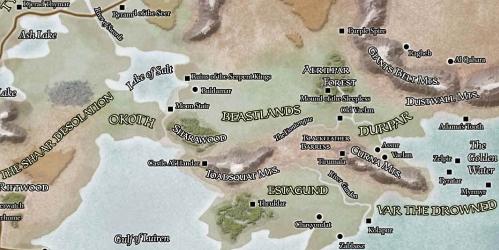
Aerilpar Forest: Known also as the Wood of Dark Trees, this dense jungle is home to all sorts of dangerous creatures. The animate and malevolent trees from which the forest gets its name are numerous, as are venomous flying snakes.
Sharawood: Sandwiched between the northeastern shore of the Gulf of Luiren and southeastern shore of the Lake of Salt, Sharawood abuts the Toadsquat Mountains. The gloomy jungle houses monstrous spiders, drakes, and strange undead
Old Vaelan: The current city of Vaelan is not the original. The first city to possess the name was overrun nearly 500 years ago. Today, Old Vaelan is nothing but a series of grassy knolls and scattered piles of stone rubble.
OKOTH: Reptilian races and humans tainted with serpent blood gather in Okoth, serving their creators. Ruins buried for more then thirty millennia have broken again to the surface during the great upheavals of the last century.
VAR THE DROWNED: Once called Var the Golden for its glorious wheat fields, this land now exists as a drowned, silt-covered field of ruins. The land collapsed beneath the waves in the Year of Blue Fire. Thousands died immediately, and thousands more in the days and weeks afterward. The land was no more.
Description: The Dupar region includes Durpar, Var the Drowned, Estagund, Beastlands and Okoth lands. It rests in the southeast corner of Faerun on the Great Sea. It is due east of the East Rift and south of High Imaskar. Monsters infest the region north of Estagund and Durpar known as the Beastlands. Among the remains of the lost kingdom of Veldorn, the Beast Lords rule this area without mercy over competing tribes and brutal city-states. Each monstrous lord vies against the others for land, power, and prestige. The Beastlands exists in a constant state of low-level conflict. The Beast Lords include undead, dragons, giants, and even beholders, but plenty of humans live here, mostly slaves or outlaws who have fled other realms. Durpar is a frontier region. Most of its lands are menaced by monsters from the Beastlands, marauders from the mountains, and roving brigands. Humans, halflings, kenkus, and other races inhabit Vaelan, Assur, or scattered keeps controlled by independent sovereigns and petty princes. Others live hand to mouth as desperate wanderers. Only the Durpari capital, Vaelan, retains a glimmer of its former strength. Since the ascendancy of the Datharathis, Vaelan has existed in relative peace. House Datharathi keeps its coffers stuffed by taxing the other chakas’ right to trade with Delzimmer, Estagund, and High Imaskar. The ruling house also maintains a standing army, which includes bugbears, hobgoblins, and goblins that were integrated during the Merchant Wars. The kingdom of Durpar lies south of the Raurin Desert, in the southeastern corner of Faerûn. Long thought destroyed by residents of the rest of the con- tinent. The remnants of Durpar’s once wealthy chakas, or merchant houses, survive through trade with Estagund and High Imaskar. Estagund shares a common cultural heritage with decimated Durpar. Its folk are Durpari, who value trade and honor the Adama, a divinely inspired moral code. Beset by enemies, and within reach of few allies, Estagund relies on its noble warrior class and friends in High Imaskar to keep it safe. Estagund endured a few ills in the wake of the Spellplague, but its lands were spared from the devastation. Unlike other states created by the Durpari people, Estagund has been and remains a monarchy. Rajah Jasraj Seltrarir rules with the aid of the Council of Chakas. The rajah is the final authority in the land, as well as the commander of its armed forces. Differing further from their counterpart in Durpar, Estagund’s people honor a class of noble warriors known as the Maquar. The members of this class follow a highly restrictive code of conduct that dictates many aspects of their lives, limiting or prohibiting many activities. In exchange for these sacrifices, the Maquar are freed from the responsibility of providing for themselves so they can devote their lives entirely to the protection of the people. The Maquar form the command structure of the military.
Tirumala: Holy City - Population 10,000 - Situated atop seven “holy hills,” the city-state of Tirumala is ruled by a rakshasa rajah of the same name. Tirumala rebuilt the so-called Holy City from the foundations of a Durpari settlement razed long ago by giants. Rakshasa nobles live here, served by a large force of hill giant and orc soldiers, as well as a spy network of kenkus. The rest of the populace is composed mostly of human, halfling, and kenku slaves. Recently, Tirumala opened trade with Estagund. All folk know that evil rules in the Holy City, so many people suspect that Estagund’s rajah has been magically influenced, if not outright replaced.
Vaelan: Capital City - Population 45,000 - Vaelan, the original crown jewel of Durpar’s trading empire, remains the last bastion of Durpari culture in the region. Dominating its skyline is a central district of over a hundred pale, slender towers that serve as the homes of chaka members deferential to House Datharathi. The tower district—a complex of white-plastered walls, balconies, stairs, galleries, promenades, and open courts—is surrounded by the city proper. Wide streets separate one piece of the mazelike complex from the next, and high bridges arch overhead to connect rooftop gardens. Vaelan maintains all the grandeur of a wealthy Durpari trading city. Even so, Vaelan’s citizens are reminded daily of their precarious position. Goblin soldiers and citizens long included in the fabric of the city are rough, inhuman, and all too privileged, serving as a reminder of how far Durpar has fallen.
Assur: Port Town - Population 5,000 - Destroyed by giants out of the Beastlands, Assur was uninhabited for decades. After the Merchant Wars, Assur was rebuilt more as a military and naval station than a true city. Assur still has a bustling market and enjoys a naturally deep harbor. It also sports a stout wall and a large garrison of human, halfling, and goblin soldiers. These warriors defend the town and patrol the roads and farmland between Assur and Vaelan.
Chavyondat: Capital City - Population 80,000 - Set on the Bay of Kings, Chavyondat houses important centers of government, trade, military, and religion. In the city’s center are Seltrarir Palace and the House of Chakas, where affairs of state are handled. Nearby stands the House of the Vanquisher, central training grounds for all Maquar. The minarets of the House of the Adama rise next to the palace, and within, halflings displaced from Luiren long ago maintain a shrine to Chauntea and Sheela Peryroyl. The largest ward in Chavyondat is the marketplace, where everything imaginable within the morality of the Adama is for sale. Chavyondat’s market gives way to docks on the Great Sea. From these quays, Estagund’s merchant ships sail the Gulf of Luiren west to Delzimmer, north to High Imaskar, and beyond into the Sea of Fallen Stars. They also brave the Great Sea in routes to Calimshan, Amn, and the Sword Coast.
ELFHARROW
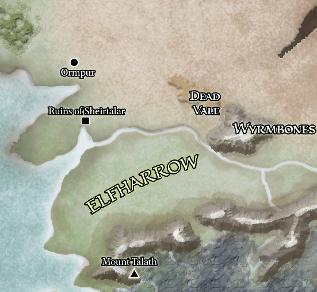
ELFHARROW REGION
Regional Benefit - Elfharrow: Add 2 Ranks in Balance and Survival skills
Alternative Regional Benefit - Chult: You gain +4 to saves against Diseases
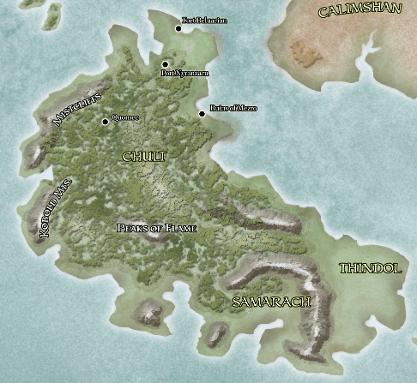
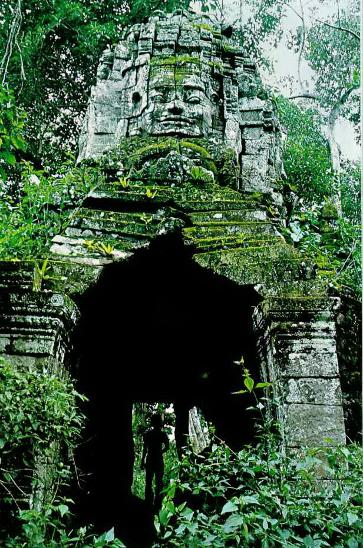
The Dead Vale: Tribal Holy Site - Called the Misty Vale before the rains stopped and the River Talar shifted away from its bed, the Dead Vale remains a place of cultural and religious significance to the wild elves. Once a great forest bathed in the mists of rushing river waters and cultivated by mystics that dwelt alongside, the land is now a bleak graveyard, with dead and blackened trees, ashy soil, and only bones to show that anyone ever lived there. In spite of the melancholy atmosphere, elves explore the Dead Vale, some in search of lost relics, others to chase after their myths. According to elf shamans, the Misty Vale once held a mystical tree named Cuivanu whose sap held potent curative powers. Wild elves cling to the possibility that the great tree survives to this day, lost in the ruin of what is now the Dead Vale. If the elves can find the tree, perhaps they can heal their ruined land and restore the Misty Vale to its former splendor.
North Wall Gap: During the Spellplague, Halruaa was annihilated in a sorcerous blast so mighty that windows in Waterdeep rattled. Along with the wizards’ realm, a section of the North Wall mountains was obliterated. This gap exposed Lapaliiya to spewing toxic waters and uncontrolled wild magic that otherwise might have been contained. In the aftermath, Lapaliiya’s confederacy crumbled, the climate skewed, and eventually, the land of Elfharrow was born. The gap has become something of a totemic icon of the Elfharrow tribes—those who have made the journey within and survived proudly display a gleaming tattoo commemorating the occasion. A few also come back with spellscars. Elfharrow guardians at the edge of the gap allow visitors of all races through, and upon their return apply the insignia of passage. Entering the gap eventually brings a traveler through the North Wall to look upon the face of ultimate destruction
Ruins of Sheirtalar: When the confederacy of the Lapaliiyan city-states existed, Sheirtalar served as its capital. Now brought to ruin by flooding and calamity, Sheirtalar is one of the few places in this area that has managed to retain much of its general size and shape, despite being half sunk beneath brackish water and haunted by nightmarish creatures. The ruins of Sheirtalar and other cities supply the wild elves with stone, timber, and anything else they can carry off before drawing the attention of the many monsters lurking in the sodden buildings or beneath the oily water filling their streets. The Shining City’s gold-and -silver-leafed domes are now half-drowned, cracked, and dulled by a century of fierce weather without upkeep. The famed Domed Palace of the Overking, which once sat high atop a granite outcrop, was pulled into a fissure so deep and twisting that daylight never reaches it. All manner of opportunistic monsters lair in the ruins.
CHULT: Chult is a savage land of fearsome jungles plagued by carnivorous monsters. Human civilization is virtually nonexistent here, though an Amnian colony stationed at Port Nyranzaru and the port at Fort Beluarian sponsored by Baldur’s Gate cling to the northern coasts, and a few tribes—some noble savages, others depraved cannibals—roam the interior. Creatures of every description hunt Chult’s mysterious, continentwide rainforest. Much of what was formerly known as the Chultan Peninsula was drowned almost a hundred years ago. The yuan-ti kingdom of Serpentes fell in the course of the change, the kingdom of Samarach was submerged, and the city of Mezro collapsed into the earth, its population scattered. Disease and parasites are everywhere on the Chultan Peninsula. They are carried by plants with stabbing spines, injected through any of the hundreds of insect bites suffered in a typical day, or borne on jungle mists. Those who drink unboiled jungle water are in for a nasty surprise
The Jungle: Continent-Spanning Overgrowth - Famously mysterious jungles cover Chult. The dense canopy is broken only by the highest mountains and a few great, marshy clearings and grasslands that surround large lakes in the interior. Tavern tales have it that the jungles of Chult are the deadliest places on Toril. Every bush and vine is a strangling, poisonous, flesh-eating, or blood-sucking horror—and under every bush lurks a scaled, taloned, fanged monster.
Description: Surrounded by the wastelands of Halruaa and the western portion of the Shaar Desolation, Elfharrow sits in the south near the Mhair Archipelago of the Shining Sea southeast of Calimshan. Beneath the heights of the North Wall mountain range stretches windswept scrubland that marches to the Shining Sea. Home to tribes of intolerant wild elves and aggressive herds of centaur raiders, Elfharrow is as unwelcoming as it is mysterious. The Elfharrow badlands, known in prior days as the Bandit Wastes, extend as far north as the Dead Vale, as far west as the shores of the Shining Sea, and south and east to the North Wall. Dust devils whip across the sweltering land. Parched plains are dotted with tough brush and thorny bushes. Rumpled hills covered with harsh grass, gnarled shrubs, and the occasional hackberry tree border the region. In the distance rises the towering North Wall, a great barrier between Elfharrow and the vast plagueland to the south (the former nation of Halruaa). Water grows scarcer with each passing year. Rain, when it occurs, is brief and intense, flooding more than it quenches the land’s thirst. The scant vegetation provides little in the way of nourishment and guards its seeds with poisonous thorns. Dead trees scoured white by blowing grit and dust are the only reminders of what this land once was. In spite of the punishing heat and extended dry spells, Elfharrow teems with life. Desert birds, snakes, coyotes, and other creatures subsist on tough fruits and isolated wells of murky water, scratching out a harsh but livable existence. Though the divisions are invisible to outsiders, Elfharrow is carved up into numerous tribal territories ruled by wild elf chieftains. Each territory extends for miles, and the tribes fiercely defend their domains, brooking no trespass from unwanted visitors. The elves mark the borders of their territories with small, rectangular stones etched with the flowing script of the Elven language. Often, these stones are all the notice that travelers have to go by when they cross from one territory into another. Within each territory, the elves erect villages of stone culled from the ruined cities in the west. Perched atop the hills that ring the scrubland, they gain a considerable view of the terrain for miles around, which allows them to watch for enemies. Elfharrow takes its name from the tribal groups of wild elves that laid claim to the wastes. Driven from the Misty Vale during its long death, the wild elves climbed into the hills in search of food, water, and a place to live. Although some argued in favor of moving on, most of the elves had little interest in mingling with other races and contented themselves with whatever good fortune they could find in their adopted wasteland. Although the wild elves are every bit as aggressive as rumor suggests, their violence and intolerance of outsiders stems from self-preservation. However, they have been known to relent on occasion, trading with travelers and even escorting pilgrims to the North Wall to behold the devastation of lost Halruaa. Centaur herds also inhabit Elfharrow. They rarely disturb the wild elves. Other than the elves and the centaurs, Elfharrow is empty of civilized races. The threat of the plaguelands beyond the North Wall and the dangers posed by the haunted cities of Lapaliiya usually keep unwanted people away. Intruders who persist are encouraged, at the points of spears and arrows, to explore elsewhere.
Abn’dak Territory: Northwest Elven Territory - The Abn’dak Tribe, commonly called the “Sea Crows,” claim several miles of coast along the Shining Sea that includes the ruins of Sheirtalar. The Sea Crows live in stone huts on high hills overlooking the scrubland interior and the restless waves of the Shining Sea. Collections of abodes make up a string of tribal villages, each of which contains at least one Abn’dak shaman responsible for communication between villages. Such messages are mostly news of the latest hunts by land or by sea. The Abn’dak chieftain is Seaspark. She is young, having gained the chiefdom from her grandfather, who died while she lay in the womb. Control over the tribe bypassed her parents at her grandfather’s dying request. Seaspark’s grandfather is not around to pass on his wisdom directly, but her mother, the old chieftain’s daughter, teaches her the tribe’s wisdom while Seaspark grows into her role. Most believe Seaspark will rise to the challenge, though she remains untested.
Fort Beluarian: Baldur’s Gate Trade Fort - Population 1,000 - This outpost has weathered much over the years, and twice was completely eradicated by native uprisings. However, Baldur’s Gate retook the fort both times. The high stockades are manned by elements of the Flaming Fists mercenaries. Amn has lately made offers to buy out the city’s interest in the fort. Most suspect that if the Amnians acquired Beluarian, they would merely shut it down so that their competing Port Nyranzaru would control all water traffic to and from Chult.
Port Nyranzaru: Amnian Trade Colony - Population 12,000 - The harbor of Port Nyranzaru was designed with defense as its first priority, because pirates roam the sea north of Chult. Protecting against threats from the interior is just as important, and thus a high stockade wall of stone fronts the jungle, pierced by three well-guarded gates. Amn owns and controls all activity in Port Nyranzaru. Taxes are high, but those lucky enough to be employed by one of the major trading companies live in relative safety inside the walls of this ultimate frontier city. Those not affiliated with any of the trading companies are forced to live in the expansive shantytown beyond the wall. They survive as best they can, dealing constantly with disease and threats from the jungle.
GRAY VALE
GRAY VALE REGION
Regional Benefit - Gray Vale: Add one language of your choice and 2 Ranks in Knowledge (nature) skill
Alternative Regional Benefit - (must be Human) Elturgard: Add 1 Rank in Diplomacy, Heal and Knowledge (religion) skills
Alternative Regional Benefit - (must be an Elf) Evereska: Add Fey language and you gain Arcane Study feat
Alternative Regional Benefit - (must be a Lizardfolk) Najara: You gain +1 damage with your natural weapons
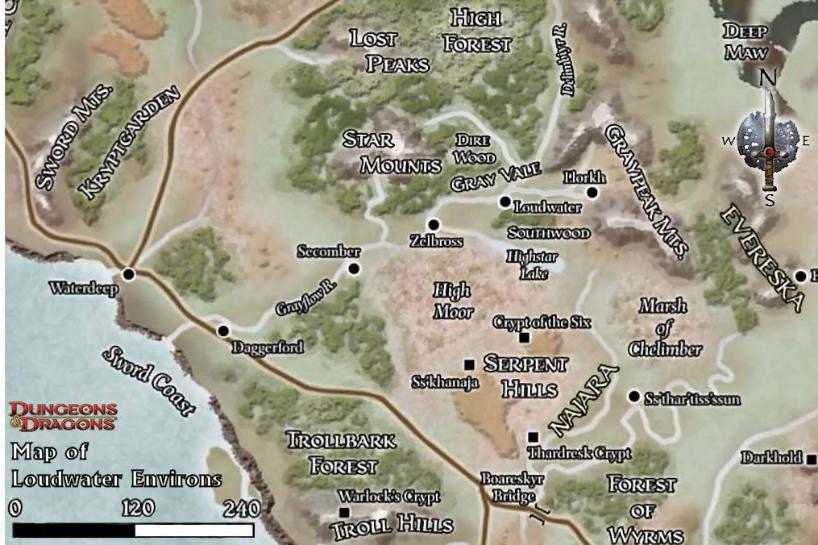
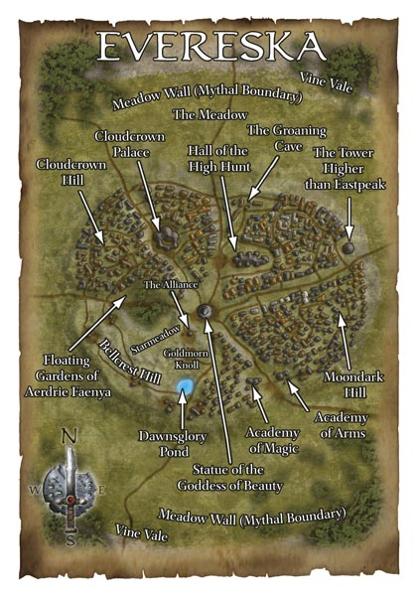
The Star Mounts: This ancient range of mountains marks the southern boundary of the High Forest and takes its name from the queer lights that shine from its heights. Legends claim that these mysterious mountains are home to dragons, elves, strange birdfolk, and more. Perhaps the most unusual story is that in the upper reaches, great crystal towers grow out of the rock. It is uncertain just who or what lives inside these towers (if they even exist), because clouds blanket the peaks year round and few have the courage to ascend the heights.
The High Forest: From the northern slopes of the Star Mounts and stretching for miles to the north is the High Forest, an ancient wood notoriously haunted by fey creatures, gnolls, and drow. Infrequently, wood elves of the forest trade with the people of Loudwater, but they are tight-lipped about what goes on in their sylvan homeland.
The Graypeak Mountains: Sheltering the people of Gray Vale from the distant doom of Netheril is a range of old, rugged mountains known as the Graypeaks. Barren and capped in ice and snow, these mountains are said to be home to giants and vicious wild and unnatural creatures. Adventurers who have braved the peaks report ancient dwarven ruins buried beneath the stone, and their claims are supported by old dwarven coins, weaponry, and other antiquities that have been recovered.
The Lost Peaks: Piercing the canopy of the High Forest north of the Star Mounts are the Lost Peaks, twin mountains as old as the world. Legend tells that these peaks hold the Fountains of Memory, whose waters reflect events of the ancient past.
Southwood: This young forest separates a portion of Gray Vale from the Highstar Lake and the serpent people of the High Moor. Local woodcutters occasionally take timber from this forest but do so at great risk, for a large tribe of goblins has staked its claim here.
ELTURGARD: Elturgard is a theocracy ruled by those who are certain they walk the path of righteousness. The paladins of this land take pride in their moral clarity and pursuit of good. Elturgard is dominated by a “second sun” that hovers eternally in the sky above the city of Elturel, making this a realm of endless daylight. Creatures of darkness cannot abide even the sight of the city. Unlike most countries, Elturgard has a state religion: Torm is revered in the temples that dot the landscape. The cause of Elturgard is just and good, and the paladins who serve it are uplifted by that undeniable knowledge. Their blood is fired with light’s conviction, their minds focused with purity, and their hearts hardened with their faith. Nothing stands in their way—while they grip their sanctified blades; fear is unknown to them. The land with two suns is proud, not infrequently wearing its intolerance as a badge of honor. This realm includes the cities of Elturel, Iriaebor, Scornubel, Triel, and Berdusk. Over the centuries, numerous separate caravan paths coalesced into a well-traveled route along the western edge of Faerûn called the Trade Way. Regular traffic once extended from Luskan to Calimport, but has been truncated since the Spellplague. It now runs from Waterdeep to the southern edges of Tethyr. Parallel to but usually some distance from the coast, the route moves farthest east just north of Baldur’s Gate, where Elturgard paladins guard the crossing at the Winding Water River. Few, if any, of the lands through which the Trade Way passes are completely safe, and caravan guards are in constant demand.
Fort Morninglord: This keep lies a day’s ride west of Elturel, overlooking the River Chionthar. Its entire complement of paladins disappeared one night three years ago in an event that blackened every stone and fused every door and window of the keep. Fearing contagion by the unknown evil that rendered the keep uninhabited, the High Observer sealed all visible entrances behind additional layers of stone and mortar, and proclaimed that anyone who broke this interdiction would become an outlaw of the land.
Reaching Woods: This expansive stand of deciduous trees—mostly elms, maples, beeches, and oaks—seems a pleasant and beautiful forest from the exterior. That is merely a facade. Elturgard has discovered that its inmost secret glades hid shrines to primal entities not approved by the High Observer. The holy sites were tended by elves, humans, and, to the paladins’ dismay, gnolls and goblins. The High Observer, declaring that goblins are vicious creatures and that gnolls serve demons, ordered the forest barricaded. No one can enter or leave, on pain of death.
EVERESKA: Protected by high magic, a powerful mythal, and thousand-foot cliffs, Evereska is a mist-shrouded city of secretive eladrin. Its inhabitants spurned the Retreat to Evermeet, keeping their city hidden from the rest of Faerûn, only to end up at the center of a war between the Shadovar and the phaerimms. One of Evereska’s Tomb Guards unwittingly helped release the phaerimms, bringing Shade Enclave back from centuries in Shadow. That mistake nearly destroyed this city of ancient wonders. A century of relative peace has seen Evereska rebuilt. It has been drawn, despite its reluctance, into a more visible role as one of the three major powers opposing the expansion of Netheril. Evereska maintains its secretive ways; admission to the city is a closely guarded privilege. The Passing—magic required to enter the vale—comes only by invitation from a member of the Hill Elders for outsiders, or through a password for native Evereskans. The various access points to the city are patrolled by the Vale Guard, each contingent led by a kanqat in command of no fewer than a hundred archers. High Lord Duirsar, a trusted, capable, and decisive commander, has served as the leader of Evereska for more than two centuries. Though he long protected Evereska from the outside world, High Lord Duirsar has been working since the phaerimm siege to move toward a more open relationship with the city’s neighbors. He understands the true potential of the Netherese threat, respects the efforts to rebuild Myth Drannor, and has embraced the end of the Retreat. Duirsar commands the Cold Hand, an elite military company drawn from Evereska’s finest warriors. The military might of Evereska is considerable. In the last century or more, it has begun to shift its focus from protecting the city to venturing out—often in company with soldiers from Cormyr and Myth Drannor—against Netherese encroachment. The Long Watch is tasked with extending the military reach of Evereska beyond its protected vale. Skilled archers and powerful battle mages greatly impress any who fight alongside them, and strike fear into those who oppose them. One of the city’s primary missions for centuries has been the protection of its tombs from plunder. That task is in the hands of the Tomb Guard, capable adventurers who are dedicated stewards of the buried past. The Swords of Evereska is a militia composed of nobles. The finest families in Evereska are represented, a fact that makes it clear that no one is above contributing to the defense of the realm. Since the Spellplague, the walls between the world and the Feywild, always thin in Evereska, have grown thinner still. Eladrin pass between planes with ease. Almost entirely rebuilt by Evereska’s high mages after the phaerimm siege, the city’s mythal weathered the Spellplague with barely a flicker. The mythal is semisentient and committed to the protection of the city and its inhabitants. Its magic allows citizens and visitors to walk up and down vertical surfaces (as long as their feet and hands are bare), and covers the city in a protective aura that includes feather fall and other beneficial effects. The mythal also provides protection from enemies in the form of a startling array of offensive spells that makes Evereska among the best-guarded cities in Faerûn, rivaling Waterdeep and Shade.
NAJARA: Nagas, yuan-ti, and lizardfolk inhabit this monstrous realm. Najara encompasses the eastern reaches of the High Moor, the Serpent Hills, the Forest of Wyrms, the Marsh of Chelimber, and the river valleys that meander through the area. Its center lies in the Serpent Hills. For all its size, the existence of the realm remains a point of debate, because it is not a state or country in the human sense of those terms—the monstrous denizens of the region don’t patrol their borders or carry on any sort of commerce or relations with nearby lands. The reigning King of Snakes is Jarant, who slew the previous king Ebarnaje five years ago in a struggle that put Najara on the map—at least as far as the realms of Elturgard and Evereska are concerned. The short internal civil war that preceded the power change saw great activity among the yuan-ti and lizardfolk of the area. The border nations had clear cause to be concerned that war was mounting from the long-slumbering marshes and hills.
Forest of Wyrms: Despite the underlying rocky terrain, the Forest of Wyrms is composed of great redwoods and thick pines that soar to staggering heights. All manner of serpents reside therein. Small communities of yuan-ti are common, and the place is home to several youthful green dragons, whose alliance with the yuan-ti is tenuous at best. Several locations of interest lie in the forest, including Ss’thar’tiss’ssun, one of the most ancient ruins in Faerûn, and Thlohtzin, an old lich stronghold turned slave citadel by its new yuan-ti residents. Although most steer clear of the ancient ruin, sinister human and tiefling slavers travel to Thlohtzin to sell their merchandise for ancient gold. The slaves are then reapportioned throughout Najara.
Serpent Hills: These rocky hills and difficult ravines roll along a great expanse, broadening to the west until they fade into the High Moor. Great mesas and red-clay earthmotes dot the sky. The Serpent Hills ripple in spectacular color, alternating between dark black coal and green coppery tints, not unlike a snake’s scaled hide. The ravines between the clawing hills contain dying scrub brush and dry riverbeds that only a few years ago trickled with water. The land has turned crueler since. Crypts dot the landscape, dating back to the era following old Netheril’s fall. Some ruins are vacant, their underlying crypts sealed. Many are home to lizardfolk, nagas, and yuan-ti, all ostensibly subjects of the King of Snakes. The breached tombs have been plundered and form part of a network called the Serpent Tunnels that extend beneath the hills. This conduit for Najaran business is home to yuan-ti that find the surface too dry.
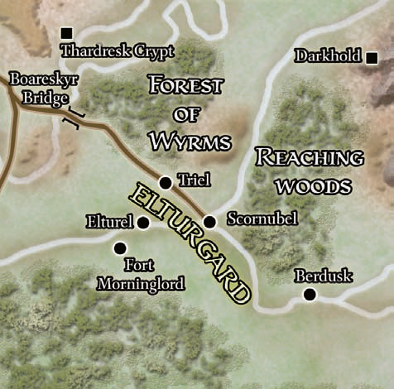
Description: Beneath the mysterious Star Mounts, at the southern edge of the ancient High Forest, the Gray Vale straddles the river Delimbiyr in the North. A prosperous region thanks to river traffic, merchant caravans from distant lands, and other travelers looking for treasure amid the wreckage of lost kingdoms. Gray Vale has grown into a trade center in the North in large part due to the success of Loudwater. This small town has an advantageous location at the confluence of the Delimbiyr and Grayflow rivers. Rich and arable farmland enables the community to thrive. Most merchants in the vicinity use the river to transport goods, making Loudwater an ideal nexus for nearly all commerce in this part of the world. Although Loudwater and other small settlements enjoy some prosperity, the threat of danger checks their growth. Displaced savages from beyond the High Forest are a constant peril. Goblins infest the Southwood, snatching cattle, supplies, and the occasional child before retreating to the dim shelter of their foreboding forest. Whispers of Najaran serpent-folk fill the taprooms as locals peer suspiciously at strangers, ever watchful for these sinister infiltrators. All of these dangers and more cast a pall of fear and mistrust over Gray Vale. Gray Vale’s borders are the Star Mounts as its northern boundary, the rugged Graypeak Mountains as the eastern border, and the High Moor as its southern perimeter. The Vale stretches west, following the Grayflow out to the Sword Coast, though the influence of the area thins as one draws closer to the Western Heartlands. Unlike other areas of the North, the people of Gray Vale are decidedly mixed, blending cultures from all over the region. But humanity has a slight edge, and most humans have fair skin, hair that ranges from blond to light brown, and the full range of eye colors (though hazel is dominant). A proud people, they are self-reliant, tough, and grizzled, accustomed to the hardships that press against them. Most folks are farmers, though plenty of miners try their hand at coaxing more out of the old mines of the Graypeaks. Half-elves comprise another large group of the Gray Vale population. Like the humans of this area, the half-elves have fair skin and light hair. Although most retain signs of their elven heritage, years of human and half-elf marriages have diminished these traits until most half-elves could pass for human. In addition, one can find a number of dwarves, drawn to Gray Vale to reclaim their lost holds. Half- ling fisherfolk work the river, living alongside their human allies. The region even has a smattering of eladrin and elves, though most members of those races encountered in the Vale hail from the High Forest to the north.
Loudwater: Easily the largest settlement in Gray Vale, Loudwater is encircled by a wall of timber and stone more than 20 feet high. The fortifications and the determined but personable people living here make Loudwater an attractive stop for travelers of all kinds.
Llorkh: Ever an unsavory place, Llorkh has sharply declined in recent years. A string of incompetent rulers drove off most of the honest residents, and now the ruined city serves as a haven for a self-styled bandit king and his lackeys.
Elturel: Capital City - Population 17,000 - The city of Elturel rests atop a cliff that dominates the River Chionthar. A shining orb hangs like an eternal promise directly over the city’s center, providing a golden companion to the sun’s light by day, and reassuring sunlike illumination by night. The heatless second sun is called the Companion or Amaunator’s Gift, though no one but the High Observer knows if the object was truly bestowed by the sun god. Whatever its provenance, the Companion’s illumination suffuses the city, and undead of every sort are burned by its touch. Elturel is the capital of the wider kingdom it claims. The city is ruled by the High Observer of Torm, who keeps order within the city and the wider realm through a knighthood of paladins who share Elturgard’s goal of one day bringing righteous judgment to all Faerûn. Numerous citizens dream of joining the knighthood, and many succeed. Though not all serve the same god, all have sworn oaths to Elturgard and wear the blazing insignia of the Companion. As in previous generations, Elturel sees to it that the city and surrounding lands are the safest, best policed, and most efficient trading and farming community in the Western Heartlands. Caravans and riverboat convoys dread tying up in Elturel. More than anywhere else, travelers must be on their guard lest they use profane language, joke in an impious way, or otherwise accidentally anger the righteous port officials. Taxes are high for such offenses, and penalties include stripping a trader of the right to enter the city.
Scornubel: City of Caravans - Population 14,000 - Scornubel is a sprawling swarm of mercantile activity along the north shore of the River Chionthar where it meets the River Reaching. Caravans of all nations, organizations, and trading costers are welcome as long as they abide by the rules of good business. The paladin citadel visible from most points in the city is a constant reminder to those who might try otherwise. Dirty dealing in Scornubel can lead to severe punishment. Its earlier rulers chose profit over ideals, but the exact opposite is now true. Scornubel’s fortunes nearly failed in the decades following the Year of Blue Fire, when trade across Faerûn essentially fell to nothing. But the City of Caravans found a strategy to survive when it was nearly wiped out by destitution and starvation: The elders of Scornubel allowed it to be annexed into the realm of Elturgard. A contingent of paladins rode into the city, and it was saved. Over the last few decades, Scornubel has regained much of its former mercantile vigor, but the permanent citadel Elturgard built at the city center, brimming with paladins, has changed its overall tenor.
Iriaebor: Free City-State - Iriaebor, just east of Berdusk, is still an independent and strong city-state, despite the best efforts of Elturgard to bring it into the fold. The City of Thousand Spires is not free of Elturgard’s influence, however. Where competing states might seek to overrun a rival through force of arms, Elturgard attempts to woo Iriaebor with gifts, largesse, and promises of safety, all delivered by sun-blazoned paladins. Some merchants of the city freely accept these gifts, even going so far as to allow small companies of Elturgard knights to stay in their guest towers. More than a few see this as a threat, but others say the resident paladins are gracious and handy to have around when true evil is afoot.
Evereska City: Large City - Population 22,000 - Evereska is built on a lofty mesa nestled in a valley surrounded by high hills. The Three Sisters are towering marble cliffs a thousand feet tall, upon whose plateau the city glistens. Its winding streets and towering structures have changed little in thousands of years. Buildings carved of granite and marble are merged with living plants. The air smells of moss, leaves, and flowers. Streets paved with marble extend up the vertical sides of great towers. The eladrin wander over every surface, occasionally flying or levitating from place to place. The Hall of the High Hunt is an imposing structure of soaring marble minarets and vine-covered arches where the Hill Elders hold court. This council of the most learned eladrin includes fierce warriors, high mages, and nobles born of families that were old when humans still wielded bone clubs. Evereska has a number of temples devoted to gods worshiped by the fey. A statue of Hanali Celanil rises hundreds of feet above the city center, and the aweinspiring Floating Gardens of Aerdrie Faenya provide a tranquil respite. Though confusion accompanied the revelations that Hanali Celanil was in fact the elven aspect of the goddess Sune and that Aerdrie Faenya was none other than the primordial Akadi, the worship of the goddess of beauty and the Lord of Sky Home are still major parts of life in Evereska. Both Sune and Akadi must surely be pleased by Evereska, which combines jaw-dropping beauty with stomach-dropping heights. Nothing is close to the ground here, and towers compete with each other to scrape the clouds. The tallest structure in the city is the Tower Higher than Eastpeak, which is so named because it’s taller than the mountains east of the vale that sometimes block the rising sun. The Academy of Magic and the Academy of Arms are sponsored by the high mages and the Long Watch, respectively, and no finer wizards or fighters can be found in the world. Possessed of extraordinary power, the high mages of Evereska keep their lore a closely guarded secret.
Ss’thar’tiss’ssun: The sarrukh, the yuan-ti progenitor race, built this temple-city thirty thousand years ago, making it one of the oldest ruins in all Faerûn. Ss’thar’tiss’ssun was abandoned after the death of the deity it was built to exalt. It stood sealed for thousands of years until it was restored by the ancient naga Terpenzi and its followers, marking Najara’s first flowering. However, in the Year of the Moor Birds (90 DR), the Shadowking and other Netherese wizards slew Terpenzi and partially razed the city. Humans briefly inhabited the land above the ruins, but their habitation, called Serpent’s Cowl, now stands empty. The surface dwellers were annihilated when the Netherese wards designed to keep out serpent kin failed roughly a hundred years ago. The Shrine of the Cowled Serpents lies in the heart of ruined Ss’thar’tiss’ssun. Over the last century, yuan-ti have uncovered the shrine and often visit the location.
THE GREAT DALE
THE GREAT DALE REGION
Regional Benefit - The Great Dale: Add 2 Ranks in Knowledge (nature) and Survival skills
Alternative Regional Benefit - (must be Human) Narfell: Add 2 Ranks in Ride skill and gain 2 cold resistance
Alternative Regional Benefit - (must be Human, any Elf or Tiefling) Rashemen: Add Fey language and gain +4 to Diplomacy checks involving Spirits
Alternative Regional Benefit - Thesk: Add 1 Rank in Diplomacy, Bluff and Sleight of Hand skills
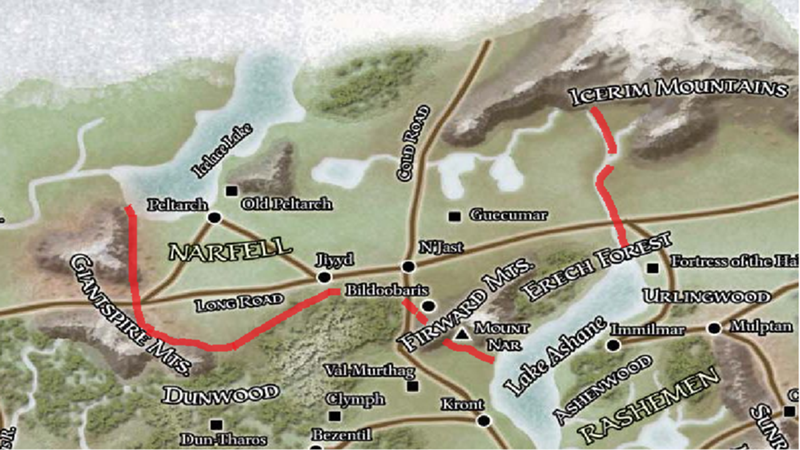

Dunwood: Demon Haunted Northern Forest - The northern forest is a demon-haunted wilderness, blighted by centuries of spreading taint and the rites of dark druids. The Dunwood forms the northern border of the Great Dale, weaving its way south of the Giantspire Mountains and the plains of Narfell until it peters out near the Cold Road in the east. Once the Dunwood was a northern twin to the Forest of Lethyr, but then the Rotting Man disturbed the wreckage of DunTharos, the ancient Nar capital. Now the blightlords and the Rotting Man are no more; ageless demons in their hundreds stir within Dunwood instead. The Nentyarch of Yeshelmaar is occupied in a fierce contest against the demons of Dun-Tharos. His greatest wish is to eliminate them entirely, but this goal is slow in coming.
Forest of Lethyr: Druid-Guarded Southern Forest - The southern forest is a true wilderness, home only to secret wood elf villages. Foresters from the Great Dale and Thesk regularly visit the outer fringes of the forest, but the depths remain largely unexplored. The Forest of Lethyr occupies the southern half of the Great Dale and provides a natural boundary between the Great Dale and Thesk. The forest is rich in wildlife, including bears, wolves, big cats, deer, rabbits, and all manner of birds, squirrels, and other treeloving animals. Druids, rangers, and other folk of the woodlands answering to the Nentyarch guard the boundaries of the Forest of Lethyr. Several treants also roam the wood, dedicated to finding and dispatching demonic infections from the north.
NARFELL: Far north, well removed from the major byways that cross the more hospitable lands of Faerûn, lies frozen Narfell. The region is a desolate wasteland of ice and snow, buffeted by raging storms. Nomadic tribes prowl the countryside in search of resources and sup- plies, taken from the herds they follow or the people they meet. Wintry storms blow death into Narfell from the frigid north, and the temperatures plunge deeper each year, scouring the land of all but the hardiest flora (tough grasses that survive year round) and fauna (herds of reindeer and wild oxen being the most common). Narfell was not always as it is today, as evidenced by the ruins dotting the landscape. Most scholars and historians recall an older empire, a mighty nation that claimed these lands and beyond but eventually fell to death and decay as the result of moral corruption and fell dealings with sinister agencies. The Nars do not linger in or explore these ancient monuments. Many explorers share tales of vicious demons and other revolting creatures stalking the isolated remains of the region. Narfell is mostly tundra blanketed under a thin crust of ice and snow. The windy conditions prevent too much snow from accumulating on flat terrain, allowing herds to feed on the tough brown grass that pokes through the crust. The dense Dunwood marks the land’s southern border, and the Giantspire Mountains mark its western extent. To the east, rugged Mount Nar scrapes the sky and reflects the pale sun on its blue glaciers. From the backs of tall, shaggy horses, nomadic folk hunt reindeer and wild oxen. Calling themselves Nars, these fierce riders and archers supplement their resources by raiding west into Damara, south into the Great Dale, and even into northeastern Thesk. More often, though, the tribes fight among themselves. Nars are short, stocky people with swarthy skin and black hair. Pureblood Nars have angular features and dark eyes, though many show signs of ancestry that traces to Damara or Rashemen. Nars are famed horsemen, more at home in the saddle than on their feet, and they breed exceptional horses whose strength, speed, and endurance are valued far beyond Narfell’s borders. The ancient nation that preceded this frozen waste was notorious for consorting with extraplanar beings. The results of these dealings left many Nars tainted by darkness, and some became tieflings as a result. In fact, tieflings have long lived among the tribes of Narfell, but in recent years, they have grown in numbers and influence. Some people speculate that a new interest in the ruins of Narfell has its origins among the tieflings and heralds the rise of that race to greater power, though no one can say with certainty what the results of such exploration might bring.
Giantspire Mountains: Giantspire Gap - The Giantspire Mountains get their name from the small tribes of hill and stone giants that wander them. Ogres are also common here. Still, hobgoblins and bugbears far outnumber the larger brutes: Goblins truly rule the mountains and its pass. In fact, the most powerful goblin tribes include ogres and even giants. A few tribes vie for position here. Garnuuk rules the Blood Mountain tribe, a savage bugbear clan known for headhunting in the pass and along eastern Damara. The Razor Heart clan, through the machinations of its queen, the hobgoblin Maaqua, has ties with Damara and a right to “tax” the Giantspire Gap.
Guecumar Ruins: The bloodthirsty Nar tribe known as the Creel is encamped around these ruins. Their chief, Tur, follows the commands of the tribe’s witch, a tiefling named Sylanth. Tur’s warriors protect the permanent camp and fend off raiders from passing tribes, who see the Creel not only as taboo-breakers, but also as potentially wealthy targets.
RASHEMEN: Rashemen is a rugged land of hardy and fiercely independent people. Rolling hills and sparse pine forests cover the southern areas, giving way to barren plain in the north and cold, deep lakes to the east. The far north contains only snowcapped mountains. The southern half of Rashemen is more hospitable and has more varied features than the north. Rashemi are fiercely tied to ancient ways practiced for over a thousand years. Warriors call up a feral rage against foes. Wychlaran hathrans (learned sisters) cast spells of wild power. The Wychlaran wield magic tied to the land, and they train those with power to serve Rashemen. Male spellcasters, called Old Ones since many live to a staggering age, are few. They excel in itemcraft and rituals. Although Iron Lord Mangan Uruk ostensibly rules Rashemen, true power lies with the witches. It is they who choose the Iron Lord. They protect and teach this potent commander, and they can remove him from the throne at will.
Ashenwood: Ancient Spirit Forest - Eastern Lake Ashane cradles the Ashenwood, an untamed woodland inhabited by wild creatures. This evergreen forest is also home to the largest concentration of spirits and fey in Rashemen. Great wisdom or terrible vengeance can come from these creatures, depending on an interloper’s actions. Tradition holds the Ashenwood sacred, so it remains unsettled. Ettercaps, werewolves, and trolls also inhabit the forest. Some of these creatures are legendary among the Rashemi for their age, cunning, and size. Most prominent is Dar-Guran, a fell troll who can take off a human’s head in one bite. Benevolent creatures also inhabit Ashenwood. Intelligent animals speak to the spirits and watch over the lost.
Urlingwood: Mystical Heart of Rashemen - Witches control Urlingwood. Here they hold secret meetings, commune with spirits and fey, make offerings to benevolent spirits and the Three, and bind hostile entities. They initiate young Wychlaran and Old Ones here. Within Urlingwood, the witches also brew jhuild, the famous Rashemi firewine. Only Wychlaran and Old Ones are allowed to enter Urlingwood. The penalty for violating this prohibition is death, and no exception is indulged. Because of this extreme law, the Iron Lord’s berserkers patrol the forest perimeter, warning away interlopers. Spirits, fey, and other creatures loyal to the witches guard the forest interior, making good on the promise of death to intruders. Those whom the guardians can’t defeat, they report to the Wychlaran. Strong wards keep particularly sensitive areas safe.
Erech Forest: This forest in the shadow of Mount Nar and the Firward Mountains is considered part of Rashemen. Dark spirits and wicked fey inhabit these gloomy woods, as do angry ghosts of fallen durthans and Nar raiders.
THESK: Thesk sits on the northeast shore of the Sea of Fallen Stars. It is just on the south side of the Forest of Lethyr and runs south until the Dragonjaw Mountains border the coast of the Sea of Stars. Nicknamed the Gateway to the East, Thesk is where the fabled Golden Way trade road begins. From Telflamm to Mulsantir, this road is filled with caravans carrying all sorts of goods and people from Kara-Tur. Theskians are tolerant and imperturbable people. Exotic persons and diverse customs are normal where east meets west. In light of the Rashemi suspicion of foreigners, Thesk seems a welcoming place to settle. It even boasts a few civilized orcs, remnants of war against the Tuigan Horde. About half of Thesk’s human population is made up of Shou humans from KaraTur. The other half is people of mixed Damaran and Rashemi blood. Many nonhumans also settle in Thesk to seek their fortune, such as elves from the Forest of Lethyr, gnomes from the Dragonjaw Mountains, and goliaths from the Thesk Mountains. Thesk is a land rich in opportunity. Money is the only true authority here. Each settlement has a council of oligarchs to rule it, and the most prominent of these rulers form the Council of Thesk. Within Thesk, those who have the ambition and ability can rise to power through guile or heroics without the need for blue blood. Powerful criminal gangs and plans are deeply entrenched in Theskian cities and commerce, offering another sort of challenge or opportunity. Most of Thesk is an empty plain; the nation’s major settlements crowd the Golden Way. Recently, Szass Tam’s forces have built roads to and fortified the broken towns of Nethentir, Nethjet, and Surcross. Theskians eye these developments with apprehension.
Dragonjaw Mountains: Coastal Range - These peaks rise starkly on Thesk’s southern border, forming a sheer wall against the Sea of Dlurg to the south. In the west, the range forms a sharp peninsula called Cape Dragonfang, which ends in a tall mountain called the Dragon’s Tooth. Sailors use the peninsula and the Dragon’s Tooth as landmarks. Shy gnome clans inhabit the whole Theskian part of the Dragonjaws. These gnomes avoid strangers and ambush anyone who resembles a Thayan. They farm alpine meadows and caverns, and mine the mountains for riches, which some of them trade in Milvarune, Ethvale, and Phent.
Thesk Mountains: Inland Range - Steep but short, the Thesk Mountains rise quickly from the plains to a height of about 7,000 feet. Landslides and subsidence are common, so travelers who aren’t experienced mountaineers face grave danger from the environment alone. Strange ancient roadways weave through the crags, built by an unknown people and broken by the ravages of time. The Thesk Mountains shelter native hill giants, ogres, goblins, and goliaths, as well as orcs descended from those who fought the Tuigan Horde.
Description: The Great Dale is the vast, windswept vale that divides two enormous forests, the Dunwood to the north and the Forest of Lethyr to the south. Narfell is north of the Great Dale and Rashemen is to the east across Lake Ashane. To the south of the Forest of Lethyr is the kingdom of Thesk. The druids and other folk who inhabit the great rocky tor of Yeshelmaar are all that stand between the sparsely settled, wild southern woodlands and the festering evils of the northern forest. Rumpled ridges of bare rock rise from the thin soil, growing steeper and more rugged to the north and south as one climbs toward the forests that flank the vale. Fierce winter winds scour the land during the cold months, and all year long the Great Dale is a desolate land. Leaving aside trade towns, the only major settlement is Yeshelmaar. Trade has collapsed along the Great Road, leaving the defenders of Yeshelmaar as the last bastion of civilization in the Great Dale. Demons that were bound beneath the Dunwood by the long-fallen Empire of Narfell now stalk the northern forest and threaten to overwhelm the wild reaches of the Forest of Lethyr. The southern woods are home to hidden wood elf villages and a handful of human settlements along the border with Thesk. The Great Dale is divided into three major regions: the Dunwood, the Forest of Lethyr, and the open lands between the two. The remnants of relatively recent settlements lie along the crumbling Great Road that runs west to east through the heart of the region. Centuries-old ruins harkening back to earlier eras largely lie beneath the boughs of the two great forests. Though few in number, the inhabitants of the Great Dale are hardy folk who respect and love wild expanses of nature. Most are humans or wood elves, though half-elves and shifters are not unknown. The trappings of civilization are viewed with scorn and a small amount of fear, as the detritus of ancient cultures still taints the land with a legacy of evil and despair. Because Yeshelmaar is largely cut off from the outside world, visitors to the stronghold are viewed with a healthy degree of suspicion. Anyone suspected of dealing with demonkind, or of the wanton destruction of nature, is summarily dispatched.
Bezentil: Trade Post - Population 200 - This walled village serves as a way station along the Great Road. On nights of the full moon, packs of wolves assemble outside the walls in a gathering known to residents as the Great Howling, which usually is followed by a series of attacks on travelers in the region. Mostly overgrown now, the Great Road runs through the dale from Uthmere to the crossroads of Kront. It passes through this walled village, which serves as a waypoint for travelers and caravans. Five-foot-high stones, carved with a tree-in-circle mark, stand on the road to Bezentil, signifying that the crossroads is under the protection of the Circle of Leth.
Kront: Trade Village - Population 400 - This rough frontier village at the eastern end of the Great Dale remains free, despite regular raids by warriors from Narfell. Kront is ruled by Lady Chinilvur, the scion of a minor Impilturan noble house. The first glimmer of civilization along the Cold Road from N’Jast in Narfell, Kront stands on a crossroads that leads to Two Stars in Thesk. Despite raids from far-roaming Nars, the rough frontier village still stands. No lord higher than the current Lady Chinilvur, of an Impilturan noble line, claims dominion over Kront. The Chinilvurs would have built the town in the Ashanath on Lake Ashane, but that stretch of land is prone to unnaturally regular and severe tornadoes.
Uthmere: Trade Village - Population 400 - A walled trading post surrounded by small farms is all that remains of this former port city, which once marked the western terminus of the Great Road. The Easting Reach withdrew as the Sea of Fallen Stars receded, leaving this former port landlocked. A major earthquake then finished the city. Most citizens fled to Impiltur. A walled trading post still stands along the Great Road and the Dalestream here, surrounded by small farms. The Hall of the Just, once a temple to Tyr, is the town’s authority. Uthmere’s streets are safe, and a traveler can expect fair treatment in the village.
Yeshelmaar: Trade Town - Population 2,000 - This outpost stands on a sheer-sided hill that rises from the southern forest next to a small lake. The stronghold is notable for its tall, elf-carved spires linked by curling stairs that seamlessly blend into the original stone of the volcanic plinth. Massive stone planters holding ancient trees line the hillside, giving the fortress the appearance of a graceful, protruding section of the forest floor. Yeshelmaar is now the seat of power of the Circle of Leth, ruled by the Nentyarch and his High Druids. The Nentyarch guards the wild Forest of Lethyr and seeks to reclaim his seat in the demon-haunted Dunwood. Near the center of the dale, a great tor rises from the forest. A pristine lake of clear, cold water stands at the foot of the hill. Carved into the tor is an old stronghold known as Yeshelmaar, built in a day when the Lethyr fey faced off against threats from Narfell. During the wars with the Nars, Yeshelmaar grew higher and deeper, until the original tor was obscured. Now it is difficult to pick out the transition between the natural stone of the hillside and elven engineering. Trees root in earth-filled stone planters on nearly every level surface, providing soothing breaks in the otherwise stern stonework. Green ivy grows over the sides of every wall. The Nentyarch and his Circle of Leth formerly dwelled at Dun-Tharos, but the Rotting Man and his blightlords drove them out. Yeshelmaar became the Nentyarch’s seat-in-exile.
Bildoobaris: Trademeet - Population 30,000 (summer) - During the majority of the year, this place is nothing more than a vast stretch of flat land cut by winding draws. When summer sun makes travel easier and fills the gullies with meltwater from nearby Mount Nar and the Firward Mountains, Nar tribes gather in Bildoobaris for a festival of the same name. At that time, miles of hide tents fill the plain, mingled with the finer temporary abodes of foreign merchants. The Nars drink, feast, and trade. Marriages are arranged and stories are swapped. Through an intertribal council, the tribes make common policy, each voting according to its size and the number of riders it can muster. The current ascendant tribe is the Harthgroth. During Bildoobaris, Nars also sell horses, native craftwork, and ancient treasures to foreigners. They trade for armor, clothing, jewelry, weapons, and even food and exotic drink. Merchants must be wary, however, because any Nar who feels cheated might become violent.
Jiyyd: Crossroads Village - Population 500 - A rough collection of squat stone buildings and hide tents, Jiyyd is a trading center. It boasts the first available services along the Long Road past the Giantspire Gap, set where the road to Peltarch meets the Long Road. Passing Nars, traders from Peltarch, and even a few goblins come to Jiyyd to barter. Foreigners and natives alike take advantage of the village’s largest feature, the Delyth Caravanserai, which is operated by a family that moved from Damara long ago.
N’Jast: Crossroads Village - Population 500 - Much like Jiyyd, N’Jast is a trading settlement nestled at the point where the Long Road crosses the Cold Road, a passage from remote villages and dwarfholds near the Icerim Mountains all the way to Nethentir in Thesk. N’Jast is a stopover for Nars and merchants on their way to Bildoobaris.
Peltarch: Port Town - Population 2,000 - The only sizable permanent settlement in Narfell is on the southern shore of Icelace Lake, a body formed by runoff from the Great Glacier to the north. The Nars of Peltarch, mostly of the Ulyoon tribe, fish the lake. They also welcome the few winter caravans that cross frozen Icelace Lake instead of braving the snow-choked and goblin-infested Giantspire Gap in the winter. Through food trade and intermittent traffic, the citizens of Peltarch have become wealthier than their kin, and other Nar tribes consider them outlanders. Stone for the buildings and walls of Peltarch was taken from an older ruin that lies to the north, which the Nars call Old Peltarch. Peltarch has had its share of strange occurrences, dark spirits, and overly aggressive animals—especially cave bears and dire bears. Many Nars blame these troubles on the ruins and the transported masonry.
Immilmar: Capital City - Population 25,000 - The Iron Lord’s citadel, built upon an ancient Nar fortification, stands at the center of Immilmar on the shore of Lake Ashane. Ambassadors and merchants come here to deal with the Rashemi. Most of the buildings within the city are sturdy lodges, far different from the grim keep of the Iron Lord. They are formed with steep sides and a central peak, created by stout timbers embedded in the ground. These buildings are covered with earth and have grass growing over them, similar to structures all across Rashemen. Important locations are simply more elaborate lodges. Witches Hall is a whitewashed and elaborately carved affair closed to all but the witches. The House of the Three, in which Chauntea, Mielikki, and Selûne are worshiped as the Rashemi pantheon, has a central garden court open to the sky.
Mulsantir: Trade Town - Population 7,000 - Trade might be queen in Mulsantir, but war is king. Ferries extend the Golden Way here from Two Stars in Thesk. During winter, caravans can cross the ice of Lake Mulsantir. Thayan advances into Aglarond and movements on the borders of Thesk haven’t gone unnoticed in Rashemen. Thay has besieged Mulsantir three times in the past, but the town has never fallen. It sports three rings of walls and the most stone buildings in Rashemen. Mulsantir is home to magic warships called witchboats, as well as numerous rage-fueled warriors.
Urling: Village - Population 400 - When not on business within Urlingwood, many witches reside in this village. The community looks to be little more than a grove of primeval trees punctuated by grassy mounds. The hills are the lodges of the Wychlaran, their spouses, and their servants. Unlike Urlingwood, Urling is open to common folk. Some of the most potent magicians in eastern Faerûn live here, including Lady Rameena, the most dangerous witch in Rashemen.
Phsant: City - Population 30,000 - Where the armies of the western alliance put down the Tuigan Horde, Phsant is the cultural center of Thesk and a layover point for most who travel east or west. Its diversity is astounding, even for Thesk. Thesk supports a large population of civilized orcs and half-orcs, and Phsant has the largest population of orc-blooded citizens in the nation.
Shou-Town: Phsant is also home to the biggest population of Shou people in Thesk. Like every Theskian settlement, it has a city ward dedicated to Shou culture, but Phsant’s Shou-Town is the largest in Thesk. Anyone seeking an aspect of eastern culture can find it here. One such societal element is the criminal one—the yakuza came to Thesk along with their more honest kin. Yakuza disdain outright theft, preferring other illicit activities and violent work, such as assassination and intimidation. Nonetheless, they clash with the Shadowmasters in Phsant and elsewhere.
Telflamm: Port City; Population 40,000 - Telflamm is Thesk to most outlanders. Even though the Council of Thesk recognizes no one settlement as the nation’s capital, Telflamm’s prominence makes that point moot. Founded by the Balindre Impilturan noble house (whose company, the Royal Company of Shou Lung, also pioneered much of the Golden Way), Telflamm is as far into Thesk or the East as many ever travel. A prince of the Balindre line once ruled here, but with the death of that line’s final scion, Telflamm passed into oligarchy. Its Merchants’ Council now manages the city’s affairs, and the council’s leader is given stewardship over old Castle Balindre. The powerful criminal guild known as the Shadowmasters, servants of Shar and users of shadow power, is the real authority in the town, but it allows the council and its leader to maintain the appearance of working against corruption.
HIGH IMASKAR
HIGH IMASKAR REGION
Regional Benefit - High Imaskar: Add Arcane Study feat


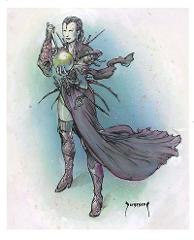

Plains of Purple Dust: Desert Borderland - A vast desert of purple dust that creeps ever westward. Almost as if alive, the desert extends its tendrils beyond the Giant’s Belt Mountains, blowing against the eastern slopes of the Dragonsword Mountains, and stretching toward the lands held by High Imaskar. As far as deserts go, the Plains of Purple Dust is every bit as inhospitable as other wastelands in Faerûn. However, the odd nature of the ubiquitous sand carries a magical taint that poisons the land wherever it flows. Thus, it destroys grasses and trees and drives off indigenous life, creating a vast realm of purple emptiness. This desert is an extension of Raurin to the east, smothered beneath a cover of ash and sand. The Plains of Purple Dust might appear to contain little more than shifting dunes, but it does harbor life. Burrowing deep beneath the desert are massive purple worms, terrifying creatures noted for their ravenous hunger. If rumors can be believed, the purple worms sighted on the fringes of the Plains are small varieties, and far larger breeds hunt in the deep desert, snatching their prey from the air as they leap forth from the sea of dust. The worms hunt all creatures but prefer the High Imaskari patrols that skirt the desert’s edge. Much bigger worms have been seen on the horizon; no patrol chances the deep desert. Now and again, great tornadolike dust devils emerge from the plains, moving in a direct line toward Skyclave. The massive whirlwinds always die out miles before they reach the spire, if indeed that is their true destination.
MURGHOM: Between the high plateau of Thay and the Dust Desert of Raurin lies the land of Murghôm. Murghôm shook free of Mulhorandi bonds when that nation collapsed, only to fall under the dominion of fiercer masters—the dragon princes. Murghôm’s cities and settlements are ruled by mighty dragons. Each dragon prince claims a particular village and the region around it. Most are served by a retinue of human viziers, mercenaries, advisors, and chamberlains. Humans not part of a prince’s coterie view those who willingly serve a malicious dragon as traitors and betrayers. Some dragon princes are benevolent, others distant, and a few downright nasty. Some require the name of the city they rule to be changed to their own; others don’t care, as long as they receive monthly tribute in gold, jewels, and food. Dragon princes regard dragonborn with suspicion, knowing most of them have little love for draconic kings. Dragon princes are alert for landless wyrms looking to find a town of their own. The landless search for princes weak enough to pull down and replace. Some dragon rulers seek to expand their holdings to more than one city. They might send humanoid mercenaries to burn the farms of another prince’s people, or to kidnap and enslave them. Neither princes nor the landless ever send mercenaries directly against another dragon. An unspoken rule requires that humanoids remain in awe of dragons—nothing should be done that would embolden the subjugated or make them believe they could mount a credible threat against a dragon. Despite the low-level conflicts that arise between princes from time to time, none has yet actively sought to rule all the land as the first dragon king. Sometimes the princes gather in a Council of Wyrms to discuss worrying events. By tradition, the council is held in hidden Dracowyr, an earthmote miles above the Great Wild Wood. Dragon does not fight dragon in Dracowyr.
Dracowyr: Earthmote over Great Wild Wood - This mass of land floats unsupported 5 miles over a forest known for its vicious beasts. The mote is a mile long and half that wide. Dracowyr’s landscape is scarred and twisted, thick with rocky spires and ravines. A central area holds a castlelike structure carved into the earthmote, granting external perches for up to a hundred dragons, each on its own spire. Below each spire are interior passages and chambers large enough to support each dragon’s humanoid coterie, if any. Dracowyr is patrolled by its guardian Ananta, a dragonborn who was saved by Skalnaedyr from a fate she refuses to describe. For this act, she pledged her life to the protection of Dracowyr.
Description: Located north of Durpar and the Beastlands, south of Thay and east of Chessenta and Tymanther, High Imaskar rests on the southeastern coast of the Sea of Fallen Stars on the far eastern end of Faerun. Amid roiling clouds of purple dust rises the newly founded empire of High Imaskar, some 4,000 years absent from Toril. Its appearance marks the return of an ancient nation, a people whose stamp on history continues to foster fear and distrust. Although High Imaskar has broken with many of its former customs, its checkered past stoke the suspicions of times gone by. High Imaskar stands on the ruins of ancient Mulhorand, a nation shattered nearly a century ago by the Spellplague, its people destroyed, its gods vanished. In the vast emptiness came the Imaskari, appearing as if they had stepped through millennia of history, untouched and unchanged. Beginning with the reemergence of the Palace of the Purple Emperor, the Imaskari extended their influence throughout the vacated lands and even farther. High Imaskar has been careful to break with its more sinister traditions, going so far as to abolish slavery in all forms. The new realm retains elements of original Imaskari culture, though it renounces slavery in all its forms (unlike the old Imaskari, whose slave-taking led to their downfall). Despite High Imaskar’s example and stated intentions, nearby countries deeply distrust this revived empire. After all, its ancient namesake was one of the most hated reigns of all time. Its natural penchant for magic and its adherence to other old customs lead many to question the nation’s true motives. It is widely believed that those born of Imaskari blood possess a special talent for magic. Humans dominate this region, descendants of the original Imaskari who fled into the Underdark, where they survived for thousands of years in exile. Although they share many similarities with other humans and indeed resemble them at a glance, close inspection reveals some curious features. For example, Imaskari have unusual skin striations, not unlike the marbling seen in some stones. Imaskari prefer to wear dramatic and elaborate styles of dress, such as high-collared greatcoats that buckle up to the neck. Each coat is intricately patterned, woven with fine silver thread that seems to shift and writhe in the light. Beneath these outer layers, Imaskari of either gender favor black garb, from dark silken shirts to dull ebony boots. Rings decorate their flesh and fingers. Aside from humans, only tieflings dwell here in any significant numbers, especially in the city of Gheldaneth, a remnant of ancient Mulhorand. Finding the magical traditions to their liking, they blend in as best they can. Few other races call High Imaskar home. The newness of the nation, its curious culture, and its deadly landscape dissuade many from settling here. A few bold traders sail the Sea of Fallen Stars to exchange goods at Skyclave, but they are infrequent visitors at best. Trade is accommodated between various urban centers using huge flying beasts known as redwings. These dragonflylike creatures, bred by the Imaskari, transport both trade goods and passengers on great gondolas strapped to their undersides. Mulhorand did not go peacefully into the night, and the Spellplague saw the land utterly transformed into an unlikely fusion of motes of all types, yawning abysses, towering spires, rivers of earth tumbling across the lands, clouds of roiling fire, boiling yellow seas giving off brimstone bubbles, and other strange environmental phenomena. Such is the influence of wild magic on the region that travel is a challenge in itself. Instincts trump the senses because sights, sounds, and smells can’t be trusted.
Skyclave: Capital City-Tower - Population 18,000 - Vast and imposing, Skyclave is the seat of the Empress and the Body of Artificers, Planners, and Apprehenders and the capital of High Imaskar. Skyclave is essentially a single tower thrusting a mile above the ground. Like the branches of a tree, smaller secondary towers sprout from the neck of the central trunk, and festooned all along its height are staircases, balconies, portals, verandas, and more. Over half of the city’s population resides within the great tower, which, due to a magical effect, is larger inside than out. The rest huddle around it, supporting the city through agriculture, fisheries, and other industries. Lord Planner Yanay commands the nonmilitary workers and deals with the day-to-day needs of the population. She is the designated lead representative for those Imaskari who do not concern themselves with arcane enterprises. Skyclave’s “mayor” Yanay sees to the city-tower’s needs and provisioning. A proficient arcanist, Lord Artificer Qhapaq, leads a powerful group of citizen-mages that makes up a large segment of the Imaskari population. He styles himself a man of the people and speaks for their concerns. It includes the partly restored and relocated Palace of the Purple Emperor. The lowest balcony is a good two or three hundred feet above the farms, fisheries, and light industries that surround and support Skyclave. More than half of all the citizens of High Imaskar live within Skyclave’s hollowed interior, a space magically larger on the inside than on the outside. The city-tower’s endless interior galleries are thick with interesting sites and shops. This area holds a grand theater, a vast library, residences both large and small suitable for common folk and nobles alike, and numerous gathering places for the locals to congregate. Here and there, uninhabited levels are given over to plantlike growth and magical lights. In the halls of the Academy of Imaskar, wizards pass on what they remember of their ancient craft to the next generation. High Imaskar’s military force, the Vengeance Riders, stables specially trained redwings in grand balcony-roosts near Skyclave’s tip. A patrol of at least four redwings always circles the great spire, on the lookout for trouble.
Ayar’s Table: From the Imaskari inscriptions on the walls to the jug of mushroom ale on every table, the atmosphere in Ayar’s recalls the vaults of Deep Imaskar, with excessive exaggeration. The main room is a sprawling, boisterous hall whizzing with invisible servers, called uskuras, carrying trays, drinks, and decorations. Red and black sauces, popular in Deep Imaskar, dominate the menu. In Ayar’s, platters are piled high with herbed cabbages balancing on mountains of succulent fennel worms.The Edge: Occupying a series of connected exterior balconies along Skyclave’s western face, the Edge is famous for its views of the surrounding landscape. Its menu boasts anomalous Mulhorandi twists on classic Imaskari delicacies. The Edge also features the perpetual presence of Jard Sharoch, an expatriate of Waterdeep whose nightly stage performances have secured a home for him in High Imaskar.Gheldaneth: Remnant City - Population 22,000 - Drastically reduced in size from the metropolis it once was, Gheldaneth yet persists, the sole surviving bastion of ancient Mulhorand. Despite its grand history, Gheldaneth proclaims fealty to High Imaskar. A detachment of Imaskari vengeance-takers has a permanent post in Gheldaneth, ensuring that the city obeys the dictates of the Empress in Skyclave. The two rules most at odds with the previous way of life in Gheldaneth are the ban on owning slaves and the ban on worship of the Mulhorandi pantheon. Several bitter, bloody conflicts have been fought by vengeance-takers and Gheldanethi loyal to Imaskar against slaver syndicates and priests of banned deities. Despite these controversial edicts, social status remains important to average Gheldanethi. Many citizens shave their heads and paint circles upon their brows. One circle indicates someone of the middle class, two an arcane spellcaster, and three an honoredhistorian of lost traditions. The middle class consists of artisans, craftsfolk, traders, mercenaries, and scribes. A high concentration of tieflings lives in Gheldaneth. Many of them claim that they are mortal descendants of ancient Mulhorandi deities, though most believe they are scions of slaves who made deals with devils in an attempt to escape their bondage. Gheldaneth is composed of relatively modern stone buildings and streets squatting on the ruins of a metropolis that once numbered over 170,000 residents. Only a few of the grand structures the city once boasted remain in use—the rest were buried in the upheaval that obliterated the greater part of Mulhorand. Submerged structures include Mulhorand’s Great University and Wizard College, temples great and small, and grand tombs of previous rulers. At one time, Gheldaneth was known to house the largest collection of relics and magic items in the area. Precious few have been recovered. All those buried structures and treasures make modern-day Gheldaneth a hub for adventurers who dream of lost riches ripe for the taking just below the city streets. The city’s economy is booming, mostlyserving hopeful salvagers and adventuring companies from all across Faerûn.Skalnaedyr: Largest Dragon Ruled City - Population 10,000 - This “crossroads of Murghôm” has grown from a village to a city over the past seventy years, and the winding streets and jumbled architecture are a testament to this rapid growth. The newest parts of the city are built around the palace of Skalnaedyr, an elder blue dragon. Skalnaedyr is rarely seen, buthis vizier Merwena has the authority to speak in his place. The city has grown so large because Skalnaedyr was the first dragon prince to give a measure of respect and freedom to his human subjects. People early on flocked to the city, finding work in various trades. Other dragon princes have since attempted toemulate Skalnaedyr, but most prefer to rule throughfear rather than respect.
IMPULTUR
IMPULTUR REGION
Regional Benefit - Impultur: Add the higher of your Wisdom score or your Con score modifier to extra HP
Alternative Regional Benefit - Vesperin: Add 1 Rank in Bluff, Diplomacy, and Sense Motive skills
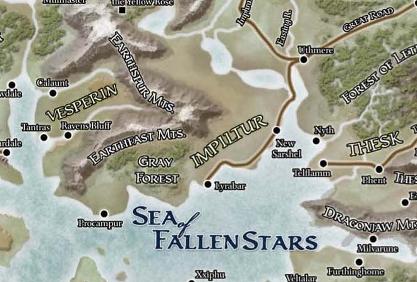
Earthspur Mountains: The imposing peaks of the Earthspur Mountains mark Impiltur’s western border. Mining communities speckle its lower slopes, spread out and around the numerous tunnels worming into its heart. The mountains were never a safe place to begin with, and now the Great Glacier’s withdrawal has led to a marked increase of monsters and humanoids drifting south.
The Gray Forest: Spreading out from the southern slopes of the Earthfast Mountains is an old and haunted forest. The ancient folks in the area claim that it was once the home of eladrin, but a terrible war with goblinoids erased both populations from the region. Now all that stands to mark that anyone lived here are circles of strange trees with gray bark and dark leaves. Even after centuries, few dare to venture into the Gray Forest for long, and those who explore its depths report ghosts, weird creatures, and odd hills that seem to appear and disappear in the woods.
VESPERIN: A young nation that coalesced from a handful of independent city-states, Vesperin is a nexus for trade, rumormongering, and skulduggery. Commerce and corruption rule this land more surely than its government. It is an exciting, dynamic place where something’s always going on. This region was once called the Vast, before the independent city-states united. The area has seen an influx of immigrants, especially the city of Ravens Bluff. Many Sembian merchants relocated here in the face of Netheril’s occupation of their homeland. A couple of decades ago, Netheril outlawed all such immigration. Sembians who tried anyway wound up dead. Gold counts for more than blood here. Vesperin is a place for intrigue and doublecrossing. With Sembia under the thumb of the Netherese, Vesperin has flourished. Here, neutrality is the rule. On the other hand, unlike in the Moonsea lands to the north, basic rules of conduct are enforced in Vesperin; it’s not quite so bloody or literally cutthroat as Mulmaster. Vesperin consists of three major cities: Tantras, Calaunt, and Ravens Bluff.
Description: Impultur is located on a large peninsula with Vesperin on The Sea of Shining Star's northern coast. It rests between The Dalelands and The Great Dale. The star of Impiltur has fallen. The retreat of the sea, coupled with widespread corruption, has led this region into decline. The people of this once-great nation huddle in fear as their kingdom unravels around them. Travel between the cities is dangerous, and plaguechanged monsters haunt the countryside. Demons bound long ago were freed when Mystra’s Weave failed, and many yet roam the landscape. Impiltur’s fortunes failed when the Sea of Fallen Stars withdrew, drying up the vibrant ports of the cities that served as the heart of commerce. In addition, the death of the last royal, King Imbrar II, during the Year of Blue Fire ended the long reign of the monarchy and shifted power to the lords of the remaining cities. Now collectively called the Grand Council, the lords have proven to be inept at rule, impotent in the face of their nation’s inexorable decay. They do nothing to combat the spreading stain of demon worship that holds Impiltur in the grip of terror. Impiltur has grown since the days of old, but not from conquest or expansion. Instead, the Sea of Fallen Stars withdrew as the water level fell, striking a death blow to the nation’s commercial power. Robbed of mercantile clout, cities such as Dilpur and Hlammach shrank, hemorrhaging citizens as the food supplies dwindled and prices rose. Some escaped to New Sarshel, the only city that proved adaptable enough to respond to the shifting climate. The countryside beyond the ragged coast remains much as it did, consisting of rolling hills climbing toward the Earthspur Mountains, where tough humans and dwarves mine gems, gold, silver, and iron. The nation still sees some overland trade, largely with Vesperin, whose own fortunes seem to rise as Impiltur’s fall. Impiltur remains a human nation. Most residents are of Chondathan or Damaran extraction, though years of intermingling have merged them into one people. Typically, Impilturan humans have tawny skin and brown or black hair. Blond hair is somewhat rare and exotic. Attractive and big-boned, Impilturans are taller and larger than humans of other lands. In the folk who dwell farther inland, Damaran features assert themselves. People fleeing from Narfell found work here as miners and farmers, so western Impilturan people are slightly shorter than the city-dwellers and have somewhat darker complexions. The mining folk are a people of absolutes, seeing as an enemy anyone who does not fit neatly into their perspective. Impiltur is also home to small pockets of shield dwarves and halflings. The halflings roam up and down the few waterways and trade with the tiny settlements that huddle on the shores. The dwarves coexist with the western humans, finding the humans’ rigid outlook and honorable customs much to their liking.
Lyrabar: Relocated Port - Population 50,000 - Lyrabar is long and narrow, stretching along the seacoast for nearly a mile. Most of its port remains high and dry, however. Newer, smaller dock facilities keep the city on the map. Lyrabar is known for its thriving community of thieves. In addition to thieves’ gangs, Lyrabar hosts several companies of demon-hunters. The adventurers regularly strike out into Impiltur’s interior, intent on bringing home a demonic trophy. Such trophies have high value here and in other countries.
New Sarshel: Port City - Population 30,000 - Because New Sarshel was able to keep pace with the retreating Sea of Fallen Stars when it mattered most, it captured a volume of trade and imports that Lyrabar and other western port cities previously enjoyed. Unlike the rest of Impiltur, New Sarshel enjoys trade from the Great Dale, and its fortunes continue to wax. Several members of the Grand Council reside in New Sarshel, including the influential head of House Marhana, the wizened and little-seen Behroun Marhana. Tavern talk has it that magic, perhaps of a sinister nature, sustains Lord Marhana’s life. All know that his rise to power occurred roughly eighty years ago, during the decades after the lowering of the Sea of Fallen Stars.
Tantras: Capital City - Population 23,000 - As capital, Tantras hosts the Golden Lords, a council of the most powerful, wealthy, and influential merchants who rule as an oligarchy. As fortunes rise and fall, people gain or lose their status as Golden Lords (a term applied to both male and female council members). Despite these changes in personnel, the council has acted in a remarkably consistent manner, providing a reliable and stable government that ensures the basic necessities of life for its people. The business and residential districts display a clear hierarchy, in the cost of items sold in shops and in the price of homes. Ornamentation and embellishment is the norm, with thin layers of gold commonly coating carriages, furniture, and even architectural features. Of course, such ostentatious displays of wealth attract the attention of unscrupulous individuals. Hence, the well-to-do hire personal guards, household militias, and even small, private armies for protection.
Calaunt :Large City - Population 32,000 - Important because of its ability to regulate trade on the River Vesper, Calaunt has become vigilant recently about pirates and raiders. A legal Writ of Trade issued from the Merchant Dukes of Calaunt or the Golden Lords of Tantras is required for travelers to pass unmolested. Nonetheless gold, connections, or blackmail can make even the questionable legal.
Ravens Bluff: Large City - Population 40,000 - Over the last hundred years, Ravens Bluff has eclipsed Calaunt as the largest city in the region. Danger, intrigue, action, and rumors abound in this adventurer’s paradise. Ravens Bluff is sweeter smelling than the tannery-scented Calaunt and less structured than Tantras, with its rigid economic social and political class arrangements. As a result, most immigrants choose to settle here. The city provides an ideal place for all manner of urban and dungeon adventures. Its cellars, sewers, natural caverns, and multiple entry points to the Underdark offer much in the way of below ground exploration.
LURUAR
LURUAR REGION
Regional Benefit - Luruar: Add one language of your choice and 2 Ranks in Knowledge (history) skill
Alternative Regional Benefit - (must be Human, any Dwarf, Orc or Half-Orc) Icewind Dale: You gain +3 cold resistance and +5 to Balance checks made due to slippery surfaces
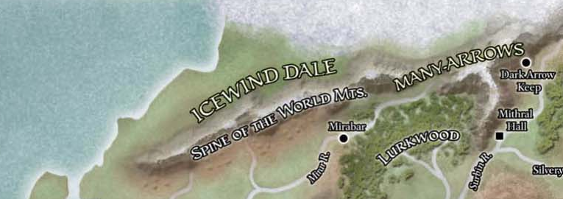
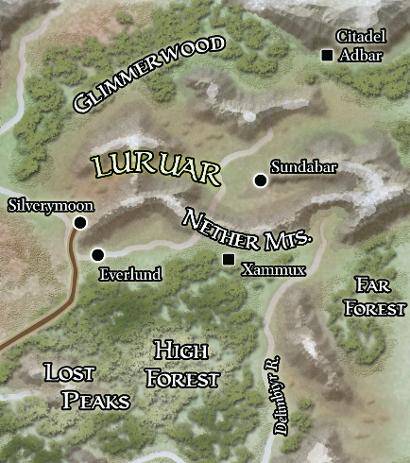
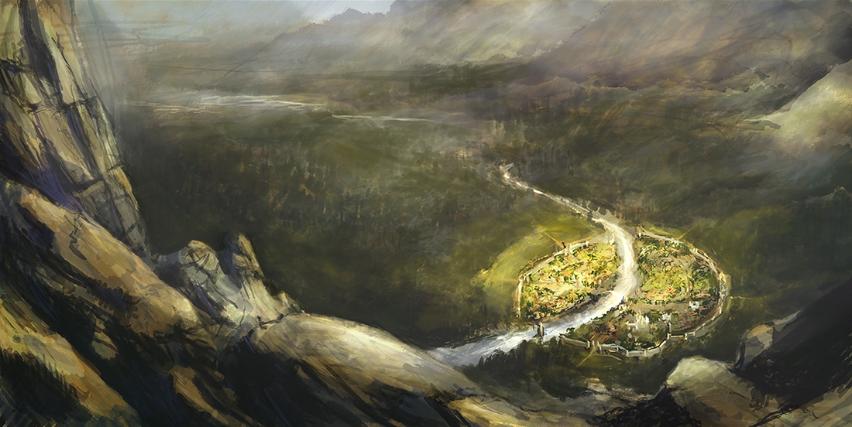

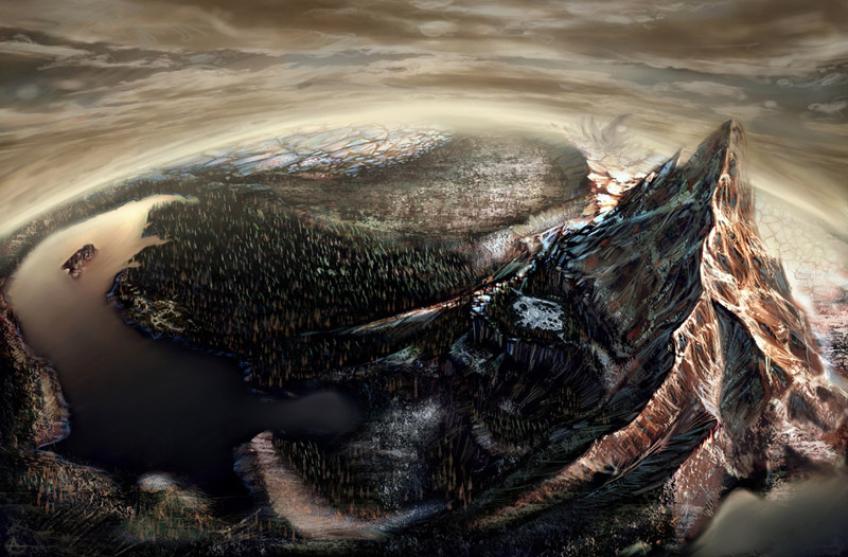
Glimmerwood: This single stand of trees is made up of formerly separate forests (the Moonwood, the Druarwood, the Cold Wood, and the Night Trees) that grew together. Orcs and Uthgardt barbarians dwell in the western and northern sections.
Nether Mountains: The past decades have seen a rise in monstrous activity in the Nether Mountains, the focus of which has been on a figure known as the Mound King. This plaguechanged wight is only one threat, however, for shades and humans from Netheril grow increasingly bold, launching raids from these mountains.
The Evermoors: Dangerous as always, the Evermoors continue to represent an untamable blot on otherwise civil lands. The growing strength of the town of Nesmé, as well as that of Luruar’s Knights in Silver, has succeeded in quashing the former troll threat, but now hill giants have run amok.
MANY-ARROWS: Amid the eternally snow-capped peaks of the Spine of the World Mountains is the orc realm known as the Kingdom of Many-Arrows. For the most part, the nation is confined to mountains through which icy winds constantly shriek. The original orc king Obould survived his now-legendary encounter with the drow hero Drizzt. He was scarred, but he took from that duel newfound strength and clarity of purpose. In the end, he united the disparate tribes of the Spine of the World into a cohesive army. Leaving Drizzt and the dwarves to their own ends, Obould sealed off the territory he had claimed in the mountains. Here and there are posted crudely written border-markers on which is written “Kingdom of Many-Arrows.” The creation of a unified, relatively stable orc society provided the other powers of the region a single entity to negotiate with, contain, or fight. Mithral Hall, the dwarven citadels, and Nesmé were tired of war and curious about the orcs attempting to become civilized. A hundred years on, the orcs have largely succeeded in keeping this local coalition of tribes together. Though the kings who ruled after Obould haven’t enjoyed his popularity, they have kept the kingdom together most of the time. The region suffered a few civil wars, and for a decade the realm was split. Since the Year of the Malachite Shadows (1460 DR), however, the orcs have maintained a single kingdom of their own. The Kingdom of Many-Arrows exists alongside the dwarves and humans of the North in a tenuous peace. These bitter enemies tolerate each other most of the time, even trading, and see occasional friendships arise. Even so, the area could explode into war any second, and has done so from time to time. The current orc ruler, King Obould XVII, continues a mostly unbroken dynastic line that began when Obould strode the North, unifying disparate tribes with fire and sword.
MITHRAL HALL: Situated between Many-Arrows and Luruar is the most famous dwarfhold of northern Faerûn. Though old King Bruenor has passed away, the symbol of Clan Battlehammer (a foaming beer mug) remains the realm’s standard. Mithral Hall’s underground expanse lies beneath Fourpeak Mountain south of the Spine of the World. A pair of massive, heavily guarded granite portals marks the main gate. The hall’s upper levels are trap-filled tunnelscapes designed to thwart invaders. The middle levels include workshops and mithral mines. Beneath those lies the Undercity, the living center of Mithral Hall. Still deeper are tunnels sealed and warded against potential threats from the Underdark.
Description: Luruar, also known as the Silvery Marches, lies north of the Gray Vale, west of Netheril, and east of the Sword Coast region of Luskan. It sits in the far north west of Faerun, with the Great Glacier ot the north. Luruar is a land of friendship and safety, a defensive league of strong, independent cities. It offers a new start for people with ruined lives, welcoming those of all races and backgrounds, as long as their intentions are noble. The past century saw several smaller forests merge into the Glimmerwood. Although the cities of Everlund, Silverymoon, and Sundabar remain strong and united, dwarven allies of old have withdrawn. The boundaries around Luruar have changed as well, with the formation of the orc nation of Many-Arrows to the north, the opening of the elven kingdom of Evereska to the south, and the expansion of Netheril to the east. The united cities of Silverymoon, Sundabar, and Everlund form a trinity of civilization at Luruar’s core. Despite the safety of the region’s cities and roads, its wilderness is dangerous. Humans, elves, and half-elves make up Luruar’s dominant population. Dwarves, halflings, and eladrin are present in smaller numbers. Although viewed with some skepticism, dragonborn, tieflings, half-orcs, and genasi also appear on the streets of Luruar’s diverse cities. Each city offers a differing degree of open-mindedness, but in general, the nation’s cities have shrugged off the prejudices that plague much of Faerûn. Enemies of Luruar include the orcs of Many-Arrows to the north, the Netherese and their puppet monsters in the eastern marches, and the nearby Underdark realms of Menzoberranzan and Gracklstugh. Before she passed away, High Lady Alustriel of Silverymoon founded a mutual defense league in the region. Her son Methrammar Aerasumé came to head a more diminished league. Methrammar has reached an advanced age, and choosing the next High Lord of Luruar is the talk of the league. Each member city has its own distinct government and traditions. The dwarves of Adbar, Mithral Hall, and Felbarr parted ways with the others, unwilling to compromise their own defenses by shoring up the smaller settlements in the area. The dwarves remain potentially powerful allies of Luruar but are not always reliable.
Everlund: Walled City - Population 23,000 - Located on the banks of the Rauvin River, Everlund is an active mercantile community. A thick stone wall is pierced in five places by the city’s gates. Like the spokes of a wheel, straight streets lead from each gate to Bell Market at the city center. City architecture was designed to accommodate the needs of trade caravans—hostelries feature stables and wagon parking, and streets are well cobbled and in good repair.
Silverymoon: Elven City of Renown - Population 40,000 - Silverymoon is the Gem of the North, a center of learning and a symbol of greatness. It is a beautiful place of ancient trees and soaring towers, with curving lines and garden plantings adorning every nook and balcony. Aerial steeds carry riders across the skies, magic and learning are revered, music and laughter echo in the streets, and the city is celebrated for its fascinating shops brimming with maps, books, art, and items of lore. Silverymoon boasts a conservatory of music, a great library, parks, and castlelike residences of noble folk. It boasts temples and shrines to such deities as Mielikki, Oghma, Silvanus, Sune, Tymora, and long-dead gods (the old temple to Mystra still stands, but now as a memorial shrine and monument to the goddess of magic). The arcane-oriented University of Silverymoon comprises several formerly separate colleges, including The Lady’s College, Miresk’s School of Thaumaturgy, and Fochluchan. The city’s army, the Knights in Silver, circulates constantly and lends detachments to the Luruar confederacy for patrols between the three main cities. Silverymoon’s famed magical wards of protection faltered during the Spellplague and have not regained their original strength.
Son of the Goat: Located north of the Moonbridge, the Son of the Goat tavern is built where its forerunner, the Dancing Goat, stood before a fire consumed it. The Son of the Goat is every bit as renowned for its raucous revelry at all hours as its predecessor. Dancing, flirting, and singing are never-ending pastimes, all fueled by a cellar boasting hundreds of vintages. Pickpockets and other professionals are drawn to the tumult.
Golden Oak Inn: This historic inn features cozy, rustic rooms, dim flagstoned passages, fragrant herbs, and pots and window boxes full of well-tended plants. All the rooms open off a central atrium dominated by a gargantuan oak that rises into the open sky. The tree’s branches are alight with glimmering lanterns, giving soft light to the tables beneath.
Dark Arrow Keep: Capital Fortress - Population 2,000 - King Obould unified the mountain orcs beneath his harsh banner over a century ago, and an orc king still rules from the same citadel. Rambling and well defended, Dark Arrow Keep is renowned for its massive weight of stone, blind alleys, crude traps, and confounding corridors raked by hidden arrow slits. From his skull-adorned, horned throne in the keep’s central chamber, King Obould XVII holds his kingdom of brutish orcs in thrall. As with all previous kings, he sometimes finds it necessary to mete out lethal punishment as an example to his chieftains. This punishment is administered in the Pit, an arena where a victim is given a sword to defend against an array of giants, monsters, and better-armored and armed veteran orcs. An orc who has seen the bottom of the Pit and lived receives a pardon.
MOONSHAE ISLES
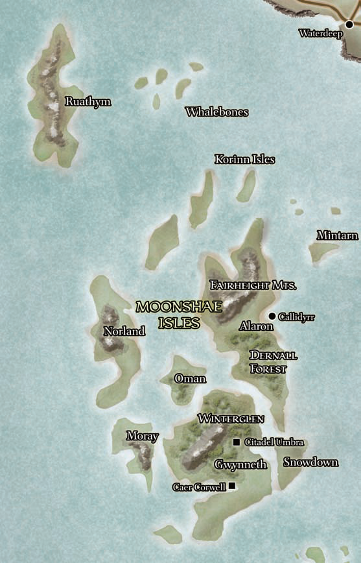
RUATHYM: This barren island lies more than 200 miles north of the Moonshaes. Ruathym is the ancestral home of the Northlanders, the savages who colonized the northern Moonshaes and Luskan. Scattered steadings and villages cluster around the isle’s fjords and inlets. The largest settlement is Ruathym, a city of nearly 6,000. Ruathym has avoided most of the tribulations visited upon the Moonshaes by interdicting all arriving ships. Luskan’s collapse has resulted in a diminished threat from that traditional enemy, and Ruathym has grown less strident and warlike.
NELANTHER ISLES: South of the Moonshaes. The Nelanther Isles spread outward from Amn and fade far out into the Trackless Sea, more than a thousand specks of land making up this archipelago. A noted haven for some of the most bloodthirsty pirates to sail the waters of the Sword Coast and beyond, these islands are no place for the unwary. Born from the swelling trade routes between the Sword Coast and southern mercantile centers, the Nelanther Isles served as the perfect launching point for piracy. From these tiny islands, fleets of pirates worried the shipping lanes, striking without warning and leaving bloody seas choked with corpses, burned hulks, and sinking ships. The raiders also struck coastal settle- ments, small towns, and anyone and anything they wanted, flaunting their power and savagery in the faces of the nations that bore the brunt of their attacks. If there was one boon from the horrors of the Spellplague, it was the sea swells that washed away much of the pirates’ presence from the isles. Towering waves and violent storms cleansed many islands of their settlements and dispersed or sank huge numbers of ships until only a few battered survivors remained. However, renewed trade between the continental nations has prompted new pirates to stalk the sea lanes once more. The Nelanther Isles lie sprinkled across the Trackless Sea. Few of these rocks are worthy of being called islands, for they are little more than jagged mounds of stone washed by the unruly seas and scoured clean by the near-constant winds. Nameless, these tiny islets cannot support life and are more hazard than haven, smashing ships blown off course or serving as grave markers for lost sailors. These visible dangers, combined with hidden shoals, vortices, and sunken wrecks, make navigating the region especially perilous. Among the isles large enough to support life, two—Ioma and Skaug—hold the only communities of consequence. The rest, if settled at all, hold remnants of old wrecks, serve as shipyards for would-be pirate lords, or are the sites of small fortresses containing all manner of unsavory characters. For most who reside here, life is a constant battle, a war against the elements to scratch out an existence far from the comforts of civilization. One can go months without seeing another ship, let alone another person. The Nelanther Isles have long sheltered outcasts from the continent and housed a large population of savage humanoids. Orcs and humans fought for scarce resources, and the proximity of their races led to a small but important population of half-orcs. One can also find pockets of lizardfolk, ogres, and a variety of other humanoid groups huddled throughout the island chain. Criminals, exiles, and freakish outcasts came to the isles to escape justice, some finding refuge among the scum in Skaug or in the mines of Ioma.
Ioma: The largest island in the chain, Ioma holds one of the major settlements in the region (known as Ioma Town). Dominating the island is a low, rugged mountain-spine whose heights hold deposits of strange purple crystal purported to safeguard those who wear it from the ravages of the Spellplague. Ioma’s industry centers on mining this strange mineral. Stone cut from the slopes is set into amulets and talismans, which are exported to the mainland through Amnian brokers. Ioma dances to distant Amn’s tune, for the town would surely die without the “generosity” of the merchants.
Skaug: A peril-filled port on the island of the same name, Skaug is a vestige of another time. It is a hodge-podge of sagging inns and lively taverns, a pirate city through and through. Filled with the leavings of other lands, Skaug serves as a retreat for exiles, out- casts, pirates, and worse. It is a reprehensible place where anything and everything goes. Pirate captains descend on the port to replenish crews and supplies, spend their ill-gotten gains in disease-ridden bordellos, and swap lies over sour ale.
MOONSHAE ISLES REGION
Regional Benefit - Moonshae Isles: Add +1 Rank in Knowledge (nature), Survival and Swim skills
Alternative Regional Benefit - Nelanther Isles: You gain +2 to AC and attack rolls while boarding a ship
Description: Off the western coast of Faerûn lies an archipelago known as the Moonshae Isles. Home to two human cultures, the druidic Ffolk and the seafaring Northlanders, the Moonshae Isles are beset by encroaching threats from the Feywild and Amnian mercenaries bent on conquest. The Moonshae Isles are dominated by six major islands—Alaron, Gwynneth, Moray, Norland, Oman, and Snowdown—and countless tiny isles. Small settlements of Ffolk or Northlanders are scattered across nearly all the isles, though the bulk of the population dwells on Alaron.The Moonshae Isles are a land apart from the rest of Faerûn, marked by towering mountains, dark forests, and ancient rings of standing stones. The realm of House Kendrick, nominally the royal family of the entire archipelago, has been reduced to the isle of Alaron. The isle of Snowdown has fallen under the sway of Amnian mercenaries, while the Northlander kingdoms of Oman and Moray have been abandoned to fomorians (a race of giants from the Feywild) and savage lycanthropes who serve the bloodthirsty beast-god Malar. The Moonshae Isles are home to two distinct cultures, the Ffolk and the Northlanders. The Ffolk embrace the druidic faith and revere the wild, untouched reaches of the islands. The Northlanders embrace a more warlike creed and revere the violent, unrelenting sea. Both cultures are fiercely independent and reject the influence of mainlanders from Faerûn. Amnians are intensely hated because of their nation’s conquest of Snowdown, while Baldurans and Waterdhavians are tolerated for the wealth their trade brings to the Moonshaes. The islands’ inhabitants see themselves as stewards of the land and sea. They are apt to be superstitious, and all manner of traditions surround the large and growing presence of the fey. Followers of Malar are hunted without mercy, but even so the insidious threat posed by the Beastlord’s lycanthrope followers continues to grow.
Alaron: High King’s Isle - Population 70,000 - Ruled from the city of Callidyrr, this island is the most powerful Moonshae kingdom. The rugged Fairheight Mountains to the north separate the traditional lowland homes of the Ffolk from the Northlanders who congregate in the realm of Gnarhelm to the north. Intermarriage has eliminated the cultural divide between the two peoples in all but name. Customs and respect for the sea and the woods are shared. The Kendrick dynasty yet rules in Caer Callidyrr, a mighty castle overlooking the sprawling port city of the same name. Derid Kendrick is the current HighKing. His most pressing concern is to retake ancestral holdings on Snowdown stolen by Amn-sponsored mercenaries, and to establish a lasting peace with the fey kingdom of Sarifal. Only portions of Dernall Forest remain tamed by the nation’s druids—the interior is a shadowy realm beset by the worst of the Feywild. Every day, battles are fought on the border. Sometimes the druids win. More often, the fomorian influence grows.Gwynneth: Fey-Controlled Isle - Population 50,000 - Gwynneth today is a breathtakingly magical place, home to a race of noble eladrin claiming to be of the same stock as the mythical fey creator race of old. Radiating outward from the shining city of Karador at the heart of Myrloch Vale, the valleys,forests, and waterways of Gwynneth are filled with lush vegetation, fantastic beasts, and the laughter of sylvan creatures dancing beneath the stars. This land is called Sarifal by some of its fey inhabitants, and humans are no longer welcome on its shores. The old human kingdom of Corwell has not existed for over a century. The ruins of Caer Corwell rest atop a rocky promontory above the terminus of Corwell Firth several hundred feet below. King Kendrick has vowed to see the ancestral home of his family restored.Oman: Giant-Ruled Wilderness - Population 3,000 - This central island was once ruled from Iron Keep, the most feared and violent of the Northlanders’ kingdoms. A brief surge in settlement following the Treaty of Oman years ago was reversed when a plague of cyclopses and fomorians burst from the Grampalt Highlands. The giants overran all colonies of the Ffolk and Northlanders, slaughtering their villages; most vestiges of civilization on the isle were overwhelmed. Today Oman is the wildest and most dangerous isle of the Moonshaes.Only fools seeking death set foot on its rocky shores.Norland: Northlander Stronghold - Population 30,000 - Norland is home to Rogarsheim, a warlike and powerful Northlander realm. The Stormbanner Wolves, unlike the Northlanders on Alaron, are culturally distinct from the Ffolk. They remain suspicious and warlike even against their long-time neighbors. Like western Moray, Norland has seen an upswing in giant activity from its southern mountains. Stalwart defense by Northlander and Ffolk settlements working together have thus far checked the invasions. Stormbanner Hold is the greatest stronghold of the Northlanders. The hold perches upon the east central coast of the isle overlooking the Bay of Norland. Norland remains a warlike realm, focusing most of its energy against Amn’s colonies in the south. Northlanders take special delight in overtaking and sinking Amnian merchant vessels that sail between Snowdown and the mainland.Moray: Lycanthrope Badlands - Population 3,000 - Moray, the westernmost of the major Moonshae islands, is infested by a bloodthirsty sect called the Black Blood tribe.Snowdown: Amnian Isle - Population 20,000 - Amn’s mercenaries and merchant houses are bent on subjugating the islands, and they’ve made a good start in Snowdown. Since the early 1400s, the Ffolk of Snowdown have been subject to Amnian law and rule from the mainland. Lady Erliza Daressin is the Viceroy of Westphal. The Amnians buttress their control through the threat of violence against members of the royal family. The isle’s resources are being consumed by Amn at a ferocious rate.Ioma Town: Mining Community - Population 800 - Ioma Town lies on the large island of Ioma, which is dominated by a mountain of the same name. A rough band of purple crystal caps the peak’s summit. Ioma Town was founded by Amn roughly sixty years ago, back when “Iomic crystal” enjoyed the reputation of having antimagical qualities. Amnian merchants made good coin selling it set into amulets and bracelets as wards against future Spellplague flare-ups. However, as wizards relearned their craft in the decades following the Weave’s collapse, Iomic crystal was shown to be nothing special. That didn’t stop the industrious miners. Ioma Town and its mine operate to this day, quarrying the purple crystal, which Amnian merchants sell as faux amethyst on the mainland. Ioma Town has become a competitor to Skaug, the other open community in the Nelanther Isles, though its port can handle only twenty ships, half that of Skaug. On the other hand, Amn’s presence in the village has brought a force of three Cowled Wizards to the island. These three, armed with a reputation and a badge of authority, keep an eye on things. As a result, visitors are slightly less likely to be stabbed in a tavern brawl. Just slightly.Skaug: Pirate Port - Population 2,000 - Skaug is a rough-and-tumble port that welcomes pirates of every stripe, and actively discourages bounty hunters and others who threaten the flow of grog and coin. Lawless Skaug is a good place to fill a ship with scurvy seadogs who value plunder over all else. Life is cheap in its alleys and ale-soaked taverns. Of all the infamous taverns along the wharf, the Keelhaul is the longest-running concern. Cards, dice, companions-of-the-hour, illicit substances, and questionable deals can readily be found within its creaking timbers. Drunken patrons sometime fling newcomers and alleged cheaters down an oiled chute. The plunging victims are ejected from the prow-fronted building and into the cold waters of the harbor outside.
NETHERIL
NETHERIL REGION
Regional Benefit - Netheril: Add 1 Rank in Knowledge (arcana), Knowledge (history) and Spellcraft skills
Alternative Regional Benefit - Sembia: Add one language of your choice and 1 Rank in Diplomacy and Bluff skills

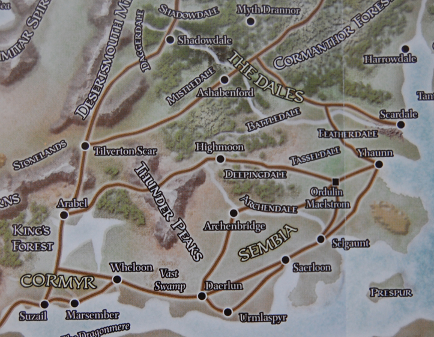

SEMBIA: Once a thriving merchant realm of independent citystates united only by a lust for gold, Sembia is now part of the growing Empire of Netheril. This long tradition of trade and commerce remains the central unifying principal for this vassal state; Sembia is Netheril’s trade portal to the rest of Faerûn. The free cities of Urmlaspyr and Daerlun are only nominally under Sembian control. After winning its war against Sembia forty years ago, Cormyr insisted that they remain neutral. The Twelve Princes of Shade claimed Sembia as a free protectorate following the disastrous civil war of the mid-1370s. In the years leading up to the Spellplague, that was the public face of things, at least. In reality, Sembia was utterly under the thumb of the Twelve Princes by the year 1380 DR, and by 1400 DR it was fully absorbed into Netheril. Shadow caravans combine the talents of the Shadovar with the mercantile genius of Sembian merchant princes. Pulled by both common beasts of burden and creatures of shadow, these caravans travel through the Shadowfell to the farthest reaches of Toril, trading everywhere—even in realms such as Cormyr where the governments have outlawed them. Because they’re not restricted by road dangers, fees, and portage costs, shadow caravans have a significant competitive edge. They can capitalize on opportunities that would take traditional caravans or shipping operations months to even identify.
Description: The Empire of Netheril has risen from the desert sands of Anauroch, a land wreathed in shadow that dominates the northern reaches of Faerûn. The floating cities of Shade Enclave and Sakkors rule the great basin between the High Ice and the Stonelands, and hold the nearby land of Sembia in thrall. It sits right in between The Dalelands and The Gray Vale.The Empire of Netheril has been reborn, thanks to the return of its residents from their centuries-long exile in the Shadowfell. Under the strict rule of the Twelve Princes, the returned Netherese, now calling themselves Shadovar, are ascendant, having defeated old enemies and reclaimed what they see as their rightful place in Faerûn. The region is growing increasingly verdant with each passing year, and its enemies remain at bay, fearful of Netheril’s potent magic but unable to contain the tendrils of shadow spread by Netherese infiltrators. Netheril is a vast and sprawling land undergoing a rapid environmental transformation. Its borders stretch from the High Ice to the Stonelands and from the Graypeak Mountains to the Desertsmouth Mountains. Four major cities have been refounded: Landeth, Orofin, Rasilith, and Oreme. Scattered through the empire are smaller settlements built atop ancient Netherese ruins or in regions with sufficient fertility to support a small population. The Netherese proudly trace their ancestry back to ancient Netheril, though in truth their culture is the product of many influences. The ruling upper class consists primarily of Shadovar, descendants of the Netherese who spent centuries in exile in the Shadowfell. The middle classes include the com- mingled human descendants of Bedine nomads, Tunlar savages, tribesfolk of the Ride, and those not of Netherese stock. The lower classes consist of krinths (humanoids descended from mixtures of humans and shadow demons) and asabis (lizardfolk who favor hot, dry climates and cool, subterranean caverns). The Netherese are proud of their accomplishments and feel that they are gradually reclaiming the land that was stolen from their ancestors. They have little sympathy for the savage tribes that over- ran their ancestral lands, and fear that those tribes seek to bring Netheril low again. The Netherese view Sembians with a measure of disdain, eyeing their commercial inclinations with suspicion but acknowledging their contributions to the Empire of Netheril. Elves and humans in Luruar, Evereska, Cormyr, and Myth Drannor are viewed with great distrust, if not outright hostility. The active worship of any deity but Shar is forbidden in Shade and Sakkors, and is only moderately tolerated in the territories of Netheril.
Shade Enclave: Capital City - Population 35,000 - This city of black walls and high spires hangs suspended by mighty magic above the Scimitar Spires. Shade Enclave is peopled by descendants of ancient Netherese wizards now thousands of years old, sustained in life by magic and a connection to the Shadowfell. Legions of dark-armored swordmages patrol the city. The Twelve Princes of old, wizards infused with the power of shadowstuff, yet lead the city as they did before it escaped the empire’s fate. Shade represents one of the most potent concentrations of arcane might on the face of Toril. It has forged an empire of incredible size and power in just a few short mortal generations. The Twelve Princes never cross each other. They are unified in their goals, or at least they present that public face. Each rules the confines of his own dark mansion much as a mortal baron oversees his community. All the princes answer to the Most High. All told, only a couple of hundred shades live in the city. Most of the Shadovar are still human. However, all have been touched by generations of living in the Shadowfell, and shadar-kai began to appear spontaneously in the generation following Shade’s return to Faerûn.
Sakkors: Resurrected City - Population 15,000 - Unlike the city of Shade, Sakkors did not survive the original fall of Netheril—it crashed into the Sea of Fallen Stars and languished on the bottom. Over a hundred years ago, in the Year of Lightning Storms (1374 DR), the Shadovar raised the ruin, rebuilding and rejuvenating it, fashioning a second city approaching the glory of old. Sakkors is built on a floating inverted mountaintop. Shadow magic is incorporated into its rejuvenated structure: Darkness twines around thin spires, over thick walls, along wide boulevards, and through the windows of shops, residences, and noble manses. From time to time, Sakkors appears over Sembia in the dead of night, apparently not having crossed the intervening distance, or at least without being sighted by anyone in Cormyr or the Dalelands. This appearance, not part of any openly discussed or official Netheril policy or promise, might be designed to create fear. After such sightings, disagreements between the Empire and Sembian merchants, if any, fade away.
Daerlun: Large City - Population 40,000 - The most heavily fortified city in Sembia, Daerlun lies inside a great fortress built while it remained under Sembia’s control. The wall was constructed to protect Netheril’s trade cities from Cormyrian influence or invasion. Shadovar magic has raised 500-foot-high walls of magically hardened obsidian around the city, the tallest curtain wall on Toril. Despite this impressive defense, Sembian control of Daerlun faltered in the face of clever Cormyrian stratagems forty years ago. Rather than becoming what it saw as a pawn of the western kingdom, though, Daerlun declared itself a free city-state. To maintain Daerlun’s independence, armies of conscripts from across Sembia drill on massive parade grounds that compete for space with a bustling marketplace and wealthy trade quarter. Patrols from Daerlun on foot and astride veserabs and griffons are often encountered in the Vast Swamp in the south, along the Thunder Peaks, and even in Sembian-controlled Tasseldale, Featherdale, and Scardale.
Saerloon: Metropolis - Population 50,000 - The port city of Saerloon is the least stable of the Sembian cities, and more prone to trouble from resistance cells, thieves’ guilds, demon cults, and other threats both petty and severe. A new Lord Governor, Haelia Johannes, was installed only a year ago with a mandate from her Netherese masters to bring Saerloon under control. She has spent the first part of her term searching out and destroying any hint of the worship of any deity other than Shar, desecrating and destroying one hidden shrine or secret temple after another.
Selgaunt: Capital City - Population 60,000 - The capital city of Selgaunt is a bustling metropolis that welcomes travelers and merchants from across the world. It is the site of the largest Sharran temple in Sembia, and something of a showplace for the Netherese overlords, who view Selgaunt as a shining example of the benefits of their divine right to rule. The Lord High Governor, the chief administrator of Sembia, is Thamalon Uskevren II. Thamalon was the first of Sembia’s merchant princes to ally with the Shadovar and has held this post for over a century. He is the public face of the very private Netherese administration. He long ago embraced the Netherese way of life, to the point of allowing himself to be transformed into a shade—the highest honor the Shadovar bestow upon their servants.
Urmlaspyr: Large City - Population 18,000 - With the exception of Ordulin, the city of Urmlaspyr suffered the most during the early days of Netherese rule. It was once known as a city of temples, where people from all over Faerûn were welcomed as friends. When the worship of any deity but Shar was officially banned by the Shadovar, the merchant princes of Urmlaspyr resisted with disastrous results. Temples and manor houses alike were razed by magical fire, and the merchant princes, their retainers, and families were stolen away to Shadow or enslaved by petty merchants and thieves elevated in status by Netherese decree. Since the city cast off its Sembian shackles, temples and merchant manors have returned but have yet to achieve their former status. Reminders of Sembian control yet remain. Parts of the city are still haunted by shadow creatures, and a blanket of clouds conjured by a Netherese archwizard seventy years ago perpetually hides the sun despite the best efforts of modern magecraft to remove the blight. Trade goods flow again through Urmlaspyr’s ports since Cormyr enforced its edict that Urmlaspyr remain free. Indeed, a contingent of Purple Dragons, on loan from Cormyr, is posted in the city to guard it from peril. Of course, the true threat to Urmlaspyr’s independence is more likely to be hidden machinations than open assault.
Yhaunn: Large City - Population 25,000 - Constructed on the remains of a once-rich mineral quarry, the port city of Yhaunn was ravaged by the Spellplague. The resilient Sembians, with magical help from their Shadovar overlords, made the most of the uncanny changes that the Spellplague brought about. They have adapted so well that the city has grown from its pre-Spellplague population, even though nearly ten thousand were killed when the towering cliffs of stone on which its wealthiest districts were built broke away and became earthmotes. Where once the city’s wealthiest citizens competed for status by building their mansions higher and higher on the quarry walls, now the ultimate status symbol is to live on the highest of the three dozen earthmotes that comprise Yhaunn’s Air District.
THAY
THAY REGION
Regional Benefit - Thay: Add the higher of your Intelligence score or your Con score modifier to extra HP
Alternative Regional Benefit - (Human only) Hordelands: Add +1 to attack rolls, including damage rolls, with shortbows when elevated above target or mounted on a horse
Lake Thaylambar: Freshwater Lake - This deep, icy lake is the site of rich fishing and dragon turtles. Necromancers created more than one undead dragon turtle from those slain in the lake. These creatures serve Thay’s navy in Lake Thaylambar, the Alamber Sea, and Lake Mulsantir.
Plateau of Thay: High Desert - The edges of this highland now largely define the borders of Thay. Rough canyons and mountains form a tableland averaging 9,000 feet in elevation. High Thay rises in the northwestern part of the plateau, to about 11,000 feet. Most prominent in High Thay is the volcanic Thaymount, the tallest peaks of which tower over 22,000 feet. Cracked badlands, dotted with alpine meadows and divided by broken roads and winding rivers, make up some of the highland. Many settlements razed by Thay’s upheaval still lie in ruin in these areas. Other places are settled, magically protected and manipulated to produce crops and livestock.
Tax Stations: Fortresses operated by the Dread Legions dot Thay, especially along routes that offer the easiest travel. These keeps, called tax stations, watch the roads and charge a small fee to pass through. They keep watch for unauthorized intruders and escaped slaves.
The Citadel: Capital City - Population 10,000 - This ancient bastion of basalt is the seat of Szass Tam’s power. Seated on a peak about 18,000 feet high and located in blasted volcanic lands, the Citadel is difficult to reach by overland travel. Tunnels far under the fortress function as roads into its bowels. Nobody comes uninvited to Thaymount, much less the Citadel—and many who are invited wish they hadn’t been.
Zulkir Council: Szass Tam’s vassals, the zulkirs are the most powerful arcanists in Thay. All the zulkirs on the council are liches, and most of them practice some form of necromancy. These seven advise the regent but are obedient to his will. Each also acts as a steward over certain domestic duties. But the zulkirs can’t be bothered with the day-to-day needs of Thay’s territories (tharchs), so a chain of governors (tharchions) and bureaucrats (autharchs) see to such tasks. The zulkirs maintain private fortresses scattered over the Thaymount. Treacherous roads and tunnels connect them to the Citadel and one another. Together with the Citadel, these strongholds hold most of Thay’s military reserves.
The Dread Legions: Composed of undead, as well as gnolls, orcs, and other subjugated monsters, the Dread Legions are Thay’s armies. Although this force serves a primarily defensive purpose now, it stands ready to threaten any of Thay’s neighbors. Evidence of the legion’s efficacy stands in the form of Undumor in Aglarond. Szass Tam sometimes dispatches elite units of the Dread Legions to other lands for his own purposes.
The Alaor: Contested Island - Population 25,000 - In the power vacuum following the failed zulkirs’ revolt, Thay has retaken a portion of the Alaor. Thay’s ships array themselves between this isle and the city of Bezantur. Both places serve a military role. Thay has no allies or trade partners, though it seeks influence among the pirates on the Sea of Fallen Stars.
THE HORDELANDS: A vast, rolling tundra and steppe of short grass, sparse water, and fewer trees, the Hordelands truly earns its other name—the Endless Wastes. Severe winters, dry summers, poor soil, and frequent violent storms make the land unsuitable for large settlements. Raumvirans, descendants of ancient Raumathari, are common around the Lake of Mists and west of that area. Most natives of these plains, however, are horse-riding nomads called the Tuigan. In truth, Tuigan is the name of a single prominent tribe—people of the Endless Wastes are divided among fifteen wandering tribes that each range widely within their traditional or newly claimed territories. They live in tents and move frequently to survive, letting their tough steppe ponies forage on the sparse vegetation. The Tuigan feed on livestock, horse milk, and the creatures they hunt with uncanny skill using ordinary shortbows.
The Golden Way: Trade Route - The Golden Way runs from the city of Telflamm on the Easting Reach, through Thesk and Rashemen, around the Sunrise Mountains, across the Hordelands to Kourmira, and then all the way to Shou Lung. Instead of a proper road, the Golden Way is a series of stone markers, each visible from the last. These markers make it easy to locate oases and caravanserais along the way.
Lake of Mists: Named for the fog that constantly enshrouds its surface and the surrounding lands, this lake is the largest body of fresh water in the Hordelands. It was once the center of civilization in this area, but during the Spellplague, long-quiescent Raumathari magic sprang to life. The lake boiled over its former shores, a tornado-spawning thunderstorm churned over the area for more than a month, wind and fire consumed much of the woodlands along the lakeshore, and the trade town Almorel disappeared into a quake-born fissure. Once the bedlam had subsided, the basin of the lake had changed, and all the settlements it once fed were gone. The Lake of Mists is now home to elemental creatures, mischievous fey, monsters, and animals. Still, its waters are said to be warm and so pure as to be healing. The Golden Way passes close to the lake, and hardy settlers have returned to parts of its shores.
Description: Beneath skies of ash and cinder lies the broken landscape of Thay. Situated east of Aglarond and Thesk, and south of Rashemen in the eastern lands of Faerun. It rests atop an elevated plateau, with The Hordelands to the north and east (the Plateau of Thay is just west of Uzbeg and the Lake of Mists on the map above) and Murghom and High Imaskar to the south. A forbidding place, much of Thay consists of badlands, deserts, rugged mountains, cinder cones, and active volcanoes that belch forth plumes of toxic steam and rain flaming debris on the lands below. Under the tyrannical rule of Szass Tam, the undead are the masters of Thay. Where life exists, it suffers terribly in the form of slaves, playthings, and chattel to be sacrificed, sold, or remade into undead thralls. Thay harbors the largest population of undead in Faerûn. Wealthy and powerful individuals often join Szass Tam’s new order in undeath. Conversely, an undead slave won’t rebel or easily die, and doesn’t have to be fed. Thay’s living citizens have a hard existence. Red Wizards were once purveyors of magic items across Faerûn. However, civil war and the Spellplague spelled the end of Thay as a mercantile power. Where the Red Wizards were unpopular, the upheaval left their enclaves open to attack and destruction. Luckier Red Wizards were often cut off from their homeland. Many decided to stay abroad rather than return to a Thay ruled by Szass Tam. The people of Thay still refer to the arcanists among them as Red Wizards, and only such mages are allowed to wear red within Thay. The nation of Thay sprawls across a great plateau, thrust up from the ground. Its sharply defined borders are ragged ruins, tumbling falls of stone and debris where the raw earth bleeds poisonous gas and rivers of lava. The roads are lined with traitors who have been left to rot in crow cages or impaled on great spikes, their bodies writhing in agony as fell necromantic energy transforms them into dutiful servants. Rising above it all is the fiery Thaymount, a spine of broken peaks and volcanoes that ride the devastated landscape and house the lord of darkness. Undead are the most numerous creatures in Thay, but the region also contains a fair number of gnolls, orcs, and humans. None of them has much love for the others, but all fear the wrath of the Citadel enough to set aside their petty squabbles. They all fill a variety of roles, from wretched slaves and gladiators to selling their lives cheaply in the ranks of the Dread Legions. Among the humans, the lowest classes—the laborers, farmers, and slaves—are almost wholly of Rashemi stock (from the nation of Rashemen to the north), whereas the ranking aristocracy, including the infamous Red Wizards, consists almost exclusively of the Mulan peoples. Rashemi slaves cleave to the same sorts of customs and beliefs found among their kin in other lands. The Mulan humans are distinctive, being tall and slim, with sallow skin and no hair anywhere on their bodies. It is their custom to remove body hair and replace it with intricate tattoos depicting dragons and, more commonly, demons and devils. One can also find tieflings, dwarves, halflings, and other races in Thay, but in almost every case, they serve as slaves. Their fate is grim and their lives short.
Eltabbar: Former Capital City - Population 100,000 - Whether by miracle or design, the former capital of Thay survived the changes to the land, as did Lake Thaylambar to the city’s north. The River Eltar flows through the city and a series of elaborate canals into the nearby lake. When the zulkirs must handle affairs of state by dealing with human vassals, they do so in the Council Hall of Eltabbar. Tharchion Sylora Salm oversees the city. Recently handpicked by Szass Tam, she also sees to the needs of visiting zulkirs. From Eltabbar, Sylora also oversees the lands north of Lake Thaylambar and the Thaymount. Magic controls the volcanic ash and smoke, as well as moderating weather in parts of this area. Limited agriculture there supports Thay’s living citizens.
Uzbeg: Village and Inn - Population 500 - A fortified caravanserai situated along the Golden Way is a welcome sight to travelers. Uzbeg, near the Lake of Mists, is the largest along the route. After the Lake of Mists swallowed many settlements during the Spellplague, Raumvirans established this town with help from merchants from Thesk. A scrupulous and industrious Raumviran woman named Taimurel now heads the place. Uzbeg has a sterling reputation. Trade, information, and travelers moving up and down the Golden Way support its economy, and explorers interested in the Lake of Mists use Uzbeg as a base. Brave fisherfolk make up the majority of the citizens here. Four structures, two on each side of the Golden Way, stand in Uzbeg’s center. Each building is a walled square surrounding a courtyard accessible through a single gated entrance large enough to permit a horse-drawn caravan. Though the courtyard is open to the elements, the inner and outer walls form a cavernous hall suitable for sheltering animals and wagons. Stables, rooms for sleeping, a tavern, and vaults for valuables are also located inside. Each courtyard contains a central well that provides water, and tent shops that offer various wares. Uzbeg merchants sell mainly travel supplies at a number of stalls. Other traders come and go depending on the particular mix of merchants currently in residence and their willingness to sell to or trade with others.
VILHON WILDS
VILHON WILDS REGION
Regional Benefit - Vilhon Wilds: Add 1 Rank in Survival skill and gain +1 to Initiative checks
Alternative Regional Benefit - Erlkazar: You gain +1 to all attack rolls made during the actual night (not under magical darkness or other forms of false night)
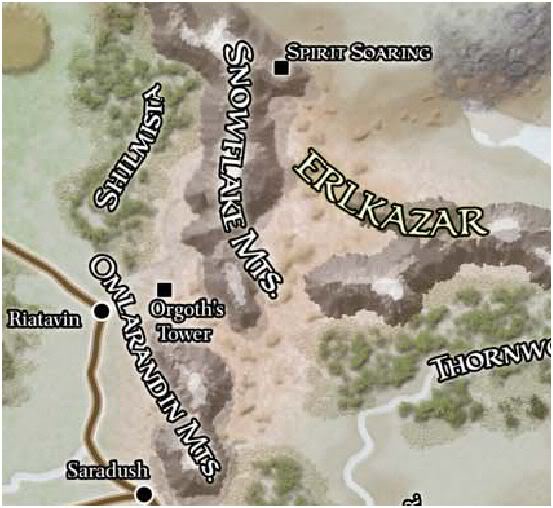
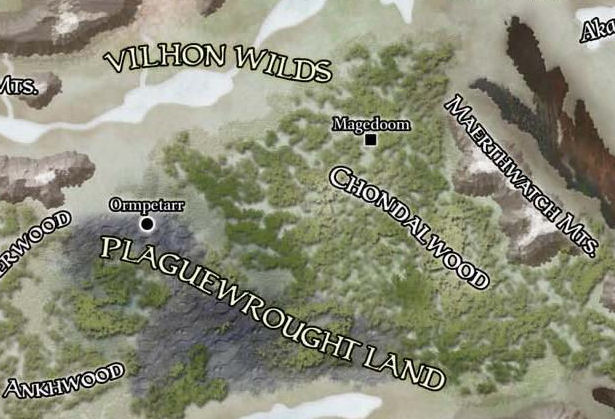
Chondalwood: The vast and expanding forest is a riot of verdant plant life given unnatural vigor by the transforming Spellplague. Bands of spellscarred satyrs and elves roam the Chondalwood, as do all manner of horrific plant creatures spawned by the nearby Plaguewrought Land. At the heart of the Chondalwood lies a small kingdom of wood elves known as Wildhome. Fiercely xenophobic, the elves do their best to destroy anyone who comes too near their homeland.
Plaguewrought Land: Permanent Plagueland - The Spellplague is still active in this territory, contorting terrain, natural law, and the flesh of any creature that dares enter. The surreal landscape is breathtaking in its beauty, grandeur, and changeability. Earthmotes aplenty break up the sky in a strange parity with the fractured terrain below. Swaths of moving earth change with mercurial speed, and great ravines empty directly into the Underdark. Spellscarred individuals and scar pilgrims sometimes journey here because it’s the most prominent plagueland in Faerûn, as well as a great hold of the Order of Blue Fire. The stability of the plagueland’s border provides an environment where the clever, ambitious, or insane can experiment with the Spellplague and its effects. The Plaguewrought Land is now part of the landscape, and natives have adapted. Some humanoids have tailored their coming-of-age ceremonies to include a venture to the edge of the plagueland. Mystics travel here to seek answers about the universe or about themselves, sometimes coming face to face with a sharn or receiving visions of the Masters of Absolute Accord. Artists who yearn for inspiration and experience come to shape their masterpieces. Shamans seek guidance, saying the land talks to them. Mages conduct experiments in hopes of learning arcane secrets. The Order of Blue Fire facilitates all this through its public works branch. The group also helps creatures that wish to brave the mortal dangers of the Plaguewrought Land in hopes of gaining a spellscar. In Ormpetarr, those who attempt such a feat are said to be on a scar pilgrimage. As with most who brave plaguelands, few pilgrims who enter are ever seen again, but those who do return sometimes claim new-found power.
ERLKAZAR: The Baronies of Erlkazar are home to a small population of simple folk scattered through tiny, pastoral villages. Such peace is presumably maintained by the Baronies’ relative insignificance and proximity to the Vilhon Wilds, though stories tell how this sleepy, out-of-the-way place was once harried by gangs of bandits. Those marauders are gone, or at least they no longer bother with Erlkazar. Instead, border regions of Calimshan, Tethyr, Amn, and Turmish are victimized by midnight raids from a well-organized bandit army. No one knows where the bandit army is based—no sign of the night raiders appears in idyllic Erlkazar. From time to time, adventurers trail bandit raiders from surrounding lands to Erlkazar, where they find only peasant villages, incapable of hiding anything the size of the army they were after. The simple townsfolk are welcoming and friendly, and are bewildered if asked about a raiding army. After sunset, however, the villagers lock themselves in their houses, and nothing can convince them to go out at night.
Day Baronies: Daylight Realm of Pastoral Villages - The Day Baronies are small, peaceful, and remarkably stable, having changed little in decades. The villagers get along wonderfully and are never menaced by outsiders. In the dark of night, though, they don’t leave their abodes and don’t want to know what goes on outside.
Ahlarkhem: A small collection of pastoral fishing villages. Ahlarkhemites are the most nervous people in Erlkazar, and rarely speak to or make eye contact with visitors.
Carrelath: Unlike the rest of the realm, Carrelath is populated mostly by dwarves. More and more they have tried to distance themselves from the rest of Erlkazar. They look to the Baron of Impresk as a possible ally to one day drive the fear out and restore the peaceful kingdom to its old ways.
Impresk: The northernmost barony, Impresk is the least stable of the Day Baronies. One of the Day Barons, Tolarran, is a young and ambitious leader.
Shalanar: The seat of the former king, Shalanar has become the least important of the five baronies. The city of Llorbauth has shrunk from a population of 28,000 to fewer than 10,000, and the citizens have gone back to the land, working small farmsteads or gathering in tiny thorps of fewer than a hundred souls apiece.
Tanistan: The least populated barony, Tanistan is farmed by a few toughened folk who make their peace with the night through strong drink.
Description: These lands lie south of Turmish and The Dragon Coast. The untamed lands formed by the draining of much of the Vilhon Reach and the destruction of Chondath are known as the Vilhon Wilds. Wracked by the Spellplague and the continuing threat posed by the Plaguewrought Land, the Vilhon Wilds is a true frontier. The Spellplague drained much of the water of the Vilhon Reach and unleashed the Plaguewrought Land upon the region. Like other frontiers, the Vilhon Wilds is an ungoverned wilderness. The only vestige of civilization is the small, near-lawless city of Ormpetarr, where merchants and thieves prey on pilgrims who seek something from a visit to the Spellplague-riddled land nearby. The Vilhon Wilds lies in a verdant valley carved by the diminished Vilhon Reach. The Chondalwood has swallowed much of this region, as has the Plaguewrought Land to the south and west. The remaining inhabitants of the Vilhon Wilds are deeply affected by the Spellplague and its aftermath. For the plaguechanged and the spellscarred, the effect is readily apparent. The magic of the Spellplague or the lingering effects of the Plaguewrought Land have transformed them into something else entirely. For the rest of the inhabitants, the effect is more psychological than physical. Some consider it an opportunity for insight and are drawn to the surreal landscape like a moth to a flame. Others find the aftermath of the Spellplague a nightmare to be suffered, battled, or fled. Regardless, denizens of the Vilhon Wilds care little for events in the outside world, as the formidable landscape deters any thoughts of conquest by other nations. The residents change constantly; the dangers of the region inflict a significant toll on the population, which is replenished by the steady flow of pilgrims from other lands. In the Vilhon Wilds, it is an unwritten rule that you never ask where someone comes from, and everyone starts with a clean slate. For some, the region is a chance for a fresh start. For others, it is a place to hide. The Vilhon Wilds is a frontier unclaimed by any state, containing the wreckage of cities devastated by the Spellplague, separated by rough open country and plaguelands. It includes the partially drained estuary of Vilhon Reach and the strip of land formerly called Chondath on the edge of the Chondalwood. The notorious Plaguewrought Land lies close by, which means the entire region is unsafe at best.
Ormpetarr: City of the Scar - Population 4,000 - This is a city of merchants and road agents who prey on, or, as they prefer to say, cater to pilgrims, mages, alchemists, mystics, and adventurers seeking to explore nearby ruins. No other state or authority claims Ormpetarr. The Order of Blue Fire maintains its most prominent edifice, the Changing House, in the town. Its agents, important to local governance, help maintain order where the only other law is a rough brand of frontier justice. A popular place in Ormpetarr among would-be scar pilgrims is an inn called Finara’s. The inn offers reasonable rates for clean rooms above a large tavern to anyone on a scar pilgrimage. The elderly owner Finara was also a pilgrim, but the one time she approached the Plaguewrought Land, the horror of it forced her to flee. With her advanced age, it seems unlikely she will return. She does point people to the services offered by the Order of Blue Fire, of which she is a fringe member.